Allow me to read to you from one of my favorites, Daphne Du Maurier’s Gothic novel, Rebecca: “Last night I dreamt I went to Manderley again. It seemed to me I stood by the iron gate leading to the drive, and for a while I could not enter, for the way was barred to me. There was a padlock and a chain upon the gate. I called in my dream to the lodge-keeper, and had no answer, and peering closer through the rusted spokes of the gate I saw the lodge was uninhabited.”
My beloved grandmother had suggested Hitchcock’s film adaptation when I was much younger. As if I wasn’t already bewitched by all things long ago, Rebecca would further lure me astray and soon after I would retire from the modern world in my mind. For Rebecca’s mysterious introduction was one of the best entrances to The Bygone I had ever found. At times I wished I could have pulled the portal door closed behind me. Du Maurier’s main character, the second Mrs. de Winter’s magical debut describes floating as a spirit through the wrought iron barrier, up the winding drive, only to discover Nature has taken over the once glorious mansion of Manderley. This idea of being under the spell of a home, a large estate with a proper name…Manderley, no less, held me as a young reader. Of course, Rebecca herself, haunts the main character but it is interesting that the Manderley mansion and grounds Called to the curiously nameless main character in her dreams.

When I muse on Rebecca and the all-possessing power of a home, an enshrouded, alluring estate of local lore comes to mind. For it seems to me that Omaha has its own Manderley—a mysterious, abandoned, brick mansion traced in a high, proud wrought iron gate complete with leaning lanterns. This sprawling estate continues to pique the curiosity of many a sleuth in our town decade after decade, long having inhabited the south side of 93rd and West Dodge Road. Although in full view, she is an elusive one with all of the compelling trappings of a great mystery novel or a sensational Victorian piece. Everything about 9301 West Dodge Road whispers, “Privé…”
I submit the following as intriguing literary evidence: a locked entrance gate for as long as anyone can remember. A winding brick drive leads a lonely path up to a wide, contented Georgian estate, a mossy mansion untouched by human hands in recent decades. Never a car. Never as much as a late night kitchen snack light. Only the massive trees are proudly reflected in her expansive, well-balanced windows or are those the trees clean through to the other side of the home? A curious, eye-catching churchlike addition to the brick residence extends a large, white cross. Strange, improvised pieces of lumber were long ago fashioned to conceal what might have once been proper signage at her perimeter entry walls. These very walls oddly extend to perpendicular 93rd and 94th Streets, almost as if this palatial home offered (or concealed) a gated community or a compound entrance.
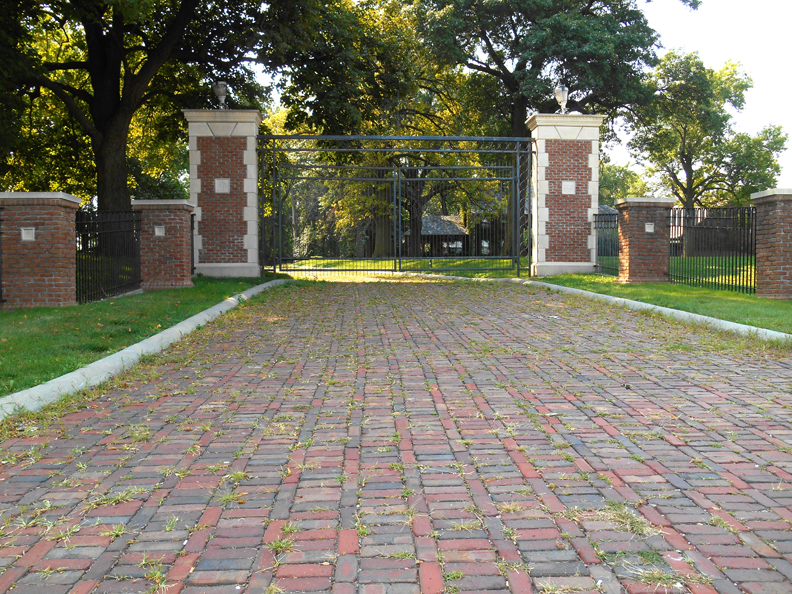



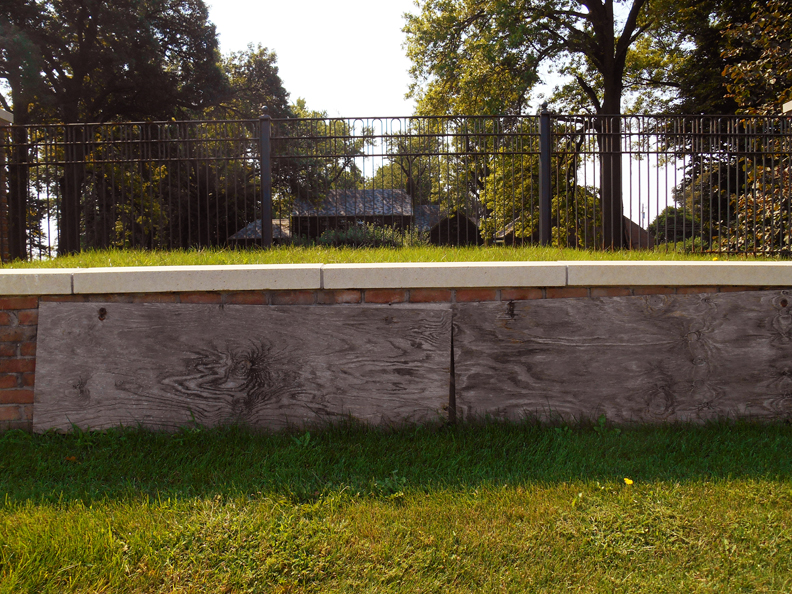
These photos were all taken in September of 2015, before I started the website.
I fear I have shown bad form, having charged ahead to preemptively subject you to her quirks and oft-pondered clues, all for the sake of establishing a mystery. For these qualities are not her sum total, in fact, merely her idiosyncrasies. Honestly, she wasn’t always This Way. Ask any child of 1960s through the 1980s, without reference to a map or address, 9301West Dodge Road was once one of the most aesthetically satisfying and dream-making landscape experiences in all of Omaha. One might think I am exaggerating her finer points but I believe we have all become a bit jaded…and forgetful. Remember driving through the 84th Street train tunnel and seeing the Satellite Motel on L all lit up at night? True thrills, I say! 9301 was in these ranks. Her finely wrought sweep of lawn was a presumed football field or professional kickball park. Her imagined set of gardens hosted many a conceived dolls’ tea parties, rounds of hide and go seek and couldn’t we all picture the intricate, charmed tree houses in those distant woods? This high-minded, palatial residence was magical—quite unlike our own small, simple houses and opened our collective eyes to define what enchantment could be. The long suffering journey to Westroads Shopping Center was made special by a quick, twinkling glimpse of this fairy dust residence, strangely situated on the margins of Dodge. Father Cassette informed me from the front seat of the family automobile, there used to be a few large houses along West Dodge and I had assumed this imposing home remained a vestige of that glorious, shadowed time. 9301 West Dodge Road was once, and remains in part, the kind of residence one holds their breath while passing, for this fragment of architectural splendor integrated with a large, wooded, park-like lot scarcely exists in this day and age. Or even back then.
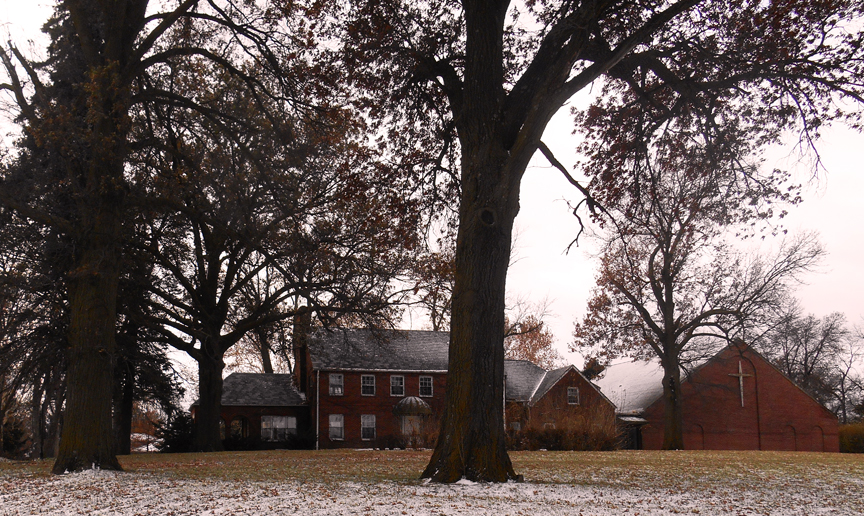
Fall of 2018.
I know I am not the only one to walk hushed and enchanted up to this gated guise. In a strange, shushed calm I found Omaha’s Manderlay still conscious. The living, breathing, mystery mansion was much more than an empty shell, for every good house and garden has a soul. I would place social call after social call to her iron bars for this investigation; she endured my obsessive drop bys with grace, as only a grand dame would. I hung on her every word. It became an emotional experience for me, even now. How long had it been since doting hands had tended the lost garden or swept the grand entrance? Where were the once famous twin oaks arranged in her landscape? Would I catch a glimpse of a face in the window? The sheer expanse of her grounds, the architect’s scale and composition, the manner in which the home was haughtily disposed, back from the common road, every care was taken. She seemed to make known she was never meant to be a part of a suburban neighborhood. Likewise she was not a carefree country home either. She was removed from all of that. Had she been the grand manor house to all of the surrounding area? The reality that 9301 is now surrounded by Mid-Century Modern homes, commerce and steely corporate buildings is a peculiar phenomenon but one that she seemed to find neither here nor there.
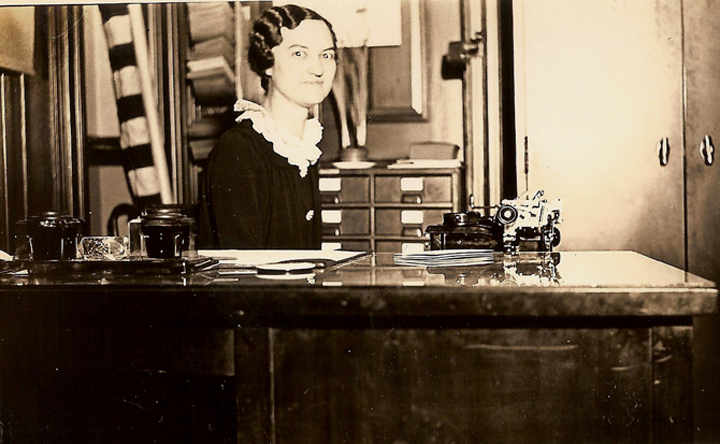
I had intentionally filed “9301 West Dodge Road” in my Pre-My Omaha Obsession folio back when I laced up my early schemes of a website. I knew she was a mystery needing solved but as I began attempts to unravel her story, I felt disheartened, if for no other reason but the endless snaggily hitches of it all. For I didn’t know much when I began and I suppose even you snickered at my simple sleuthing attempts. But I have grown and although no expert private detective, I have learned a trick or two that permitted me to revisit the examination of 9301 West Dodge Road.
Part One
A View of the Guise
Outward appearances can be deceiving but I suppose I do like being strung along in some ways. I am hoping you do too. I had no real clear prediction of how old the brick home of my childhood dreams might be, for she simply Always Was. But now it seems this Miss Cassette character works to be a bit more precise than Always Was. The classic, balanced architecture of the main house gave an air of the 1920s or even semblance of a fine 1900s Georgian estate. I had learned quite a lot through my other Loveland, Balla Machree and 96th Street West Omaha Country Home adventures to speculate 9301 must have been from the early suburban automobile period. The Douglas County Assessor pinned her construction date to 1941, which seemed later than expected but I took note all the same. I would continue to bump into the fine Thomas Walsh family name, stubbornly thinking this well to do attorney and his socialite wife and daughters were the original owners of 9301. Their property was encompassed within the Westchester Addition, however the neighborhood’s plat was not officially filed until August 30, 1951. These were the Incidental Nightmares that drove me to hand wringing early on. (We will return to this gracious family when they genuinely entered the storyline, or I should say, when they chronologically entered stage right.)
As it turned out, the home, and of course, land had existed long before the neighborhood was “developed” around it and its deed actually “came from lands”—strange Deeds Office jargon for the books housing the public lands system. You have heard me sulking about the Township, Range, Section method of property delineation. Confounding. Also worthy of attention–the home’s address would evolve from 9300 Dodge to 9301 Dodge to 9301 West Dodge Road over the years and other times it was incorrectly logged altogether. There was also a snaggle in that its address was not found in the directory and I didn’t know the owners’ names to look them up. Dare I say these curves in the road all seem amusing now although they fidgeted at me for far too long. It was a lot to drink in. It might very well drive you to the drink as well. On this night, I will spare you the details of my early trials, as we’ve got many decades to traverse and you can trust I will plan to get us plenty lost in other trivial matters of utmost importance. Hopefully you are alone and you’ve no place to be, for we need to dream.
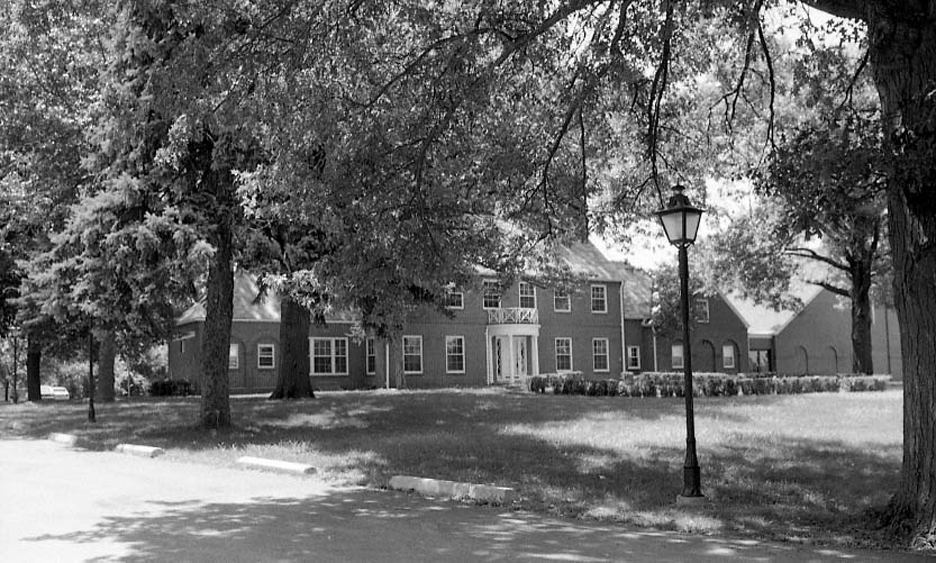
Fantastic City Planning Department photo of 9301 West Dodge Road, shared by Trina Westman years ago, previous to her resignation. Thank you, Trina! Photographer unknown. Photo-623-29, which I assumed was taken on a 1980s or 1990s city reconnaissance survey, was mislabeled as “9304 West Dodge Road.” Dismally the department has no historic record of the structure, although this photo gives some nice details, now absent.
Overview and a Bit About Roads
The Google Map from 2018 allows one to see the dense upbuild surrounding 9301 West Dodge Road. Some detectives who gather here no longer live in Omaha and I believe a map with permit us to gather our collective bearing. Now some of us don’t like maps and silly tools and might want to rush on ahead. But I assure you, these will be the same dear friends who get confused later and for that reason, we will just leave these maps here for when they need to discreetly backtrack.
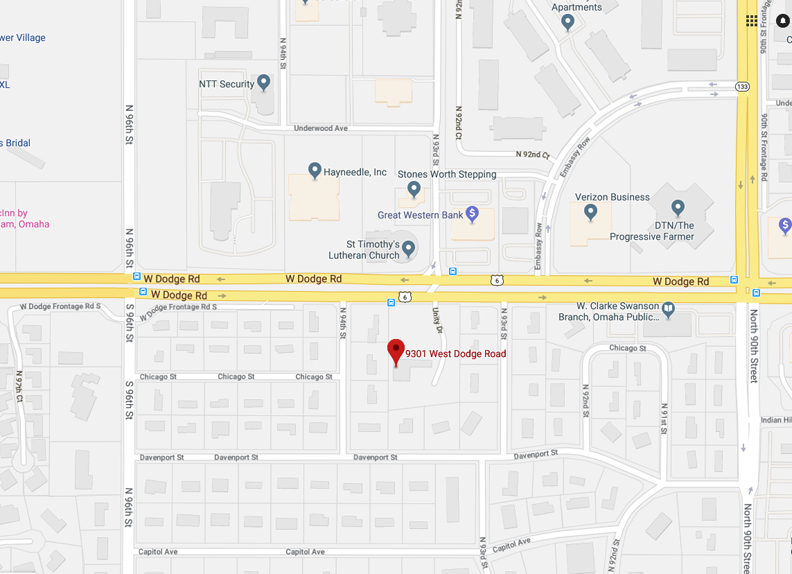
2018 Google Map. This image is borrowed from the Google Map website. Note the private road onto the 9301 estate is labeled “Unity Drive.”
A quick survey at the Douglas County GIS map will get you acquainted with the property lines of 9301 West Dodge Road, the surrounding lot lines and their addresses.
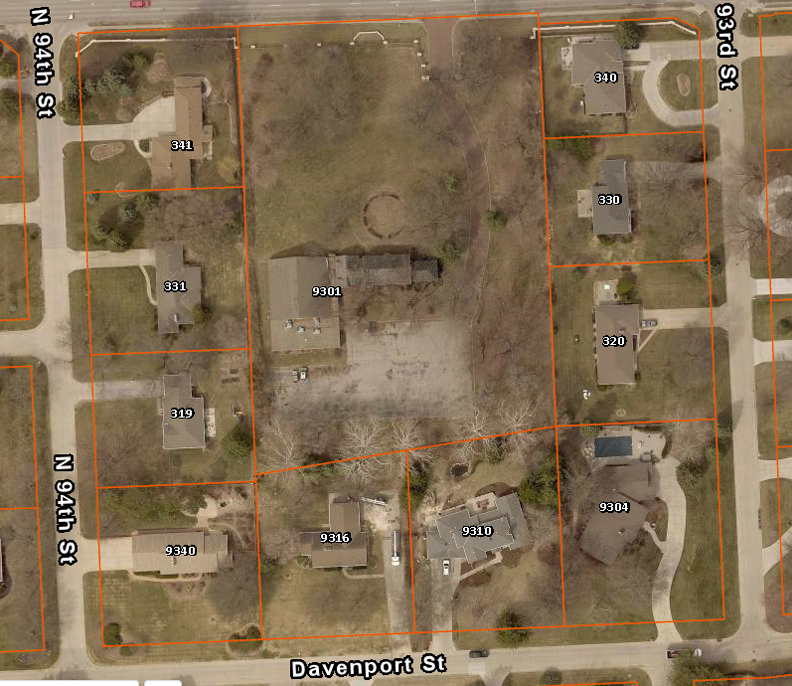
2018 DOGIS photo. Aerial map photo borrowed from the Douglas County/Omaha GIS Department website.
Dodge Street is the main east-west thoroughfare of Omaha, the auspicious dividing line between north and south addresses in our fair town. Dodge begins at the eastern river and continues west, until strangely at west of 78th Street, it merges with Cass Street and the even stranger West Dodge Road. Why? (The Real) Dodge Street comes to a screeching halt at 84th Street. Meanwhile poor Cass gets completely overrun and also ends abruptly. West Dodge Road continues on to even more complication when it steps up to the West Dodge Expressway just west of 96th Street. My favorite Streets of Omaha: Their Origins and Changes by H. Ben Brick couldn’t offer much more. The original, historic “old” Lincoln Highway also traveled in alignment across Dodge Street in the early teens.
The West Dodge Trend
After some scurrying through the archives, there was mention of paving West Dodge Road as early as 1890. By the very early 1900s West Dodge Road was apparently dotted with acreages, fine country houses and prosperous families’ “summer homes.” These were the kind of romantic properties that were given names–and such fascinating, dreamy names they were christened! Due to the perceived Dirty Downtown environ, a few wealthy businessmen were moving their families Out West, some insisting they were “getting their children out of the city.” When speaking of this westward trend in country home life, W. S. Wright explained, “The business cares and responsibilities that used to go home with me and cling to me through sleepless nights, vanish like thin air when once I strike that West Dodge Road and see my home in the distance. The interest we take I the improvements in the selecting of flowers, of shrubbery and in the arrangement of the lawn, banishes every business care from my mind and gives me a new and refreshing point of view. A business man has no business living anywhere but in the country.” By the early 1900s there was a distinct movement in larger cities Back to the Country. Out of necessity many older cities were located near navigable waterways and as is the case with Omaha, the Downtown soon became a thriving, however congested, district filled with homes, industrial factories, businesses and schools alike nestled shoulder to shoulder. The regular folks could hope to find the public parks and “vast breathing spots that afford some solace and comfort” as a respite to the sheer density of it all, whereas the wealthy wanted a picturesque view and clean country air for themselves. In the words of Omaha businessman, Thomas D. Crane, “I am an agriculturist, not a farmer. Let me explain the difference so you can tell them apart. An agriculturist makes his money in the city and spends it on the farm. A farmer makes his money on the farm and spends it in the city. We moved out on our place last summer and I never spent a happier summer in my life. My man drives me in the car and it takes just forty-five minutes from the time I leave the office to get home.” For the record, the Crane’s country home was in Florence.
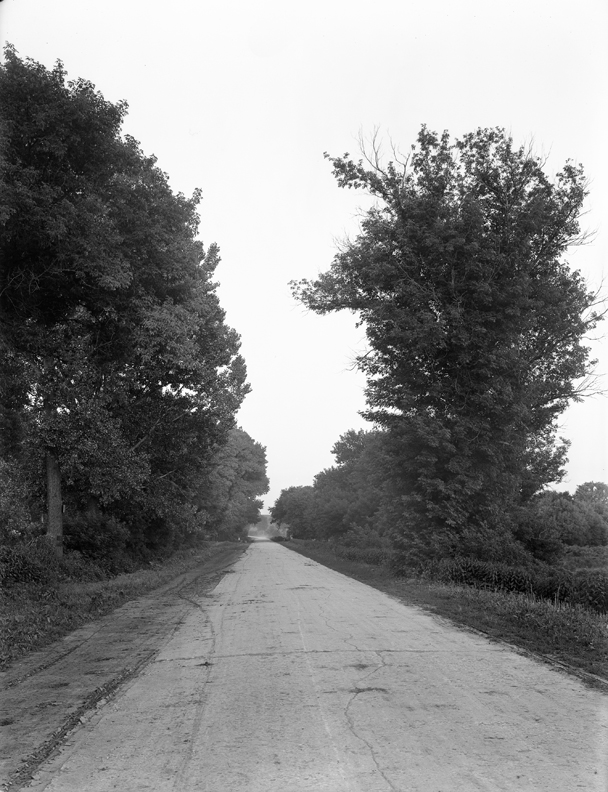
The peaceful country drive along West Dodge Road. Creator: Bostwick, Louis (1868-1943) and Frohardt, Homer (1885-1972). Publisher: The Durham Museum. Dated 1914.
Leopold Doll and Elmwood Park
Well I suppose we should get started with the precise pastoral parcel where 9301 West Dodge Road was settled. As this contrary case would reveal itself in reverse, I will share evidence of which I have just now become privy. Hard Earned Clue Number 500: Mr. Leopold Doll. Leopold Doll was born in Karlsruhe, Germany in 1843, arriving as a new immigrant to the United States at age fifteen. You might have heard of his name, as Mr. Doll was considered one of the Pioneer Settlers of Douglas County; he came by way of St. Joseph, Missouri in 1860. In his time Leopold Doll was Omaha Famous after having acquired “an independent fortune” and a “considerable amount of property;” consequently, Leopold Doll “built a number of houses” in Omaha. His brothers, Frederick and Charles Doll also owned substantial estates, garnering much attention in land owning circles. As a side note, these various high dollar Doll estates would propel hopeful heirs to come to blows. The more I studied the maps of early Omaha, I turned up unexpected Doll Farms all over this town. I think Rockbrook Village was initially one of the various Doll farm sites, that of William Doll—I believe a grandson.
In 1871 Leopold Doll married Wilhelmina “Mina” Elisabeth Walther Doll, another Karlsruhe, German native in Douglas County. The couple would have a remarkable sixteen children. The Leopold Dolls of Mysterious Means homesteaded at what is now Elmwood Park. From what I would gather, the original Doll House (I had to) was on a high hill on the west side of Elmwood Park. He planted many of the evergreens and other older trees, according to his family members. Later in life Doll made history by selling a number of acres on the east and west side of the so-called ravine in Elmwood Park to the city for the purpose of creating this city park. This was reviewed briefly in the Mysteries of Omaha: The Log Cabin and the Jones Street Bridge article. As an incentive toward the specifically planned use, Doll donated the ravine, some 18 or 20 acres to the city, supposedly around the 1890s–accounts vary, as they often do. This donation and/or sale to the city was how Mr. Leopold Doll would be remembered in Omaha. According to Arthur C. Wakeley’s tome Omaha: The Gate City and Douglas County, Nebraska, the large contribution of Elmwood Park would further serve to link the city through the well designed Parks and Boulevards System.
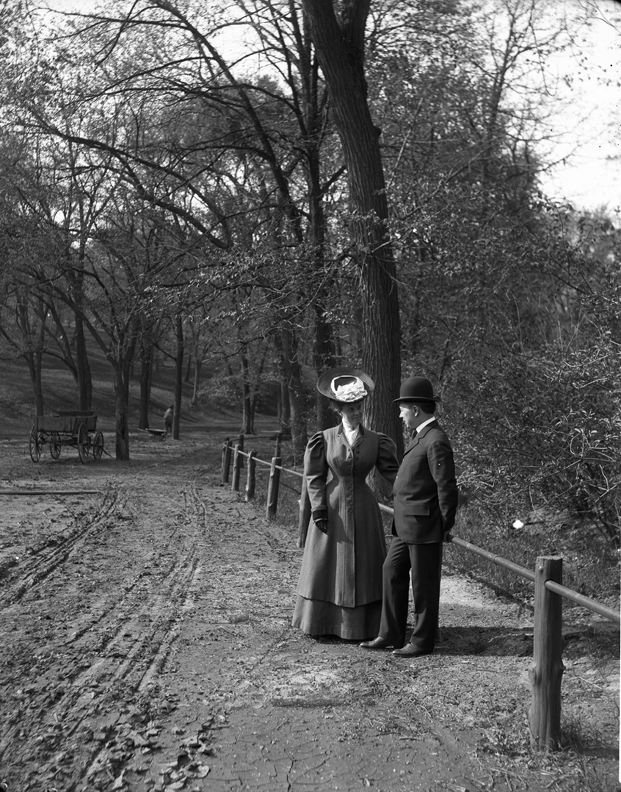
One of the earliest professional photos of Elmwood Park. George Roberts, manager of the Bemis Bag Company and wife in Elmwood Park. Creator: Bostwick, Louis (1868-1943) and Frohardt, Homer (1885-1972). Publisher: The Durham Museum. 1902.
The Plot Thickens
As I was to learn, Leopold and Mina owned vast farmland, aside from their Elmwood Park home, in what was considered the “West Dodge” area, extending to the unimaginatively coined West Dodge Road. Upon unearthing this 1925 map of West Omaha, I would find Leopold Doll’s rural countryside property encompassed our 93rd and Dodge lot.
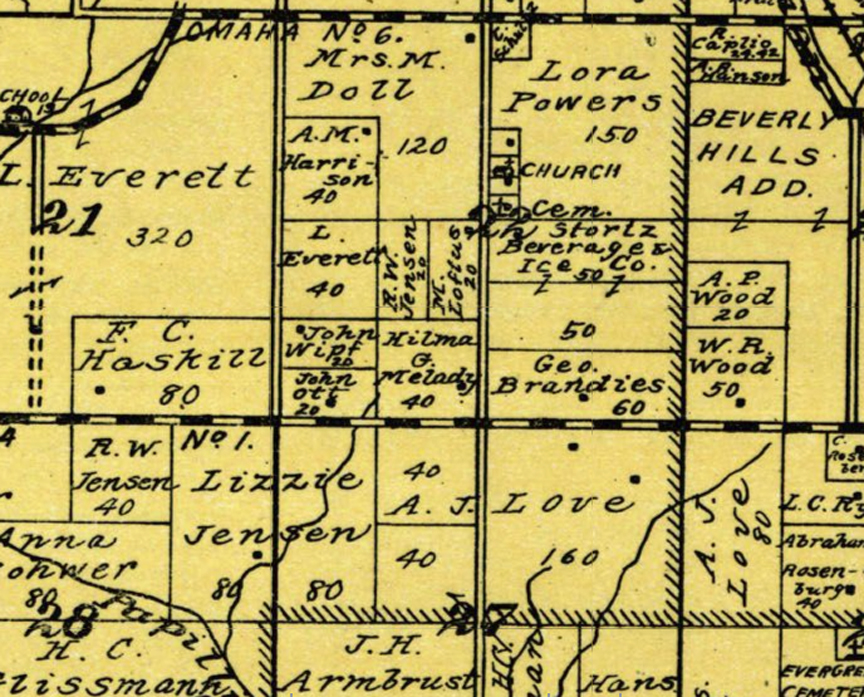
1920 map of West Omaha displays the Mrs. Mina Doll land, occupying what was later labeled 9301 West Dodge Road. Map taken from the Historic Map Works Residential Genealogy Rare Historic Maps Collection site. The striped black lines running east and west denote West Dodge Road and Pacific Street. Leopold Doll’s farm of 120 acres is shown to stretch from 90th on the eastern most perimeter to 96th Street on the west side. Was there originally a farmhouse on this swathe of 120 acres, did the Doll family work the land or was it an investment? Landowner to the Doll’s south was the Gene and Hilma Melady Clan from The Ballad of Balla Machree story. The Archibald “A. J.” Love farm is shown just south of Pacific.
As it turned out, almost twenty years previous to M. H. LaDouceur’s drafting of this property map, Leopold Doll had died on Dec 31, 1901 at the young age of 58. Six of his brood of sixteen children had sadly already passed away. Bertha, Laura, Emma, William and Edith had all unexpectedly died in infancy, while Rosa passed on at age 13. But it wasn’t until Mrs. Mina Doll died at the age of 80 in 1927 that the story of our mysterious 9301 West Dodge Road began to come into view, for that is when the remaining nine Doll children saw their family’s properties go up for sale. (The youngest daughter, Matilda Doll Larue, had unfortunately died in the interim at age 25.)
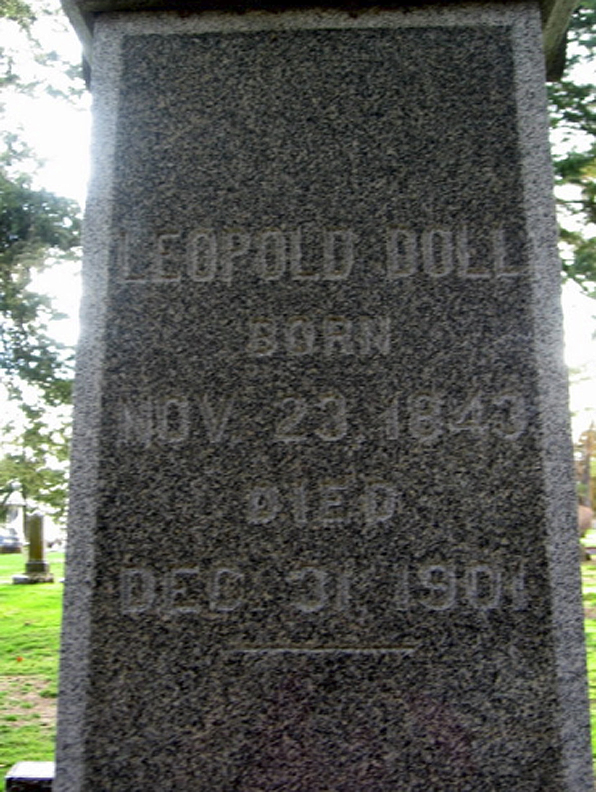
Leopold Doll headstone. Photo by DeeKay from the Find a Grave website. Mr. Doll and family members are buried in Omaha’s Evergreen Memorial Park Cemetery.
Archie Love
In June of 1928 a My Omaha Obsession favorite, Archibald “A. J.” Love, (for whom Loveland in the District 66 area was named) put in a bid for $67,500 of the Doll’s 120 acres at 90th and Dodge. Apparently former offers were made by Leopold’s heirs to the estate (sons Ernest, Leopold and Charles Doll and daughters Minnie, Lena and Clara) and a few other Omahans, who wanted to cherry pick parcels from the farm as a whole. The Doll siblings offered $60,377. It would appear that the farm was ordered to be sold as to divide the inheritance.
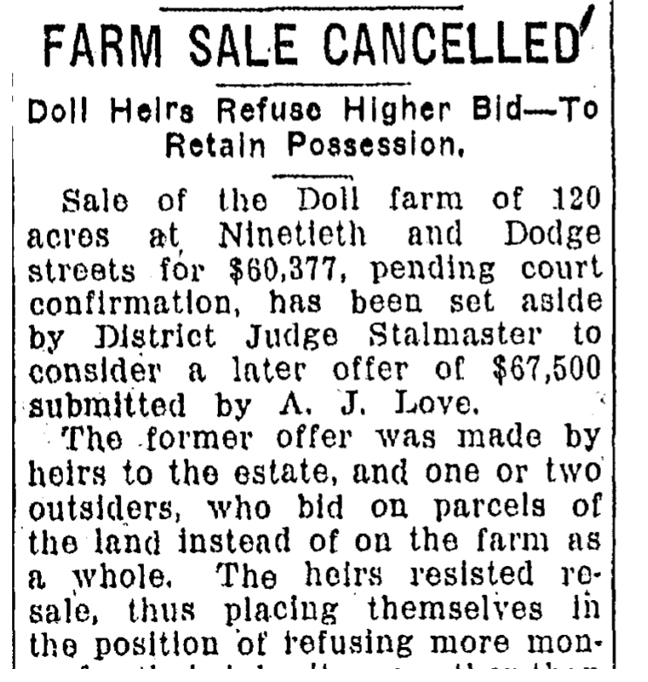
June 21, 1928. OWH. Despite the article’s leanings, in time the Doll heirs were either pressured or simply accepted Love’s offer, for soon after, A. J. Love had acquired the 120 acre Doll Farm on West Dodge Road.
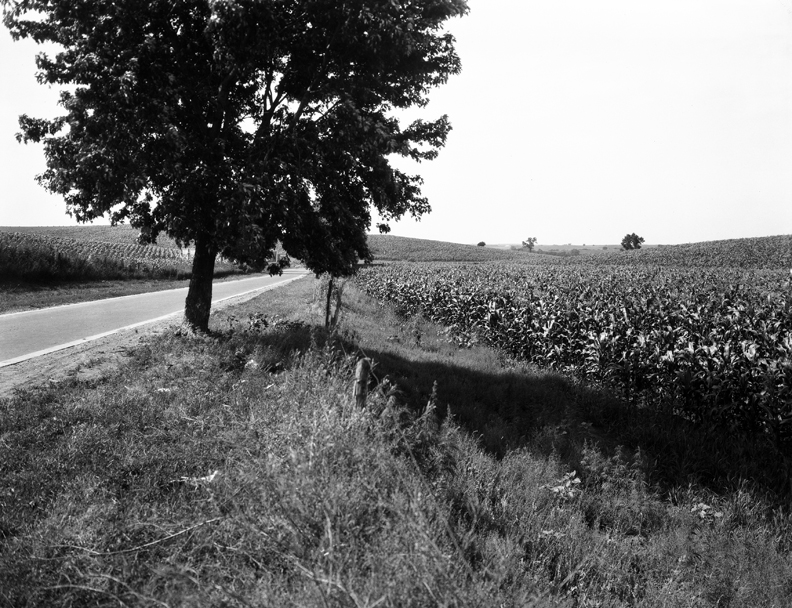
Left side of a panorama of a rural scene on West Dodge Street, Omaha. Road stretches through the left side of the photo, cornfields on both sides of the road. Creator: Bostwick, Louis (1868-1943) and Frohardt, Homer (1885-1972). Publisher: The Durham Museum. 1927.
Initiation of the Ninetieth Street Realty Company
I discovered articles of incorporation filed on September 1 of 1928 with the state for the Ninetieth Street Realty Company of Omaha. A. J. Love was president and treasurer of the company. Gene Melady, vice-president and Charles E. Reese, secretary among seven other incorporators. The board of directors included other men with country homes in the West Pacific Hills district (Bert Murphy and Frank Haskell, names I recognized from the Balla Machree story). The Doll Farm was said to face one-half mile on Dodge and one-half mile on 90th Street, both paved roads by all accounts. The remarkable parcel to be established “gives an unobstructed view of the countryside for miles.”
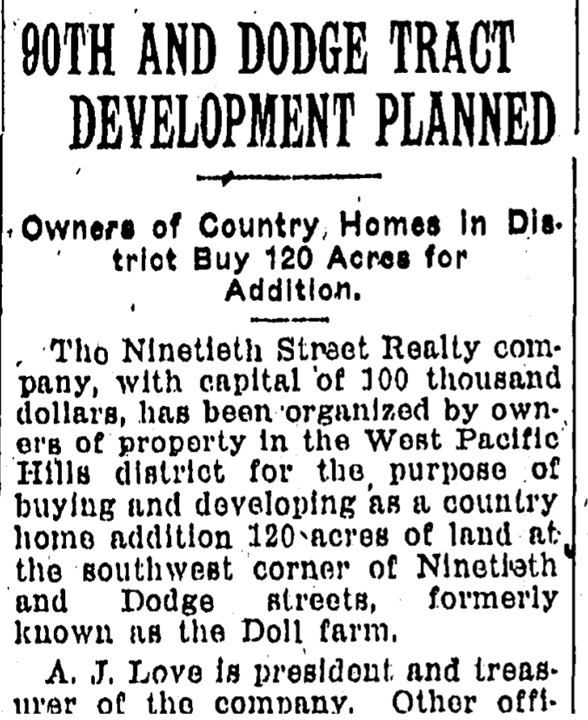
Sept 4, 1928. OWH. The Doll Farm was bought as an early West Omaha country home neighborhood development.
The Westchester Addition
Things were looking good in the summer of 1929 when the Ninetieth Street Realty Co were granted their extension of the water main on Ninetieth and Pacific Street up north to Dodge Street by the Metropolitan Utilities District directors. It looked as though their new tract was shaping up and the publicity of a mile long, six-inch main, costing the members collectively $8,500, only proved their commitment to this fine neighborhood. But then nothing…for years. It is interesting to consider this Ninetieth Street investment and the time period in which possession took place. I had wondered why the Doll Farm sat for eight years after all of the promotion until I remembered the Stock Market Crash a few months after the MUD action and shortly thereafter the Great Depression arrived. These obstacles surely might have suspended the Ninetieth Street Company’s plan. Did people farm the land in the interval or did it grow into a desirous, unruly bramble? There is evidence that a farm was maintained and one red cow seemed to enjoy a little jaunt in the area during this time period.
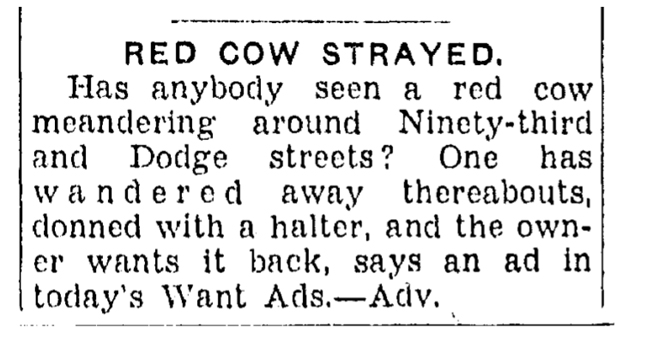
July 1933, OWH.
The Ninetieth partnership would name their new development, the Westchester Addition. It appears this addition didn’t formally get off the ground until about 1936. Developers announced they were to put the new lots on the market as soon as landscaping, permanent roads and water main extensions were completed. (Their 1929 funding must have fallen through.) The addition comprised about 15 tracts initially, of a little more than an acre each, between Dodge and Pacific Streets west of 90th. The name Westchester Addition entered the newspapers in April of 1937 when lots began being sold.
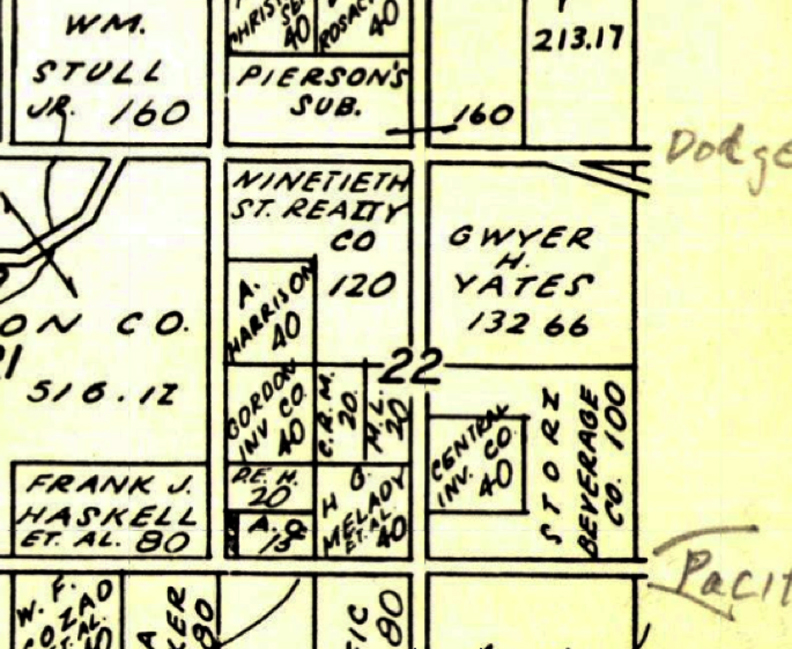
1938 map. Map taken from the Historic Map Works Residential Genealogy Rare Historic Maps Collection site. I searched for a map of the Doll Farm property from this later time period and was able to find this offering. I thought it was so cool! Someone has long ago penciled in Dodge and Pacific Streets as references. One can see that the Mina Doll acreage has been relabeled Ninetieth St. Realty Co—it still was at 120 acres with 90th Street at its eastern perimeter and 96th Street on its west border.
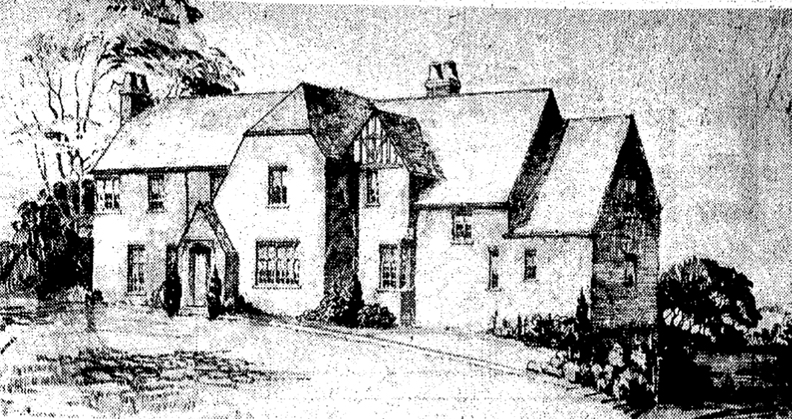
The Clarence L. Landen home– architect’s draft by none other than Leo A. Daly. This 1937 rendering was but a tantalizing view of things to come for the Westchester area. Clarence L. Landen was the first to build in the Westchester Addition, an English residence at 92nd and Davenport. Such a beautiful home! For the life of me, I cannot find it though. I fear it was torn down. This dreamer would feature a party and billiards rooms. The Landens would have reoccurring walk-ons in the years to follow.
A Breakthrough
September 8, 1940 announced plans to plat “more home sites in Westchester, country home addition between Dodge and Harney Streets from Ninetieth to Ninety-sixth.” T. R. Huston of Western Securities Company had taken control of the subdivision management. Huston promised more sites to be platted soon, with plans to expand Farnam and Harney Streets throughout the Westchester district. He estimated there was space for 150 homes to the area with a Westchester build minimum set at ten thousand dollars. Natural gas lines were thought to soon extend to the new development. By 1940 there were eight homes in the neighborhood to include the Jacobbergers of Kimball Laundry fame and vice-president of Guarantee Mutual Life Company, R. E. Langdon. “Three new houses are under construction for Leo Bozell, president of Bozell & Jacobs, Inc.; Daniel Cary, president of the real estate firm that bears his name and Mason B. McVeigh, manager of the Foster Barker Building.” The McVeigh house was noted for being built on the highest point of the subdivision, “which slopes to east and west, commands a view for many miles in all directions.”
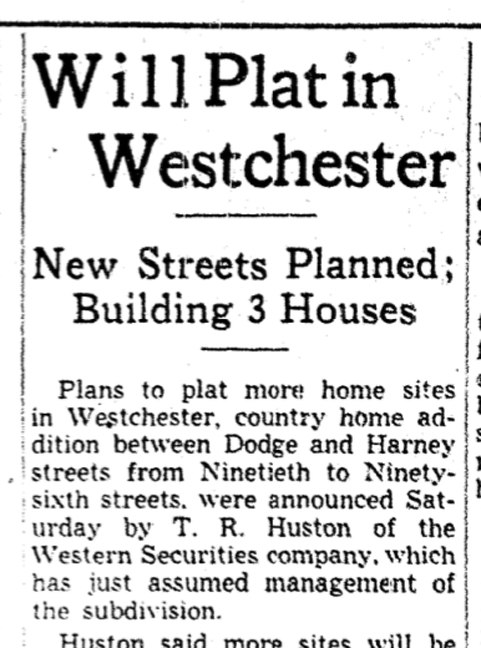
September 8, 1940. OWH. Will Plat in Westchester. This area was still considered Out In The Country.
This Mason B. McVeigh inkling was the golden thread I had missed in my first fated go-rounds, among every other clue I failed to spot. But what an appreciative break in the case, to discover this name. Tip-off: It was Mason B. McVeigh who built the Georgian Colonial Mansion set far back from the road at 93rd and Dodge.

The Mason B. McVeigh File
According to the Family Search site, Mason B. McVeigh was born in Illinois in the year 1900. By the late teens I found a M. McVeigh in Omaha who peddled new and second hand grand and player pianos; the same man offered a multitude of musical instruments for sale years to come. This vague M. McVeigh was selling “cigar store products” to include a store register and a safe later still. Same fellow?
In December of 1935 our man, Mason B. McVeigh was a 36-year-old “flour broker” bachelor living in the posh Fontenelle Hotel. Archival social news articles showed he had been married and living the high life within the Inner Circle set from 1931 to April of 1935. Perhaps he had gotten a hush-hush divorce, as they usually were in those days. Months later in March of 1936, Mason B. McVeigh filed for marriage license and would marry 28 year old Lillian Parks. (The U. S. Census of 1940 had Mrs. McVeigh listed as Florence Lillian and also confirmed McVeigh’s career as that of a flour broker.) The newlywed couple initially bought lovely Lot 22 of the Fairacres Neighborhood at 67th and Underwood. After purchasing the land from the Reed Holding Company in June of 1936, they were mentioned again that fall, as the Fairacres area was soon to envelop twelve new residences. The McVeighs were to move to their new home shortly.
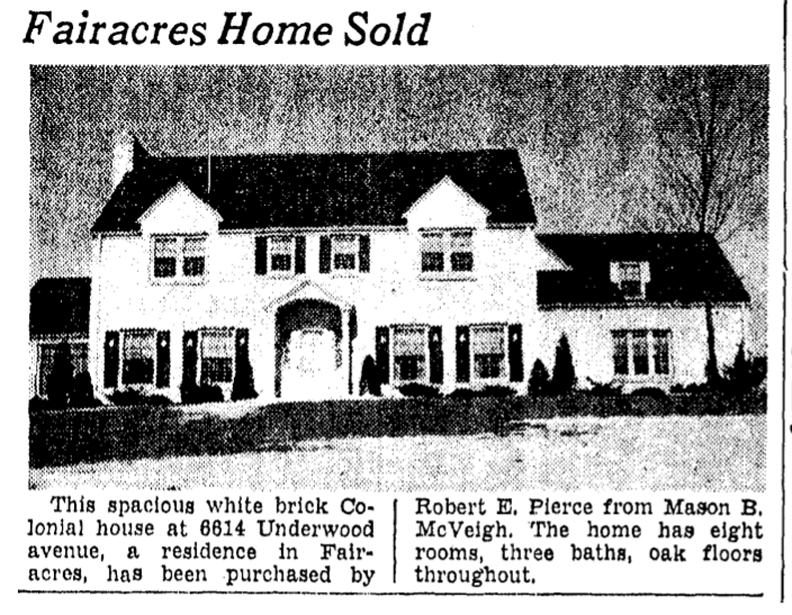
November of 1939 OWH photo of the McVeigh Fairacres home. One could assume a flour broker made a good living back then, considering this well-appointed lap of luxury– although the previous article had also mentioned McVeigh curiously managed the Foster Barker building. I know this clue did not escape you either.
Marginal Note (or Intermission, dependent)
Now the Barker family had early Omaha roots dating back the 1850s; I understand the family’s historic letters, coined the Barker Collection, offers descript documentation of our town. I am not sure where this collection is housed. The famous Barker Building is a classic Downtown Omaha structure at 306 South 15th Street and I believed this was the building McVeigh possibly oversaw…until I found a Life Magazine advertisement revealing the Foster Barker Company. The Barker clan had long ago forged the insurance business and the accompanying building bearing its name at 209 South 19th Street.
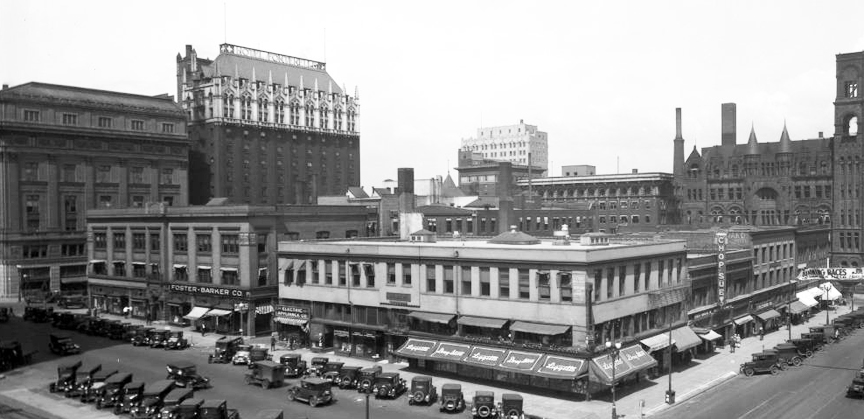
View of Omaha from Sanford Hotel to 19th & Farnam Streets. Liggetts Drugstore is seen on the right and the attractive three story Foster Barker Insurance building is to the left. Fontenelle Hotel is behind the Foster Barker; a posh hotel located at 1806 Douglas Street, the Fontenelle was torn down in 1983. This is where McVeigh lived briefly as a bachelor. I believe “the Old City Hall,” also known as the Red Castle, is seen on the corner of 18th and Farnam Streets, to the right. Constructed of granite and red sandstone, this massive building was demolished 1966. Get out your magnifying glass, for there’s a wonderful Chop Suey House marquee visible. Creator: Bostwick, Louis (1868-1943) and Frohardt, Homer (1885-1972). Publisher: The Durham Museum. 1926.
I was saddened to find the Foster Barker building no longer extant. (Along with almost every other structure in this photo, actually.) The Douglas Building now standing at this address was constructed in 1965. I do not like to speak ill of an innocent building, for it’s looks are not its fault but the Douglas is not one of Miss Cassette’s favorite structures in town.
Crucial Clue
According to the Society Pages, the McVeigh couple moved in to 9301 West Dodge Road just before Christmas of 1940, pushing the County Assessor’s estimated construction date back one year. The following leads were some of the most rewarding of the whole case, and I only just discovered them weeks ago!
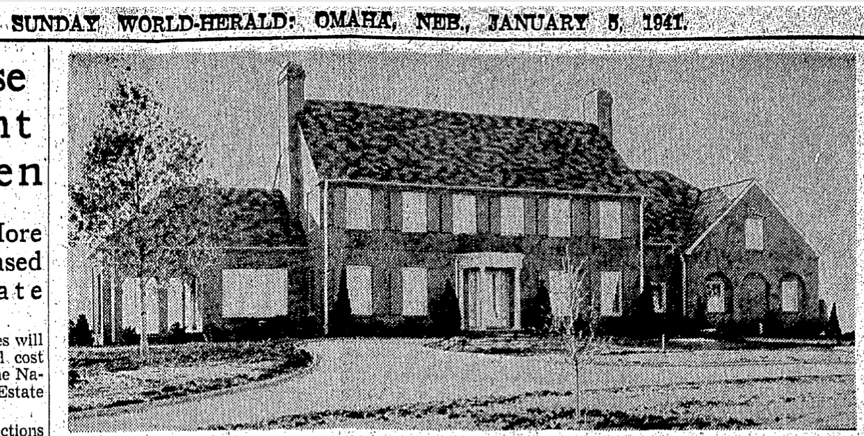
January 5, 1941 OWH photo of house. This was 9301 West Dodge Road’s proper debut into Omaha Society, although she went by a different name back then. I savored this photo as it lends significant clues to the initial construction. I will confide I had assumed the front gabled portion of the home to the west was a later addition. Take note that the eastern wing of the home was still open then, with what appears to be an outdoor sitting area. This attachment is now bricked in. By late January 1941 the wealthy couple issued invitations to 90 guests to call on their new residence, “Twin Oaks.” From four to seven o’clock the couple entertained at the housewarming with guests such as the Bushnells, the Landens, the Shukerts and the Borghoffs.
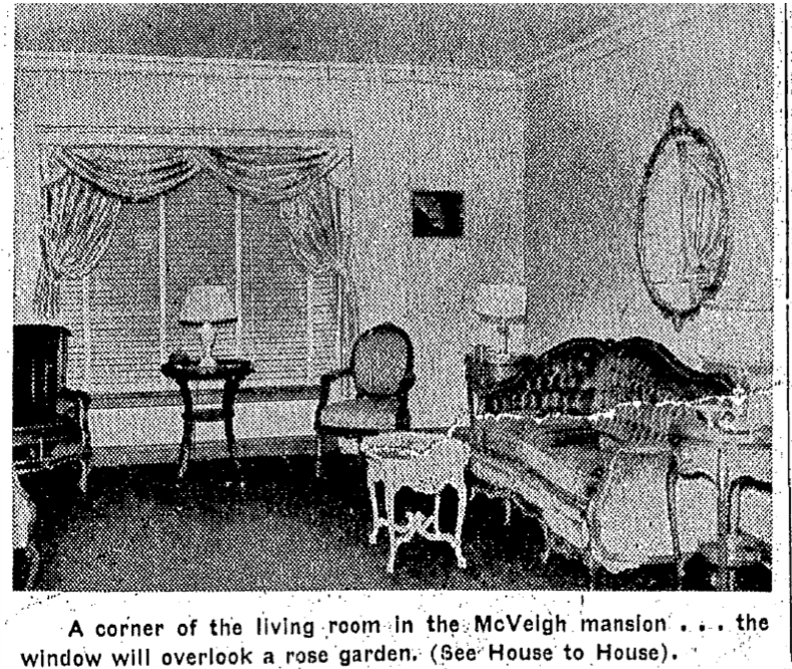
OWH photo from 1941. Living room of McVeigh Mansion. James Keogh’s devastatingly, fascinating ongoing column, “House to House” featured in the World Herald, gave every perfect tidbit. Keogh described the 9301 mansion as sitting “where the west of Omaha hill reaches its peak,” said to be the highest spot in Douglas County. The McVeighs chose the site for the far-reaching views in all directions. “From the peak, one can see many miles in all directions ad the lights of Omaha make a picturesque study at night. In the daytime, one can see the top of the new Mutual United Benefit Building at 33rd and Farnam Street to the east, now Mutual of Omaha, the Country Club to the north and the Happy Hollow Club out of the south windows.”
With shaking hands I discovered the McVeigh Mansion was lovingly termed “Twin Oaks” for the two red oak trees newly planted in the front garden to be. And here I was just craving for a mansion christening. The kindred spirit I found in journalist Keogh…I assumed Keogh had a bit of the Raymond Chandler in his blood, when he wrote, “Last week, after having watched its construction from the ground up with great interest, we went up the winding drive to see the master and mistress of the household. Down in the basement we found McVeigh, shirtsleeves rolled, tools in hand, finished the recreation room. Carpentry, he explained, has long been his hobby and he will finish the recreation room walls in mahogany and tufted white leather, the adjoining bar in mahogany and red leather.” The pure joy of imagining a man of stature building his own recreation room, let alone the mahogany and red leather padded bar area…why, it sent shivers! Miss Cassette fainted and was only revived by the promise of reading further.
I share the following photo because it gives an excellent view of what a woody basement looked like from this time period. The Milton Watt home was not too far away on 85th and West Dodge Road.
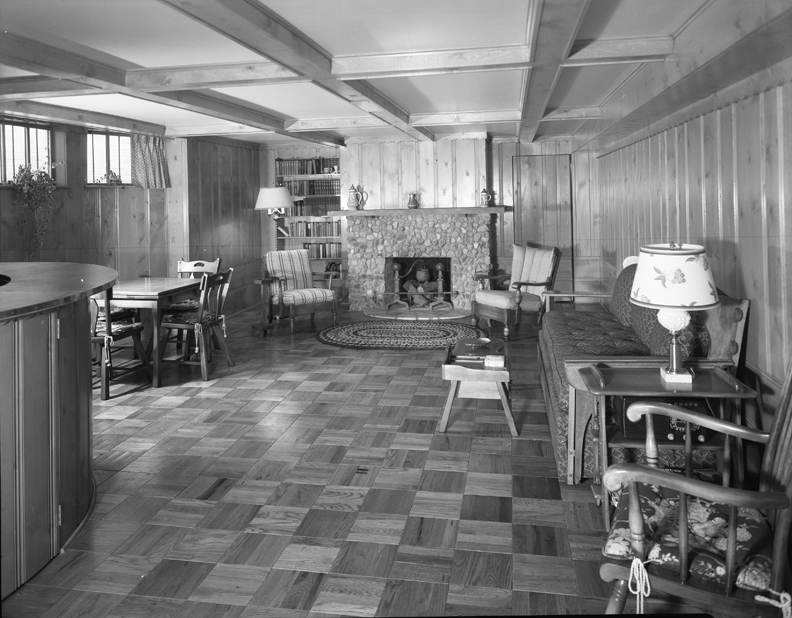
A girl could really luxuriate in a room like this all day. I would play Scrabble and listen to Tommy and Jimmy Dorsey. New parquet floor in the basement room of the Milton Watt home at 8536 West Dodge Road. Creator: Bostwick, Louis (1868-1943) and Frohardt, Homer (1885-1972). Publisher: The Durham Museum. 1940.
Context and Strange Clues
Oddly I found a September 1940 telephone listing for the McVeighs at the 93rd and Dodge address. How was it that they already had an assigned phone number for the build site back in September? WA lnut-4049. Detectives, think about it…

September 1940 telephone book listing.
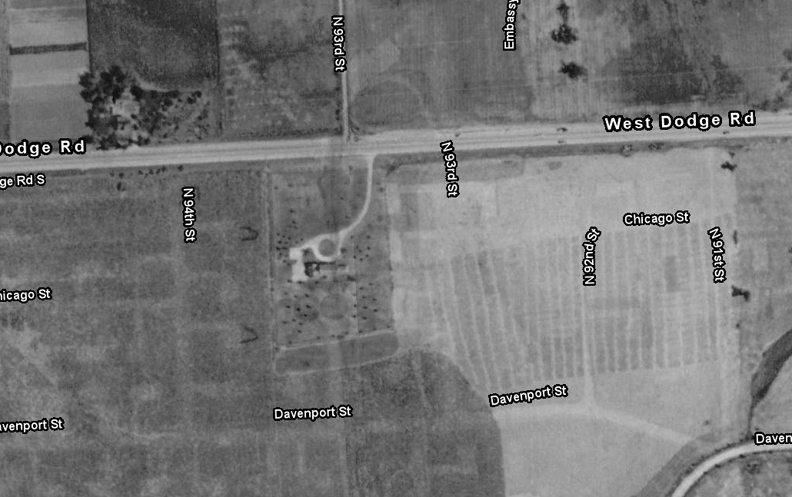
I rang up the Douglas County GIS site and was beside myself when I found clear aerials of Westchester from 1941. One can see how remote of a locale 9301 West Dodge Road truly was. 1941 Aerial map photo borrowed from the Douglas County/Omaha GIS Department website.
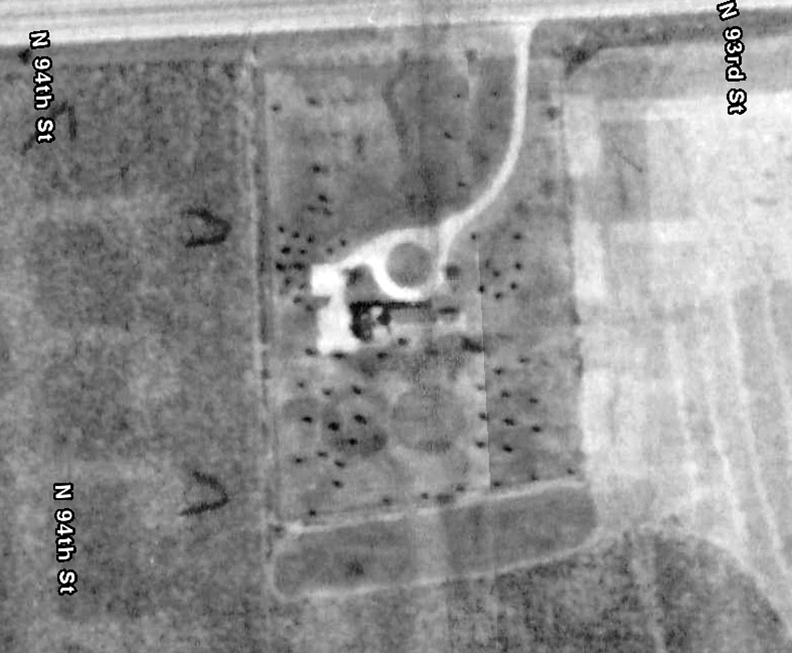
Here is a detail of that DOGIS 1941 survey. Twin Oaks had obviously been well laid out with fantastic, new, mindful plantings and just look at that circular drive. Or is that a garden bed? 1941 Aerial map photo borrowed from the Douglas County/Omaha GIS Department website.
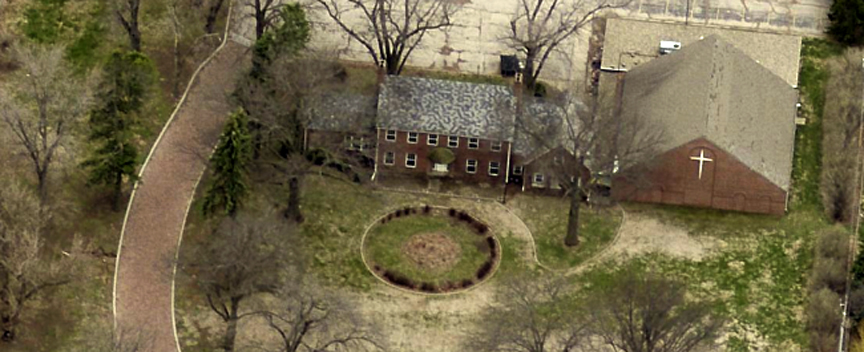
DOGIS aerials of the 2000s still show the remainder of the circular drive and a nice overview of the original home.
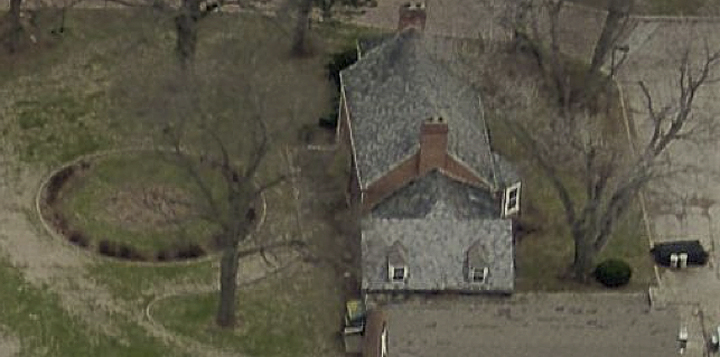
Western view reveals the original gable roof of the west wing and the dormer windows, not visible from Dodge.
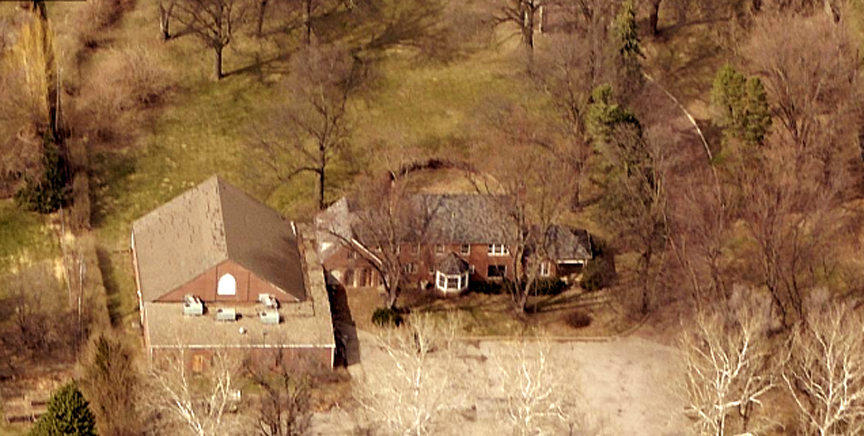
Southern elevation.
It is important to consider the cultural context of Twin Oaks. This gorgeous, spacious home was built one year before America would enter World War II. When this Georgian Mansion was introduced in the Omaha papers, what was really gaining attention were the new Ranch Houses of the Loveland District, giving new meaning to the “Western Air” concept. The Ranch trend would particularly gain momentum after the War, when Americans collectively demanded more legroom. The Minimal Traditional homes of the 1940s were also very popular across the States.
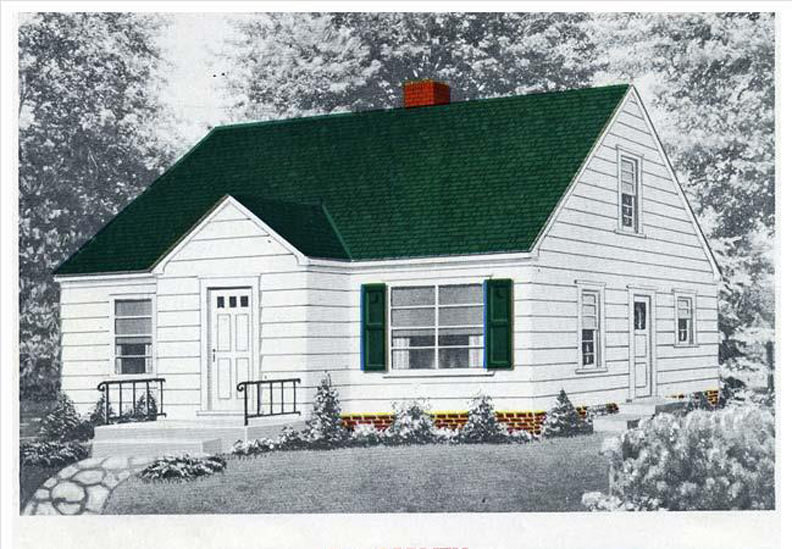
Often small, one or one and half stories, these simple but modern houses lacked the outward ornamentation of previous decades. Cost cutting during the Depression and limited building materials due to War Rationing made these little gems affordable for the working and middle class. Anyone living in a 1940s Minimal Traditional home knows these cuties were constructed of the same high quality materials just like their grandiose contemporaries, minus the frills and glorious finishes. I am speaking on behalf of our Cassette Mini Giant. I only make mention of these smaller, modest peers because Twin Oaks, by my estimation, was an unusual, albeit stately choice for 1940. This smokescreen was a part of my early confusion about what time period she came from.
The Architect’s Plan
It was my delight to find Omaha Architect Noel Wallace designed the McVeigh house. I will limit my history of this prominent architect here, as I wrote considerably about him in my upcoming book. What I can divulge is that Wallace inspected original Georgian Colonial Revival styles in the designing of Twin Oaks. Another article would describe the home as modeled after “early Eighteenth Century homes in Williamsburg, Virginia.” It was not unheard of to see a simplified version of a Georgian Colonial at this time but Wallace and his clients, the McVeighs, were financially able to embrace and incorporate some bells and whistles of the large brick estate. The classic, centered front door; balanced, symmetrical rows of windows with double-hung sashes; very little eave overhang; side-gabled roof; paired end chimneys; unmatching, lower wings forming a three-part plan, wings on east and west sides almost as “hyphens” connecting the main house; the western dependent is a eye catching, front facing gable. Originally Twin Oaks reputedly set back 280 feet from Dodge Road on a three and one-quarter acre tract, was 101 feet long and 36 feet wide at the widest point. There was a “parking area west of the house for about eight cars.” Upon completion of their new home, the McVeighs were “considering building a stable for their horses.” File this away, sleuths. They also planned for a large rose garden in their back private area. The previous photo said that there would be a rose garden off of the front living room as well. Perhaps they were rose obsessed.
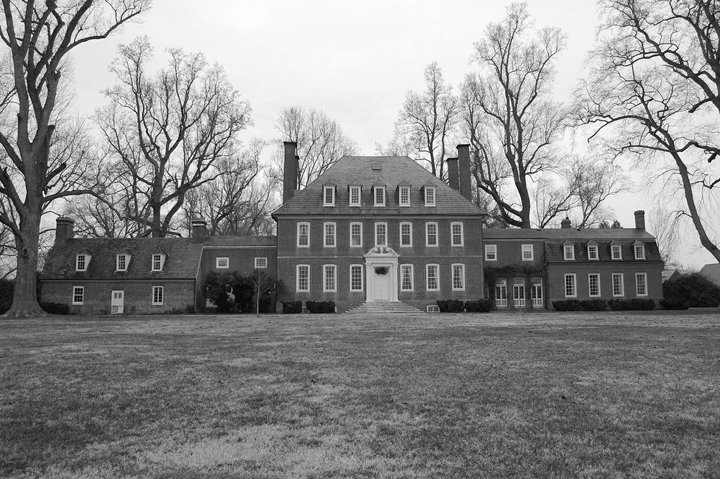
This is a very upright, exaggerated Georgian form from Virginia. Something about the way it sets back, surrounded by these trees reminds me of our Twin Oaks version.
Interior Description
Twin Oak’s main entrance originally opened into a lofty 11 by 13 foot formal entrance hall, with arched doorways to the living room on the left, dining room on the right. The dining room had a large crystal chandelier, of course. A large sunroom was off of the living room, and a large porch adjoining that. Directly ahead of the entrance hall was a breakfast nook, in front of a large south bay. All interior woodwork was said to be of walnut. A modern feature of “thermostatically controlled heat” allowed for different temperatures to be maintained on different floors, in different rooms. The McVeigh master bedroom apparently stretched the extent of the north facing living room (gasp) and boasted another modern feature—ceiling height and wall width of master room drapes, which would have been quite a luxury. I couldn’t help but wonder as I had from childhood. What must Dodge Street look like from inside the home? To look out dreamily on one’s large grounds. The world looks different from this position, I was sure of it! All bedrooms offered private, adjoining baths. “Servants’ quarters, commodiously finished, are three steps down from the second floor level on the west side of the house, with direct stairs below to the kitchen.” Sigh… A delicious description of an early McVeigh party disclosed that their spacious hall, “adorned in bowls of red roses,” dazzled one hundred guests, as “Pink gladioli highlighted the piano and yellow, pink and blue sweetpeas graced the dining table”–the Eighteenth Century styled home described as “abloom with flowers.”

The High Style McVeighs
Twin Oaks was a fine hostess. She presented buffet suppers, engagement parties, afternoon teas, ladies’ luncheons and all of the Town Tattler perks one obsessive detective could dig up. It was all so very exciting to me–perhaps even more so for I than for you huddled here today. Keep in mind, I was going off of the misunderstanding that this home’s original owners were the Walshes. To discover the McVeighs and their hobnobbing in the rose garden was like a chest of gold or a hidden pocket panel door behind the wardrobe! Twin Oaks and its inhabitants were the talk of Omaha.

December 13, 1942, OWH. The beautiful Lillian McVeigh seen in the middle of two pretty galpals, “car pooling and ‘staying down all today’ to shop for the week is the gas rationing solution for Mrs. Clarence Landen, Mrs. Mason McVeigh and Mrs. J. C. Rahel”—presumably they car pooled to Downtown Omaha and stayed there all day, rather than driving about separately and wasting gasoline. If I do say, our Mrs. McVeigh looked like a brunette Barbara Stanwyck. Her perfect nose. I commend these three for their glamorous wartime shopping efforts in furs and aplomb. I marvel at the 1940s Peeptoe courageously worn in a Nebraska December.
But by December of 1943, for reasons yet unsourced, the McVeighs had tired of their mansion and moved to the stylish, urban accommodations of the Blackstone Hotel. I have heard that a number of wealthy Omahans would move into the Blackstone living quarters where one could have a suite of palatial home like rooms. I am not sure if this amenity was offered in the early forties but I know there were hotel apartments on the upper floors by the fifties and sixties. Can you imagine ringing up for a reuben whenever you wanted? Mr. and Mrs. McVeigh had sold their upmarket estate to Mr. and Mrs. Thomas A. Walsh, Jr. “and their small daughter, Mary Marjorie.” I would backtrack with a fine tooth comb and eventually find the Real Estate Transfer actually registered in November of 1943 to forever be enshrouded in the Misspellings File: “McCeigh Mason B & w to Thomas A. Walsh Jr. & w: part nw of 22-15-12.” My sainted aunt…the ruinous numbers of Land, Township and Range from the Public Land Survey System. Disagreeable with my constitution.
An Aside
This is where things get a little more Fondly Tangled in the Mystery Mansion case. For those of you who like Nettle-y Webs, allow me to lay a foundation leading up to the Walsh takeover. I am of the belief this history will establish a better understanding of the family who truly made the 93rd and Dodge mansion a home. And if what follows does not lend an understanding, it may well just be interesting. If you don’t enjoy Behind the Scenes evidence, continue on to “The New Walsh Residence” header.
The Thomas A. Walsh Family
In all sincerity I am not exactly sure when Thomas Arthur Walsh moved to Omaha from Elmira, New York or what brought him-them to town. His father, John T. Walsh continued to live in Ithaca, New York. I would find son Thomas A. Walsh and his wife were annual visitors to the Hotel McAlpin in New York City in 1916, 1917, and 1918 and back in those days, the Omaha papers were quick to observe these matters of upper crust travel. I had estimated the Walshes’ arrival to the Plains in about 1912 but a photograph would prove this incorrect. You might find it funny that just now I have learned of the lovely Mrs. Walsh’s name and have tiptoed backwards to type these words: Mary P. Mrs. Mary P. Walsh. There. It wasn’t until I found a 1918 advertisement for an experienced traveling salesman, to include salary and expenses, that I discovered the Thomas A. Walsh Company. Of which I became clearly infatuated over time. Early 1920s ads would give a more explicit view: “Salesman, experienced with car to travel Nebraska and Iowa selling salesboards; large commissions. Thomas A. Walsh Manufacturing Company. 1510 Burt St.” I didn’t know then what a salesboard was and perhaps you don’t either. That compulsion would depreciate down its own rabbit hole.
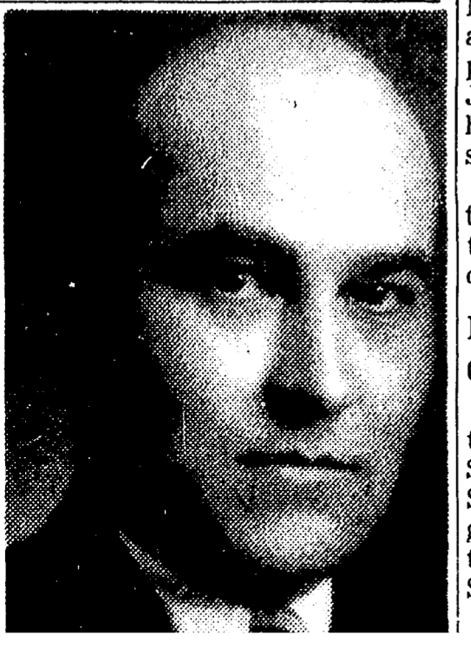
Thomas Arthur Walsh, Sr. Photo from the OWH.
In 1920 Mrs. Walsh gave birth to a baby born, Thomas Arthur Walsh, Jr., known as Tommy and Tom throughout his life, as any good Thomas would be. He was the Walshes’ only child. (Jr. would feature prominently in our 93rd and Dodge Street Mansion.) I learned the Walsh family lived up in the lovely Florence area, a favorite of Miss Cassette’s, at 6302 Florence Boulevard, after reading of a family tragedy. In 1929 Sr. Walsh was called upon to unfortunately identify his brother, Earl E. Walsh (John?), a salesman who was found dead at the foot of a stairwell leading to a basement pool hall at 1506 Cuming Street. His death was attributed to “poison liquor.”
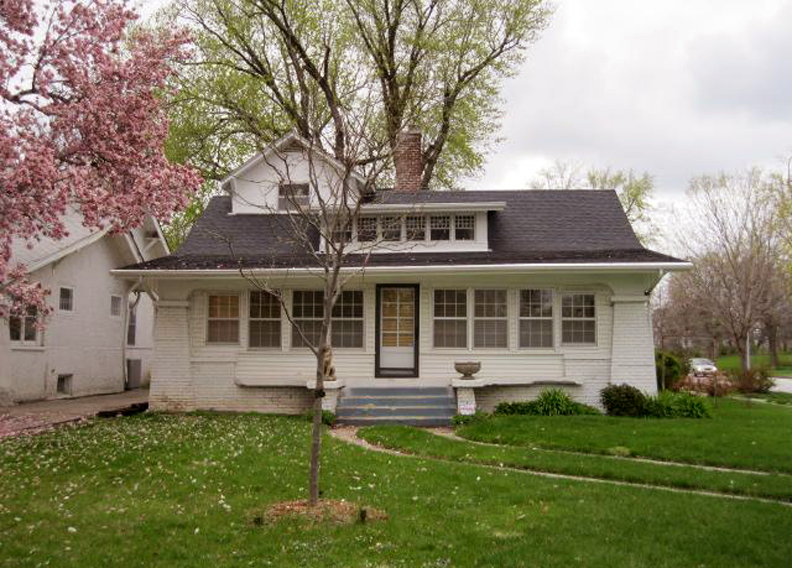
The T. A. Walsh original family abode. I love this home! Perfection on the edge of Miller Park. 6302 Florence Boulevard was supposedly built in 1915. Photo borrowed from the Douglas County Assessor site.
Little Tommy Jr. was educated at the Minne Lusa School and Mrs. Walsh was an active society woman, heading up the Prettiest Mile Women’s Golf Club as president. Sr. Walsh seemed primarily focused on matters of business. And quite a business it would turn out to be.
The Thomas A. Walsh Manufacturing Company
It was this 1906 photograph that threw me off of my timeline. If this date is to be believed, the Thomas A. Walsh Manufacturing Company was already in full swing.

The M.E. Smith & Company–a new building at 10th and Douglas. Omaha Cap Manufacturing, Thomas A. Walsh Manufacturing, and Omaha Bookbinding Co. on the first and second floors. Creator: Bostwick, Louis (1868-1943) and Frohardt, Homer (1885-1972). Publisher: The Durham Museum. 1906. This building would later become the Brandeis Department Store distribution center or the “Brandeis Warehouse,” as it was called in the 1940s. Miss Cassette would sure like to poke around in that building.
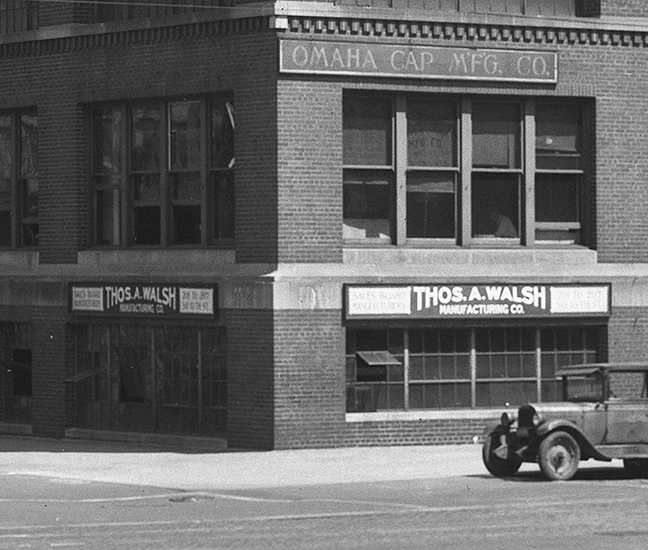
Detail of the Walsh sign. Sr. Walsh filed articles of incorporation in May of 1929, listing his company as a “novelty goods” business. Along with the salesboard tip, this phrasing only served to pique my interest.
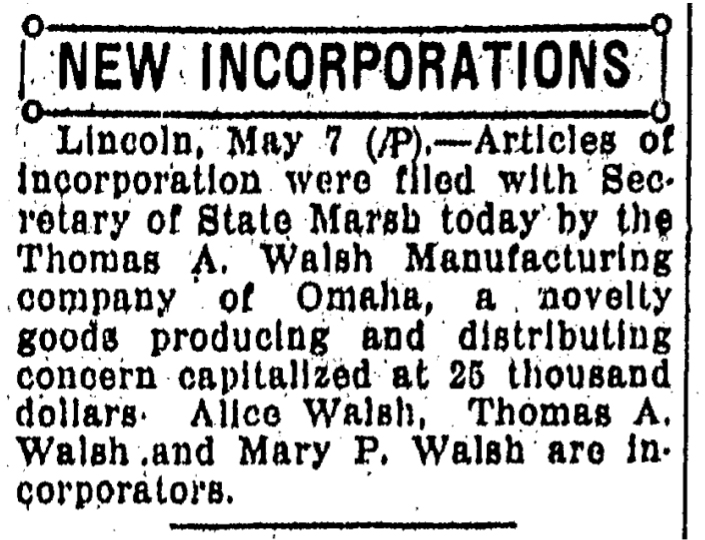
May 1929, OWH. There is that Mary P. again. It all makes sense now. But who was Alice?
The Walsh Business and Gambling
As it turned out, Sr. Walsh was in the punchboard parlor game business. These palm sized pressed cardboard games offered the thrills of gambling, fortune telling or party dares, dependent. The punchboard games were innocently sold at five-and-dime stores, but gained notoriety when lottery operators and men of dubious repute began tricking the gullible out of their pennies. Cheating on punchboards was apparently an easy, dirty deal. Early on tavern owners created this lottery game board out of wood with holes drilled in, that held a curious little piece of paper. For a penny a lucky duck would hope to push through the paper with a nail to see if they had the winning number, a forerunner of the modern day scratch card. Later when the Walsh Manufacturing Company got involved, punchboards had evolved with paper or foil sealed over the holes on both sides, equipped with a metal “punch” so one could push out the enclosed ticket. The punchboards reached their peak in the 1930s. By the late thirties, the authorities were on to the punchboards and banned after the social climate began to frown on gambling. Manufacturers often claimed the boards were “for trade only,” even though the paper tickets could be redeemed for cash at the bar or wherever the lottery was held. Risqué pin-up girls, illustrated characters and product placement were often depicted on these gambling boards, serving as advertisement for cigarette and liquor companies. See punchboard.com for a great history lesson.
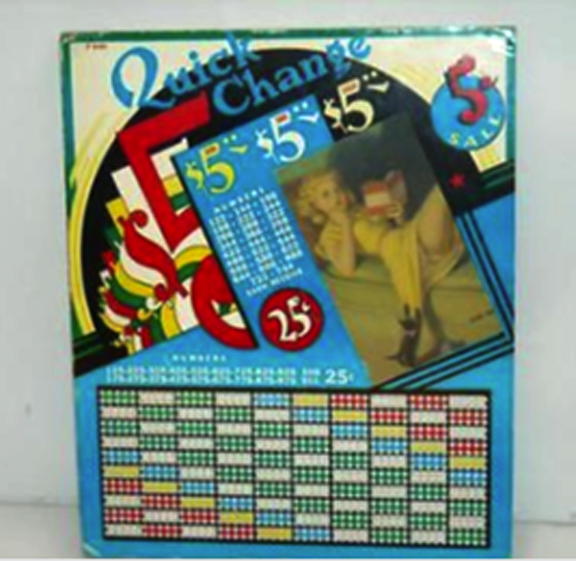
Unpunched 1930s Quick Change Cash game with pinup girl, whose dress is being “playfully” ruffled by an innocent kitten.
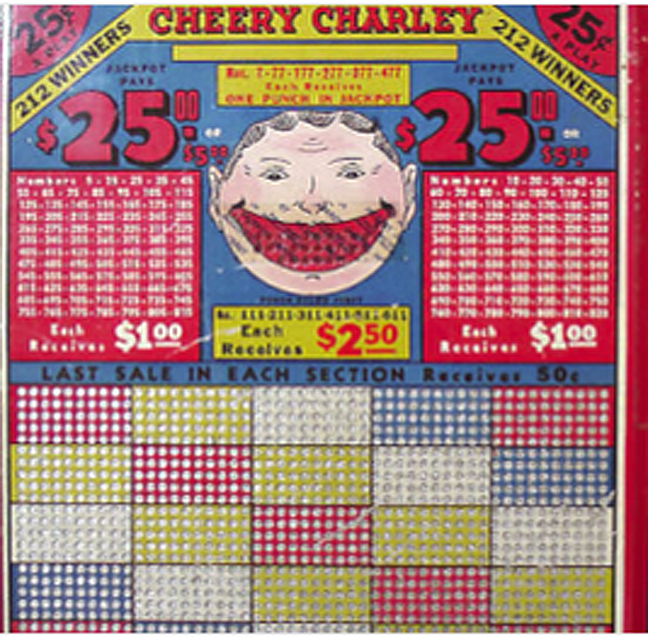
Another punchboard card, this time the Cheery Charley character.

Nice handpainted font on a Thos. A. Walsh Mfg Co. Games and Novelties sign of 1935.
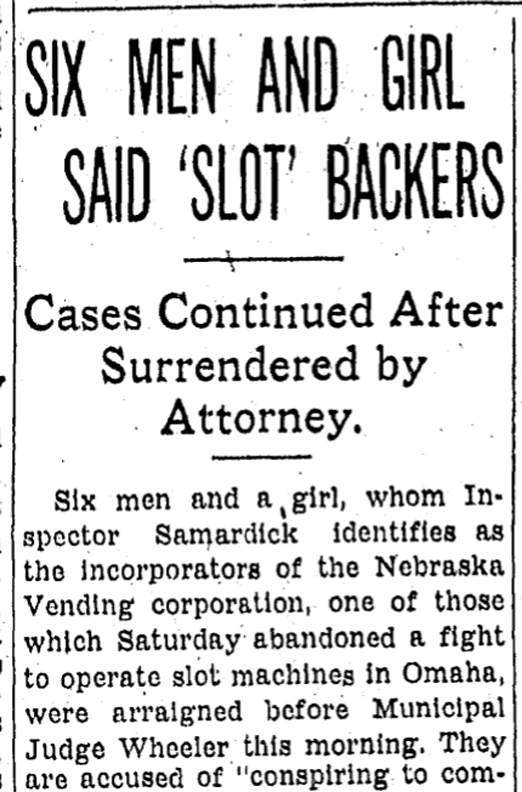
January 1934, OWH. Thomas A. Walsh was arrested and accused of having incorporated into the Nebraska Vending Corporation, with larger plans to operate slot machines. (The Walsh family was still listed at a Florence address, for the record.) The six arraigned beside Mr. Walsh were Dave Berkewitz, William Joffee, A. J. Johnson, Ray Parsley, Miss “Pat” Vivian Plummer, and Tony Mangano. All were released on one thousand dollar bonds. John Frieden signed for Walsh and Miss Plummer. After court, Walsh was quoted as saying, “The whole outfit could have walked out free this morning if we’d been willing to do a little trading,” referring to the conference in Inspector Samardick’s office. Pressed to enlarge upon the statement, he dismissed it with a shrug. “What’s the use? We’re all washed up. The machines are out of town. We admit defeat.” Samardick and his Moral Squad expressed pleasure with the outcome of the police drive on slot machines. “There isn’t a single slot machine operating in Omaha,” he said. “All officers have instructions to seize on sight, without waiting to make an investigation.” Morris Sebring had been arrested the Saturday before as the “main squeeze” in the Omaha Sales Company, another party to the lost injunction ware.
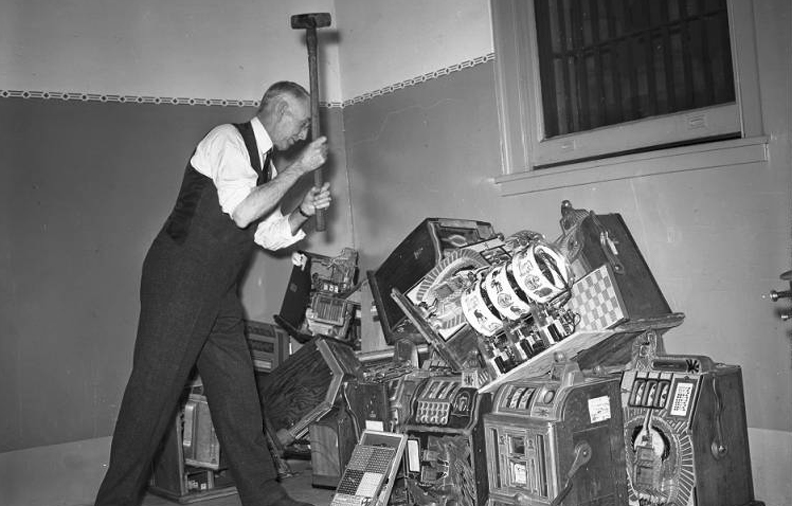
A Moral Squad member correcting the ills of society. Man using a sledgehammer to destroy slot machines. Creator: Savage, John (1903-1989). Publisher: The Durham Museum. 1938. But I wasn’t so sure that slots were washed up. The fact that our man Walsh was involved in this gambling bust gave some color to the country club history to follow. Very soon after the Thomas Walsh family would move Uptown and enter a new social circle.
The Country Club Walshes
When the Walshes celebrated their twenty-fifth wedding anniversary in 1936, they sent out invitations to 300 guests. This gathering was “one of the largest events on the social calendar.” The couple hosted the soiree in their new Fairacres home where the dining room glistened in white and silver…a mound of white button and giant chrysanthemums, flanked by crystal candelabra, centered the dining room table beneath a crystal chandelier. By the time the family had removed to their Fairacres home at 604 North 65th Street, they had hit an all-new stride.
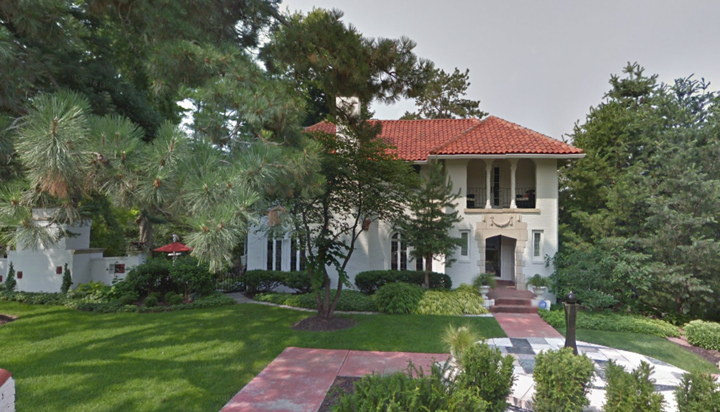
604 North 65th Street. Photo from Google Map. This desirous, Spanish style home was built in 1939, according to the Douglas County Assessor site but I believe it was constructed at least by 1936. Such a gorgeous home.
Starting a few years earlier I discovered the Parents Walsh commuting between Lincoln and Omaha where their then Teen Tommy would exhibit his horses “Golden Boy” and “Three O’clock in the Morning” at local horse shows. These proud parents were very lucky indeed, as their son was well liked by showmen and patrons. Tommy was every inch the horseman, suave, well poised and cautious and the press was taking notice. Considered a “mannerly, manly and unspoiled lad, good at his studies at Creighton Prep, interested in swimming, tennis and outdoor life in general, Tommy is a stickler for from in the ring from his silk topper and patent leather shoes to his white boutonniere.” In April of 1937 it was announced “seven horses have been purchased within the past few weeks by Tommy Walsh, 16 and his father, Thomas A. Walsh. All are show caliber.” After school was out, Tommy was thought to campaign some of them in upcoming shows. He would continue to compete regionally, with shows in Denver, Minneapolis and Chicago. And this was only the beginning for showman Tommy Walsh.
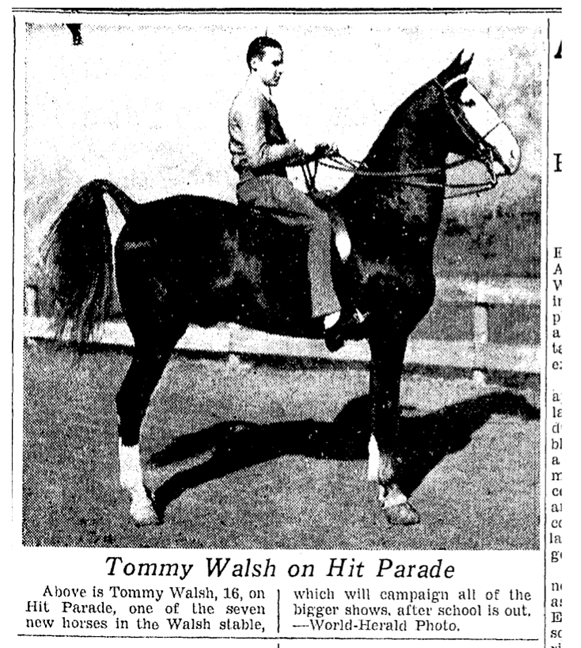
April 26, 1937, OWH. Tommy photographed. Mrs. Thomas A. Walsh with Mr. Walsh were to leave for Kansas City to attend the American Royal horse show where Tommy was to show his mare, Gorgeous Sweetheart. He would win many trophies in a short time span. Sadly Tommy would lose two of his prize stallions in a terrible fire at the Ak Sar Ben stables. Many horse lost their lives in this mysterious fire.
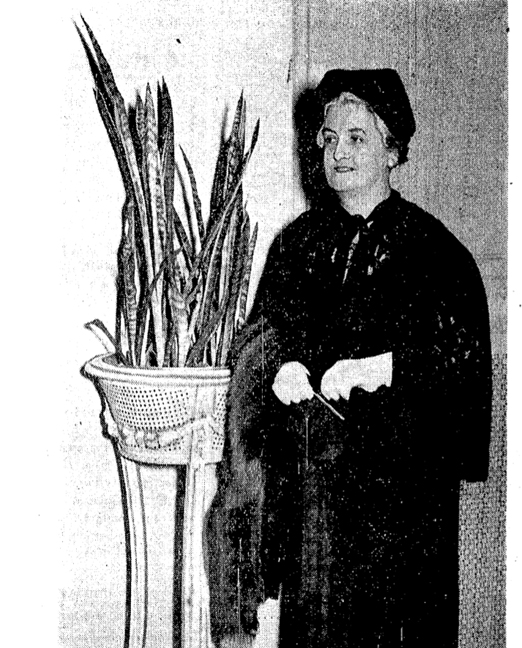
October 10, 1937, OWH. Our Mary P. Walsh is photographed, planning to entertain guests at an Ak Sar Ben horse show.
Thomas A. Walsh, Jr. Family
Thomas A. Walsh, Jr. would meet and marry Miss Marjorie Hall from Columbus, Ohio. Up to that time, Thomas Jr. was listed in the city directories as living with his parents on 65th Street as a “student, ” although away in South Bend, Indiana where he was completing studies at Notre Dame University.
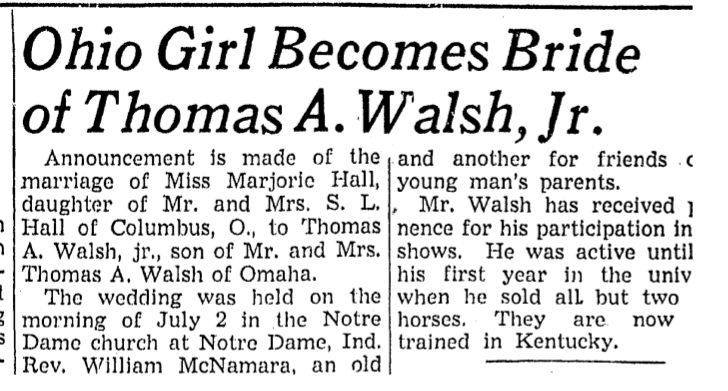
July 9, 1941, OWH wedding announcment. I believe the Junior Mrs. Walsh, perhaps, resided in the 65th Street home of the Senior Walshes when she gave birth to daughter, Mary Marjorie. I may be off on that point. With Tommy’s graduation six weeks away, the Junior Walshes planned to return to Omaha to live.
Death of Thomas, Sr.
When Thomas Walsh, Sr. died suddenly at home of a heart attack, it must have thrown the small family into a panic. I can’t imagine losing a husband and father at age 53. His son, Tommy, a senior at University of Notre and wife, Marjorie “Marge” would fly in by chartered plane. Little Mary Marjorie was one month old. The service was held at St. Margaret Mary’s church. “Body will lie in state at the residence,” as was custom. “Interment will be in Holy Sepulchre.”
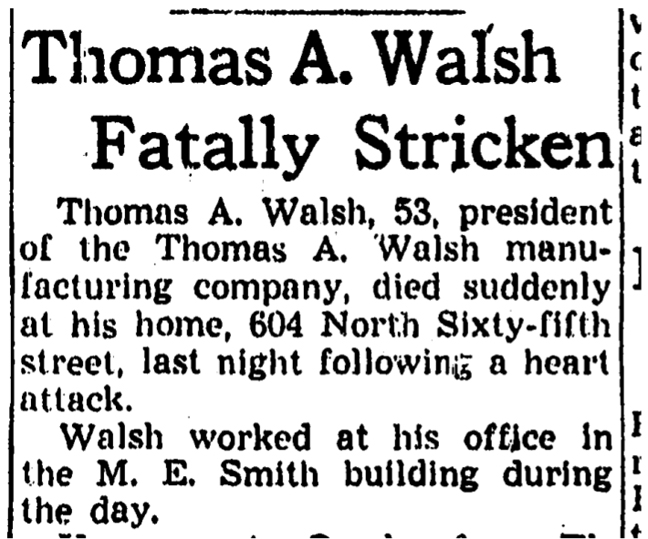
February 25, 1942, OWH.
Young Walsh rightly assumed the business of running Thomas A. Walsh Manufacturing Company within the week. He had not yet decided whether to return to Notre Dame to graduate in a few months or just quit school altogether to operate his late father’s company. Luckily for Tommy, it was announced that Notre Dame was to be used as a Naval training center and commencement exercises were advanced. This fortunate event allowed Walsh to get his Bachelor of Commerce degree from Notre Dame University and move back to Omaha to continue the family business. Walsh would later state he studied pre-law at the University of Notre Dame. One thing is for sure—he would remain active in Notre Dame alumni affairs, encouraging his offspring to attend his alma mater.
The Junior Walshes Get Settled
Upon return to Omaha, Tom and Marge Walsh bought a lovely home at 1510 South 80th Street in the Loveland Neighborhood. Tom was no doubt getting acquainted with the day to day operation of the manufacturing business and it appeared that Marge was a busy homemaker.

1510 South 80th Street. Photo borrowed from the Douglas County Assessor site. I know I always say this but I really need to revisit this home and write a story about it. I have a feeling there are mysteries needing to be solved therein. The original article from when the Walshes bought the home in August of 1942 read, “This home, 1510 South Eightieth Street, in Loveland, has been bought by Thomas A. Walsh, Jr. It was built by Howard H. Agee in 1940. Revenue stamps indicate the price at around $11,500. Stuht-Bedford Company handled the sale.” The curious home is even more beautiful with age. I love it!
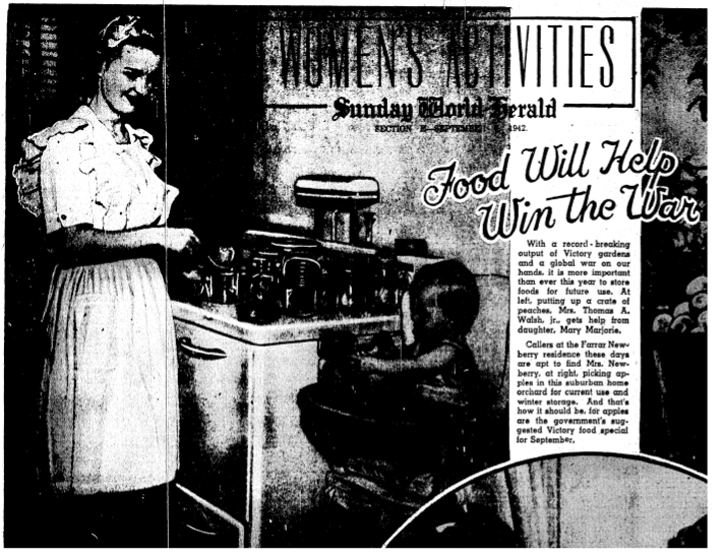
September 6, 1942, OWH. “Food will help win the war.” The beautiful Marge Walsh was featured in an article about women’s Victory gardens and war efforts. (And there is little Mary Marjorie in a high chair.) Here she is shown as the dutiful wife as well as American Woman, doing her part. For my part, I believe I could learn to cook better if I had a home like 1510 South 80th Street.
The New Walsh Residence
I bet you had thought I would never arrive at this rosy entrance gate. And with a drumroll…the local papers finally announced the Walshes had moved into 9301 West Dodge Road by early December of 1943. The headline read, “Walshes Take Home.” Their former residence at 1510 South 80th Street was purchased by Mr. and Mrs. C. T. Pender. Days into their new home festivities, Kathleen Hall Walsh was born to Tom and Marge. Mary Marjorie was then two years old. Imagine that sigh of relief, getting settled in enough time for a new baby. I like to envision our Manderley Mystery Mansion filled with sunlight, fantastic, new forties furniture and a young family with children learning to walk and the unexpected bellowing heard down the hall.

Vintage baby announcement from the early 1940s. Oops…it is BLUE. I do suppose that means this card was for a baby boy. I miss working in an antiques store and sorting through old cards with their yesteryear illustrations. (Thanks to Detective Marilyn for helping me to understand it is “antiques store” and not an antique store. Wink.)
I also couldn’t help but wonder if the McVeighs ever did build their horse stable on the grounds of 9301? And on that note, not that everyone who rides must know one another in this blessed town, but I dreamed that the McVeighs and the Walshes might have brushed shoulders through the equestrian relations. I would scour the historic aerials for proof of a horse stable through the years but never saw one.
Wartime Isolationism
I learned something new from an article in 1944. Unbeknownst to me telephones and telephone service were limited Stateside due to wartime restrictions. Personal telephone messages were often taken on a work phone and “relayed” to the person they were intended for once at home. The writer of the article named this telephone-less existence “isolationism,” but I did not find this was necessarily a national phrasing or a social epidemic. A fortunate home with a telephone on the block would also kindly relay messages to neighbors who didn’t have service. There was an article about a young couple getting relayed messages from their parents blocks away on their home phone. Walks to the grocery store or nearby drug store would allow one to make a call from their interior payphone.
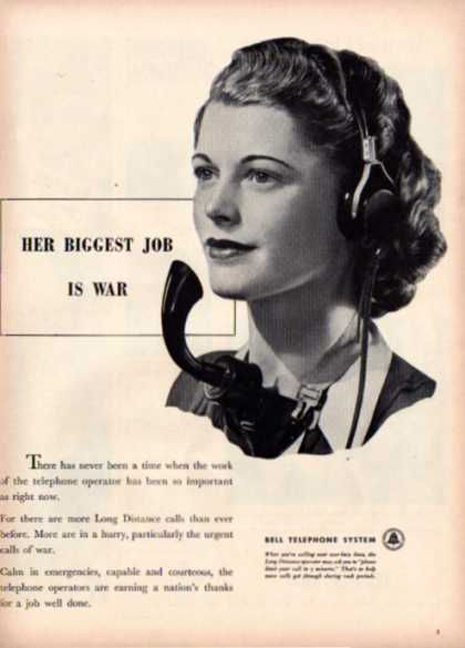
1944 Bell Telephone ad featuring a female operator.
Apparently there were waiting lists to be able to get a telephone in one’s home, even if a family had a line previously. This strange couple of paragraphs outlined the issue for the Walshes, who had obviously lost their service when they removed to the Dodge Street home.
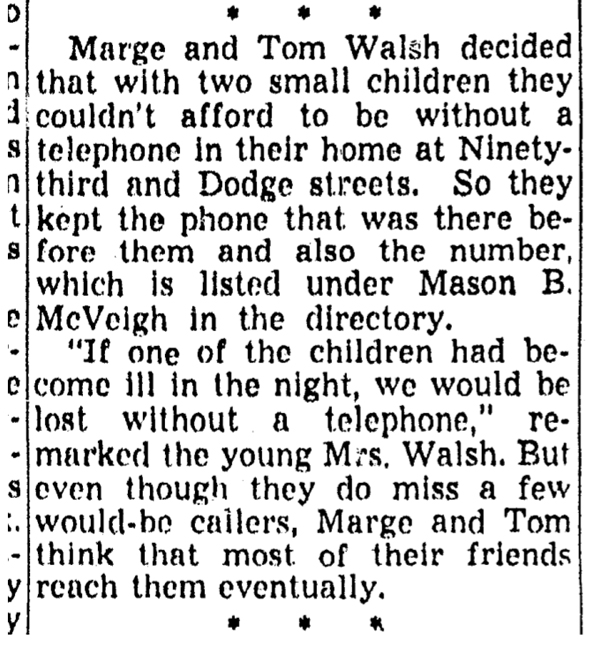
May 7, 1944, OWH.
Puzzlers of Interest
In July of 1944, Mrs. Thomas A. Walsh, Sr. “Mary P.” sold the family home at 65th and Underwood to Dr. and Mrs. Earl C. Montgomery, who were to move to Fairacres from Atlantic. Mrs. Mary was said to be moving to the Blackstone Hotel. Again, the storied residential hotel entered stage right.
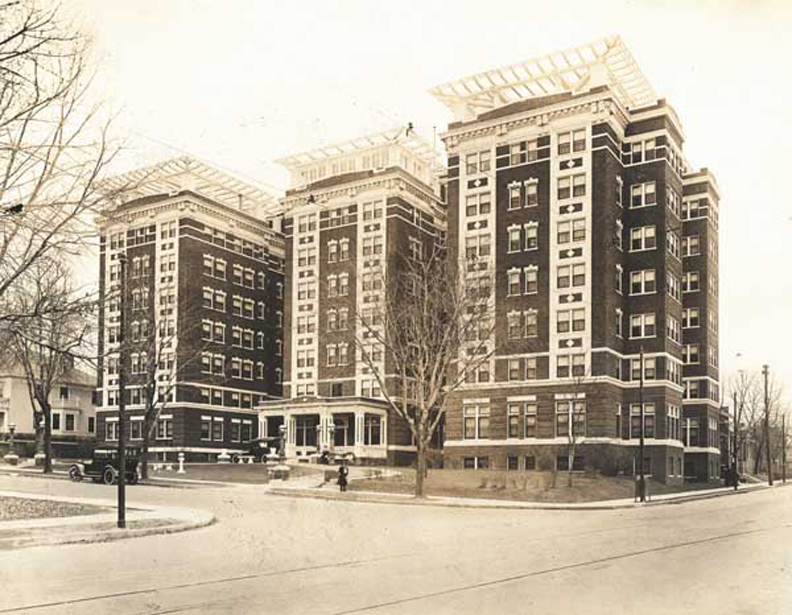
Charles Schimmel’s incredible Blackstone Hotel at 302 South 36th Street.
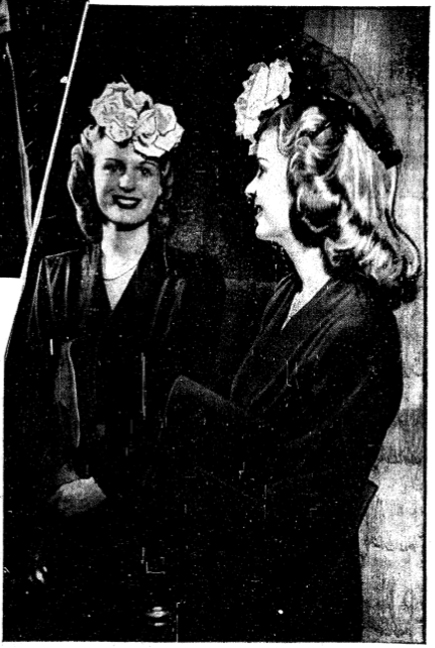
April 1945, OWH. I include this as a station break. You know how Miss Cassette loves her forties fashions. Mrs. Walsh seen looking in a mirror. “Easter Sunday morning will find Mrs. Thomas A. Walsh, Jr. trying on her new hat of white flowers with a black straw band. With it Mrs. Walsh wears an American beauty red suit and carries matching suede gloves and bag.” Splendid.
Meanwhile the Thomas A. Walsh Manufacturing Company was operating out of 201 South 10th Street, in the warehouse district. This building is no longer extant. It would seem that Tom Jr. continued at the helm of his father’s company, however I pondered the clues and timeframe. When exactly did Tom Jr. get his law degree and become an attorney? I already knew with surety that by 1946 Tom Walsh was the Deputy County Attorney. I would find he graduated from Creighton University School of Law and would go on to become a well-known trial attorney in Omaha, serving later as President of the Nebraska Association of Trial Lawyers. On top of all that, he continued to ride and show horses. I found evidence in the fall of 1946, Tom Walsh won the Chicago Horse Show when his horse, “The Invasion,” a black gelding, was adjudged “the champion five-gaited saddle horse.” How were all of these achievements so handily accomplished?
Pair of Tragedies
I was saddened to find that the young Walsh family did not escape personal trials in their early years at 9301 West Dodge Road. Thomas Arthur Walsh the III, the Walsh couple’s third child, was born in July 1945; months later I was shocked to find the infant had died in the family home of unknown causes.
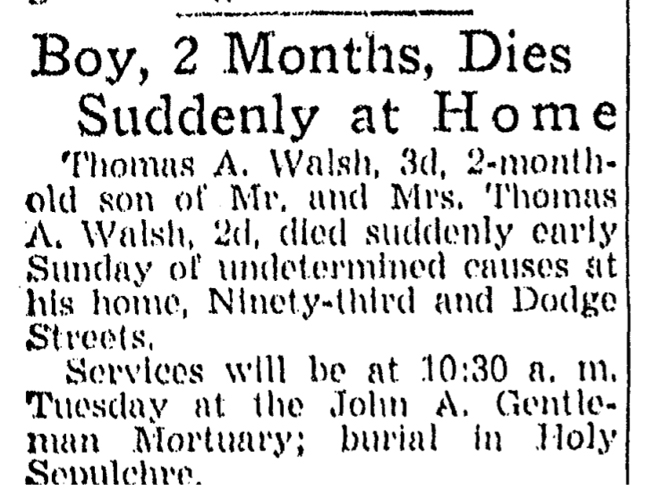
September 17, 1945, OWH. Baby Thomas Arthur the III dies at home.
Then in February of 1947, Tom’s mother would perish in a house fire. Mrs. Mary Walsh, 56, of 5235 Military Avenue died in fire, thought to have been caused by smoking a cigarette in her own bed. The Arson Squad reported she was found suffocated in the bedroom of her apartment. The paper described a neighbor had informed the investigators she smelled smoke at 5 a.m. on a Saturday morning but the alarm was not apparently formally phoned in until 5:45 p.m. that evening. Investigators believe the fire had smoldered more than 12 hours. My word, why did they include photos of such things in the old time papers? I will spare you. Services were held at the 93rd and Dodge mansion, later to St. Margaret Mary’s Church. Mrs. Walsh is buried at Holy Sepulchre Cemetery.
Initiation of an Advocate
I was fascinated to find a number of our old friends from articles past would gather forces in advocacy of what we’ll call the West Dodge Neighborhood. In November of 1947, Tom Walsh united with Gene Melady of 830 South 90th The Balla Machree PhotoBook article and Ray Matson of 321 South 90thI Wish I Could Have Gone To: Hilltop House story, when the neighborhood was under threat from an unlikely source. Residents of the 87th and Dodge Street area asked the City Council to prevent establishment of an impending city-edge trailer park proposed in their district. The neighborhood attorney said the residents believed “a trailer camp would completely ruin what is now one of the finest residential sections to Omaha.”
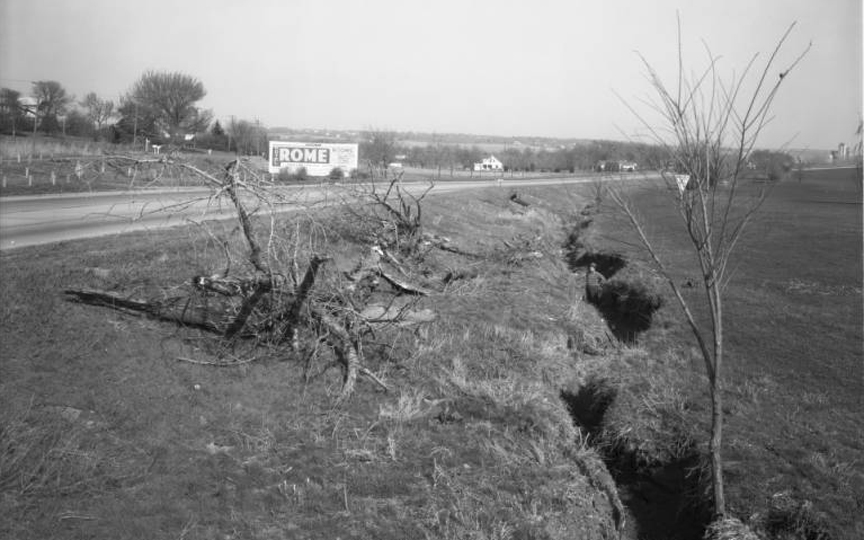
Looking east on West Dodge Road from about 90th Street. There is a man standing in a deep gully off to the right. There is a billboard for the Rome Hotel on the left side of the road. The area to the right was later known as the Indian Hill area, a portion of the Indian Hills Golf Course. Creator: Bostwick, Louis (1868-1943) and Frohardt, Homer (1885-1972). Publisher: The Durham Museum. Date: April of 1948.
Henry Glissman, operator of the Indian Hills Golf Course then on the south side of Dodge, planned “to establish the trailer court from 87th to 90th Streets. It will be a trailer park, one of the prettiest places in Omaha.” Gwyer H. Yates, former Omahan then living in California, owned the property of which Glissman had a twenty-year lease on. Ellick, a representative of Yates, negotiated the lease under the belief that Glissman intended to establish a nursery there. Apparently Yates was as surprised as anyone regarding the trailer court proposal.
It may seem odd to envision a trailer park on Dodge Street but in my investigations through the years, I have found proof of many trailer parks along early Dodge. Especially West Dodge Road, considered the outskirts of town. I even found evidence of a trailer court on the northwest corner of 72nd and Dodge, where the Crossroads Mall marquee now is stationed. I believe Tom Walsh and the neighbors were successful in stomping out this plan, which they believed unfit for their district. This was only the beginning for a neighborhood that would meet with serious pushback time and time again as free enterprise encroached further along Dodge, reaching its tendrils out into the country, soon consuming West Dodge Road. Woefully 9301 West Dodge would also find itself in a vulnerable position when it lost one of its biggest advocates years later.
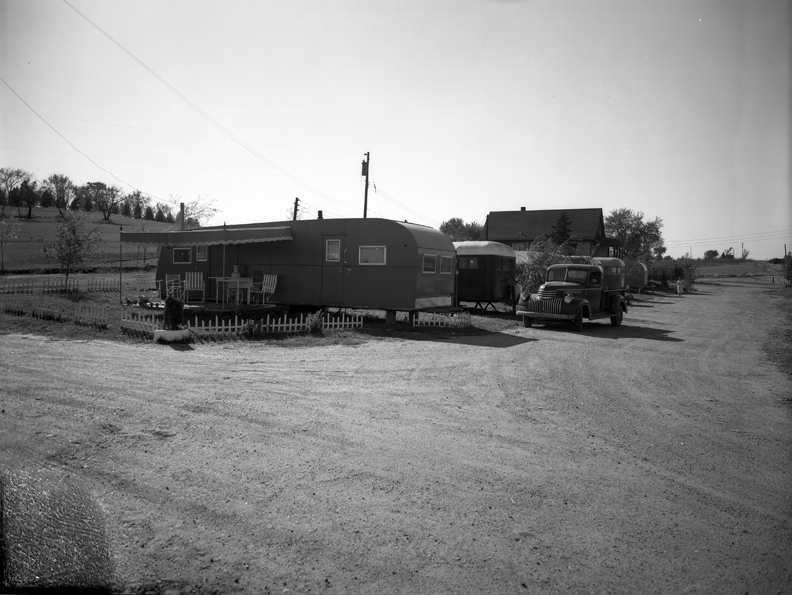
A trailer park somewhere on West Dodge Road. Great looking trailers and nice old pickup. Creator: Bostwick, Louis (1868-1943) and Frohardt, Homer (1885-1972). Publisher: The Durham Museum. October 1949.
My Favorite Clue
Since we are examining photos of West Dodge Road from this time period, I simply must get your opinion on something. This next photo is my absolute favorite. It depicts a man standing alongside West Dodge Road. The photographer is facing west, denoted to be standing at approximately 90th Street. I studied and studied this glorious shot.
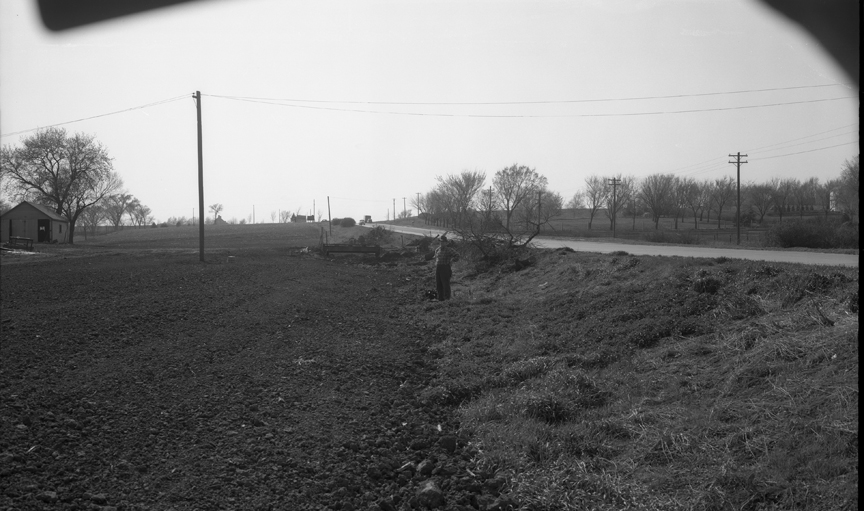
Looking west on West Dodge Road from about 90th Street. There is a man standing alongside the roadway. Creator: Bostwick, Louis (1868-1943) and Frohardt, Homer (1885-1972). Publisher: The Durham Museum. April 1948.
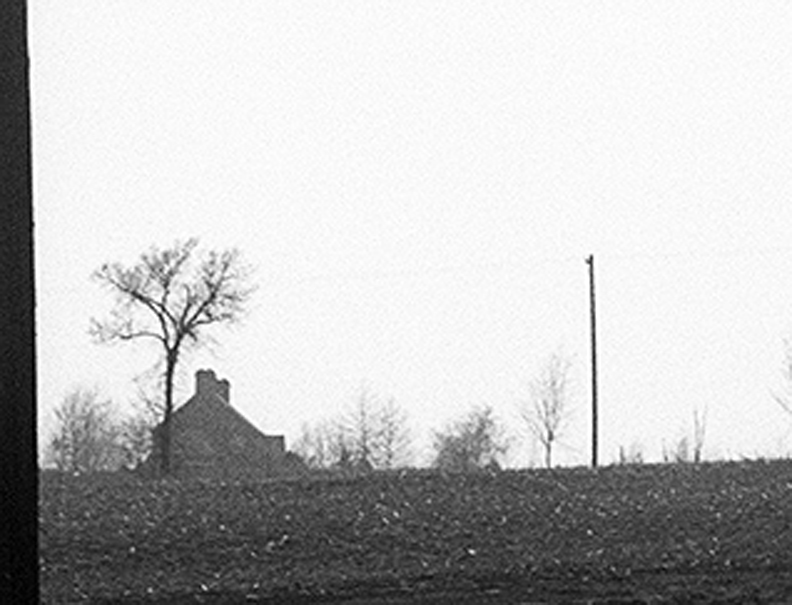
Detail of the Bostwick image that I neurotically honed in on. And there she is—I believe our only historic image of 9301 West Dodge Road. Those matching, well balanced, prominent chimneys. If one compares our original World Herald image, with this eastern elevation, one can see the similarity. 9301 West Dodge was reputed to be on high elevation also. I am willing to wager this is the Walsh house on the hill. Do you agree?

Black and white of the proud Georgian for reference.
Thomas A. Walsh Manufacturing Company Changes
Interestingly in September 1948, the Thomas A. Walsh Manufacturing Company closed a one hundred thousand dollar deal for acquisition of the Coca-Cola Company building at 3852 Farnam Street. And in case you were wondering, like I, if the Walsh firm was still in the punchboard business, their operation was touted as “one of the three largest manufacturers of punchboards and novelties in the country.” The new location was said to give the Walsh company additional space for manufacturing and storage. Also fascinating– how did I not know that 3852 Farnam, the old Brite Ideas Decorating showroom, once moonlighted as a Coca-Cola bottling plant?
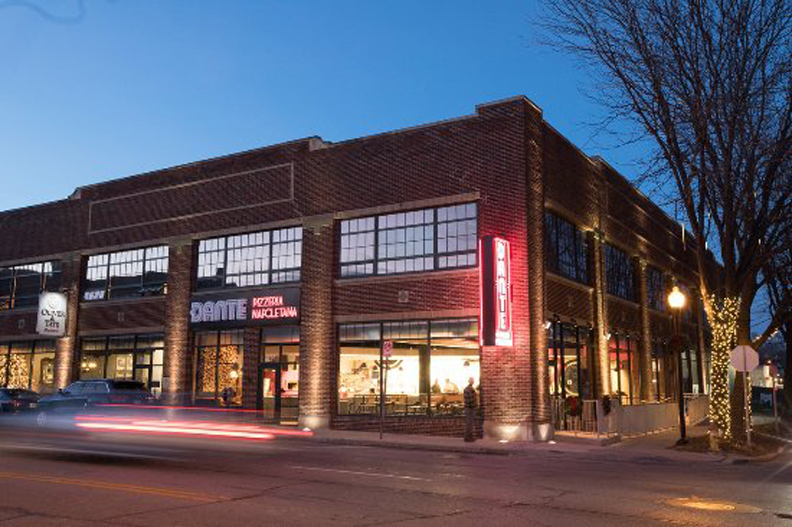
3852 Farnam Street. Photo borrowed from the Dante Pizzeria Napoletana site. I still remember the mystifying holidays lights and year-round glowing figurines of the Brite Ideas Decorating environment as well as the terrifying fire that destroyed said showroom in the early 2000s. It was so sad. The building now has a fresh life as home to Dante Pizzeria Napoletana and Olive & Tate Beauty Salon, apparently with some warehouse style condominiums above.
Not long after acquiring their new building in May of 1949, the Federal Trade Commission issued a complaint, accusing the punchboard-making firm with “engaging in unfair acts and practices violative of the Federal Trade Commission Act.” Tom Walsh was out of town and the matter was turned over the company attorneys. A spokesman said this was the first time in the 32-year history of the company that it received such a complaint. The FCC reported the punchboards and the pushcards distributed by the Walsh Manufacturing firm vary in detail. All involved the same chance or lottery features when used in making sales to the public.
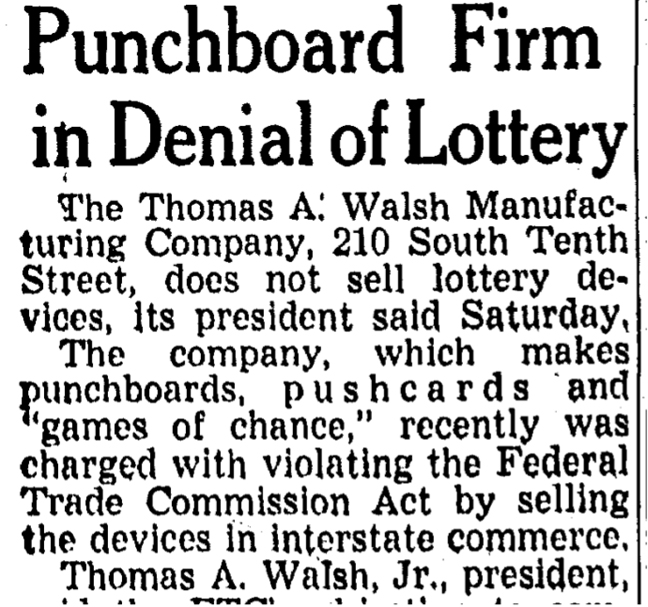
May 8, 1949, OWH. The company was charged with violating the Federal Trade Commission Act by selling punchcards, pushcards and “games of chance,” considered lottery devices in interstate commerce. Walsh said the FTC’s objection to company activities centered on awarding merchandise as punchcard prizes. “Lotteries do not enter the picture,” he argued because they were declared illegal many years ago. He called his firm’s output, “games of chance and that the FTC does not object if the prizes are cash,” he added. He hoped to explain its activities to the FTC at a hearing set later. An order to cease and desist selling the merchandise prizes may follow the hearing, he thought.
I couldn’t be sure if it was vexing from the FTC, court costs or the changing times but the Walsh Manufacturing Company wouldn’t complete their move from 201 South 10th Street to 3852 Farnam Street until August of 1949. Then about six months later, Tom and Marge Walsh would mysteriously sell their new building at 3852 Farnam.
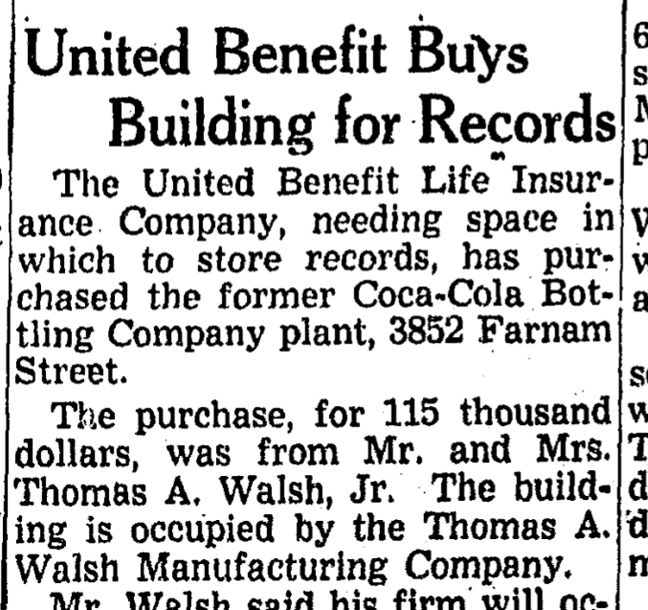
March 8, 1950, OWH. Not long after, the United Benefit Life Insurance Company bought 3852 Farnam for $115,000 from the Walshes. Tom Walsh reported his pop’s manufacturing business would occupy the building under lease for six months or until he found other quarters but it sounded fated to Miss Cassette. The purchase included the building and 70 feet of vacant land west of it. This is still vacant land, for the record—the coveted parking lot for the incredible Tudor Arms condominiums on 39th Street.
Perhaps it is time for an intermission and a nice, long stretch. I know I need a regroup myself. We are going to be headed into some real real estate nettles and I will need to have my head on straight to steer this wandering buggy.
1950s Mix Up
The 9301 West Dodge Road deed “began” in June of 1950, when the Dillon Company sold to Thomas A. Walsh Jr. and wf. Initially I believed the house might have been built in 1950 when I dug into this gorgeous mess. Twas not so. The deed was created when the house was lifted from the recesses of the Lands File and absorbed into the Westchester Addition, formally. For the record Robert Dillon, of the Dillon Company, was president of the Omaha Chapter of Association of Home Builders and a well-known real estate man and builder around town, having initiated the Dillon’s Fairacres Addition. A brief mention of the H. A. Jacobbergers, who in 1950 made the news for their purchase of a lot in the Westchester Addition on 92nd, would connect the dots for me. Let me attempt clarity. In June of 1950 yet another group purchased the Ninetieth Street Realty Company, owners of the Westchester Addition. They were Robert W. Dillon, president; Laurence Myers, vice-president and Ted Hicks, secretary-treasurer. (We are no strangers to these characters in the My Omaha Obsession files.) This new trio bought 92 acres, lying between 90th and 96th Streets and Dodge to Harney. The three Omahans planned to plat about 50 lots on this swath, taking up the devised plan of the earlier group. Of note the Ninetieth Street company was purchased from Tom Walsh, Harry Jacobberger and Francis Jaccobberger. It was all somewhat confusing. They must have bought it in the interval.
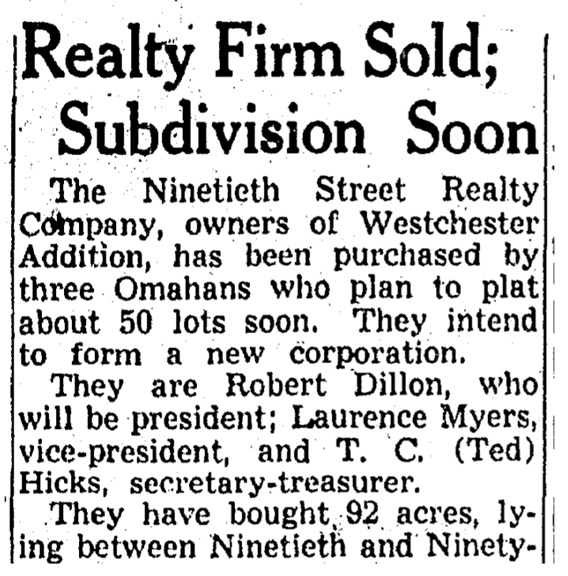
June 18, 1950, OWH.
In the late summer of 1951, a grouping of three couples hired the Howard Thomas Engineering Company to survey their land. Dr. Ben F. Ewing and wife, Mary A. D. Ewing, Thomas A. Marjorie C. Walsh and Fred D. Moshier and Vivian M. Moshier were the landowners. I understand from Detective Moshier, a relative, these couples were neighbors and had been met with some conflict over this development.
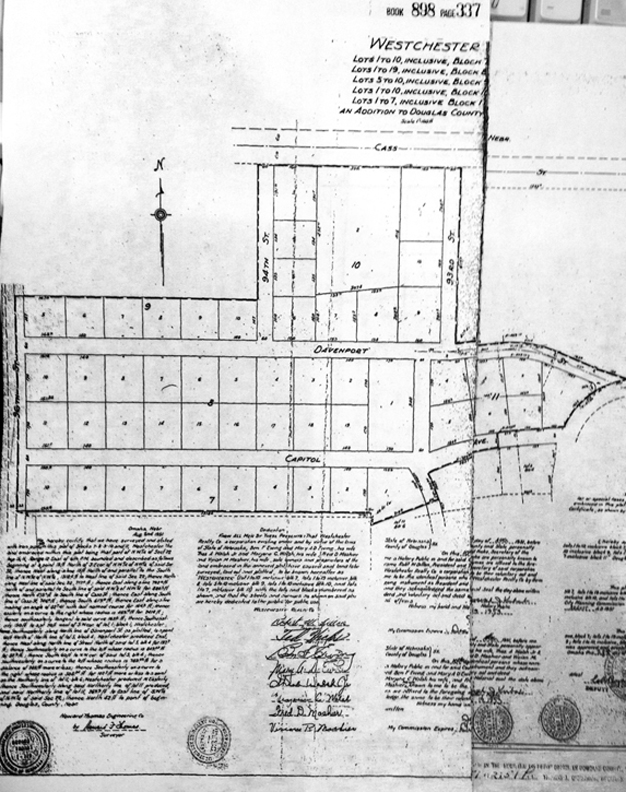
Westchester Addition signed August of 1951. Sorry so wonky. I cobbled this map together from docs found at the Deeds Office.
Their plan was to have their joined properties platted into the yet another Westchester Addition—specifically Blocks 7, 8, 9, 10, 11. Ultimately Robert W. Dillon President and Ted Hicks Secretary of Westchester Realty Company headed up the group. A review of the deeds within Westchester Addition showed Dillon began selling a multitude of lots as the Westchester Realty Company in 1951. Most of the Mid-Century Modern Ranches found encircling 9301 West Dodge were built from 1952-1955.

Map of the Westchester Addition borrowed from the Douglas County Assessor site. There are ten homes, mostly Ranches bordering our Walsh estate; their backyards abut the perimeter of the 9301 property.
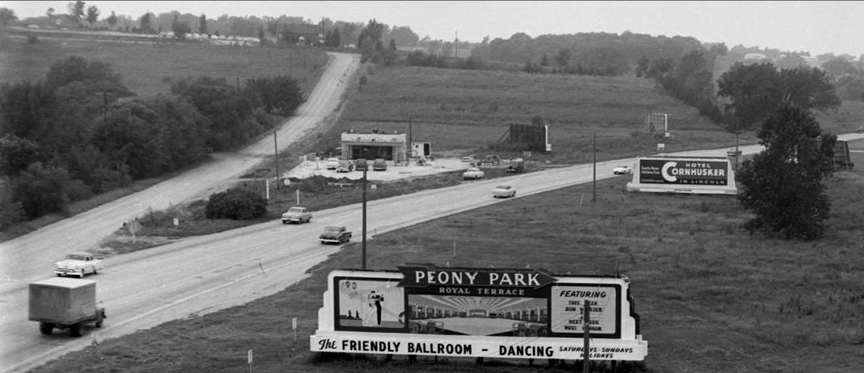
1950. Labeled, “High shot looking west at Dodge Street and West Dodge Road where they fork off.” I share this image to shed light on how remote and pastoral this portion of town still was in 1950. Signs on the side of the road read “Club House Inn, Steaks, Chickens”, House of Color, 2816 Harney St., Mautz Paint”, Peony Park Royal Terrace, The Friendly Ballroom, Dancing, Saturdays-Sundays, Holidays”, “Hotel Cornhusker In Lincoln”. Creator: Savage, John (1903-1989). Publisher: The Durham Museum. 1950
The Mystery Business and Walsh’s Other Career
As of 1950, “Omaha’s sole punchboard factory has been out of business for nearly a year.” The Walsh produced punchboards were no longer…or were they? Strangely the 1954 City Directory still listed the Thomas A. Walsh Mfg. Co at 38th Ave. and Farnam, under games, calendars, and novelties. In 1951 I found a quote straight out of a crime magazine. It spoke to how Clean Omaha was becoming. “Punchboards may represent a billion dollar racket nationally but they’re scarce in Omaha. The continued gambling ban apparently has pinched off a once flourishing business. This was clear Saturday after a tour of the town’s pool halls and bookie joints. A reporter who visited 11 such places found no evidence of punchboards. The Morals Squad head, Walter Wilson reported he hadn’t seen any in months. Some pocket size punchboards were being circulated through the mail. One veterans’ organization had been distributing small boards in this manner. Recipients were asked to sell the boards, turn in proceeds for two prizes: one for the winner and one to keep. Mr. Walsh reported his equipment was sold to purchasers all over the country. ‘I know no punchboards are being made in Omaha,’ he said. Interest centered on punchboards after Senate Crime Investigators threatened an interstate ban.”
I suppose once the company was targeted by the Morals, it was just as well that Walsh moved on. He had a full law career after all. Did I happen to mention that Tom Walsh had a chauffeur? It is true. Newton Knight was his name. By 1955 the City Directory showed Tom Walsh had a practice in the Service Life Building. In the sixties he was partner in the Wear, Boland, Mullin & Walsh firm. Later Boland, Mullin, Walsh & Cooney. Meanwhile our Marge Walsh would attain a Master of Arts in English from Creighton University. Remarkable considering how large their family had grown. Speaking of which, let’s have a brief review of the Walsh family in one moment. But first…
New Neighbors
In the early years of the Twin Oaks estate and even the subsequent Walsh decades, the Roy and Mae Stromberg farm had been located on north 93rd and Dodge. This pastoral view surely aided in the relaxing atmosphere of early Westchester. By 1954, however, plans were being developed for a new church building directly north from the Walsh estate on a four and a half acre plot, said to rest on a slope. St. Timothy’s Church carries the address of 510 North 93rd Street currently. Groundbreaking ceremonies were held that winter and bids for the construction were to follow in March of 1954. By January of 1955 the church was fully functional accept for that matter of their access road. North 93rd at Dodge offered a graveled road, which would later be paved for the congregation after a four-year struggle with the city. In 1967 St. Timothy’s planned for a new expansion. For all I know St. Timothy’s and the Walshes enjoyed a harmonious relationship but it must have been exasperating to watch the countryside swallowed up around them.
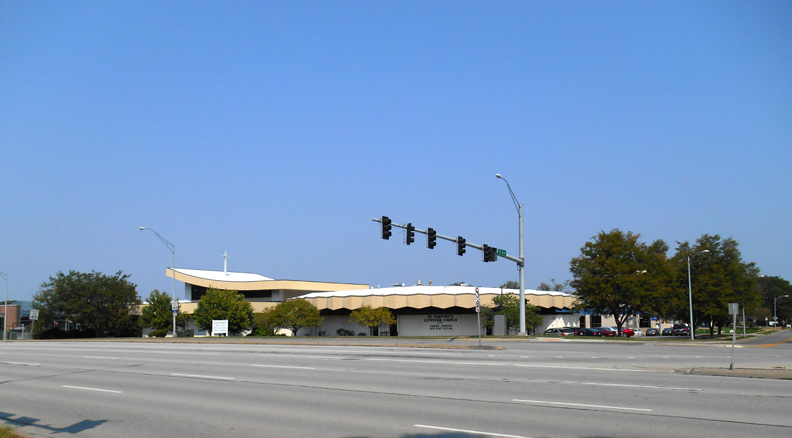
St. Timothy’s Church at 510 North 93rd Street, as it looks today.
The Walsh Girls
Maureen Francis Walsh’s birth announcement in 1956 stated that she was the fifth daughter born to Tom and Marge. I realized I had been remiss in accounting for the family, what with all of the punchboards. Mary (Marjorie), Kathleen, Colleen, Melanie and Maureen appeared to live the childhood of dreams in one of Omaha’s leading families. Of course we already know this Family of Standing inhabited a distinguished showplace, imposing and far removed from Regular Omaha. The girls’ youthful activities were written about and photographed, as their parents before them, in the Social Pages and reflected a charmed positioning. Of course most young people have no orientation to their social whereabouts. (Just consider playing tag on that front lawn and not knowing how good you had it.) Omaha County Club identification, well appointed capers, symphony debutantes, princesses at the Ak-Sar-Ben Coronation Ball, Duchesne Academy students, travels abroad, recognized scholars, future Junior League, dignified engagements. The correct boxes were better than checked. The girls were socially engaging, intelligent and well bred; the family’s standing allowed for wonderful opportunities. There was even a story of little Maureen playing a piano duet with President Harry S. Truman at a private Walsh Party at 93rd and Dodge. There were so many cute photos to choose from. Here are a few great photos to highlight the adventures of the Walsh Girls.

August 2, 1959, OWH. Bill Dickhart thought fear was the biggest obstacle for a diving beginner to overcome. And there is a little Congressman Brad Ashford, son of Mr. and Mrs. John D. Ashford; Joey Holly (cutest name ever), son of Dr. and Mrs. Roy G. Holly and Melanie Walsh, daughter of Mr. and Mrs. Thomas A. Walsh, Jr. were some of his more courageous pupils.

Oct 1963, OWH. Engagement of Mary Marjorie to Ensign John Michael Green of Beaumont, Texas. Miss Walsh, a graduate of Duchesne Academy and of St. Mary’s College of Notre Dame. She was a provisional member of the Junior League of Omaha. Granddaughter of Mr. and Mrs. S. L. Hall of Columbus, Ohio and of the late Mr. and Mrs. Thomas A. Walsh of Omaha. Ensign Green, a graduate of the University of Notre Dame, is at present attending Officers’ Supply Corps School in Athens, GA. They were married at Christ the King Church.

August 8, 1965, OWH. Golf, fishing, and horseback riding were vacation fare for the Thomas A. Walsh family during a three-week outing at Sun Valley, Idaho. Pictured at the resort’s outdoor skating rink during a practice session is Mrs. Walsh with three of the Walsh daughters, Maureen, Melanie and Colleen (left to right).
Walsh’s Protest
July of 1958 brought the first of many rezoning issues to the area of 90th-96th along Dodge Street. This is where we will begin to take Rezoning Notes.
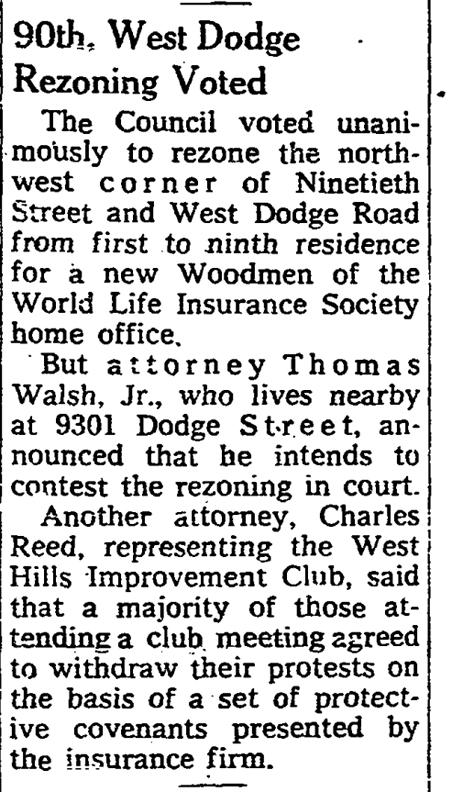
July 1958, OWH. After the City Council voted in favor of rezoning 90th and Dodge for the proposed future home of Woodmen of the World Life Insurance Society, Tom Walsh spoke up, saying he intended to contest. Walsh lodged a protest, emphasizing he was “not against progress or growth of the city” but believed the application called for spot zoning. Spot zoning would single out a parcel of land for rezoning, rather than a blanket rezone. It is presumed and understandable that Walsh was speaking to the integrity of the neighborhood. Who were the West Hills Improvement Club members, I wonder?
Sliver of Proof
I found an unusual article, offering photographic proof that our glorious 9301 West Dodge Road estate did not have the set of brick columns and the wrought iron gate it has at present.
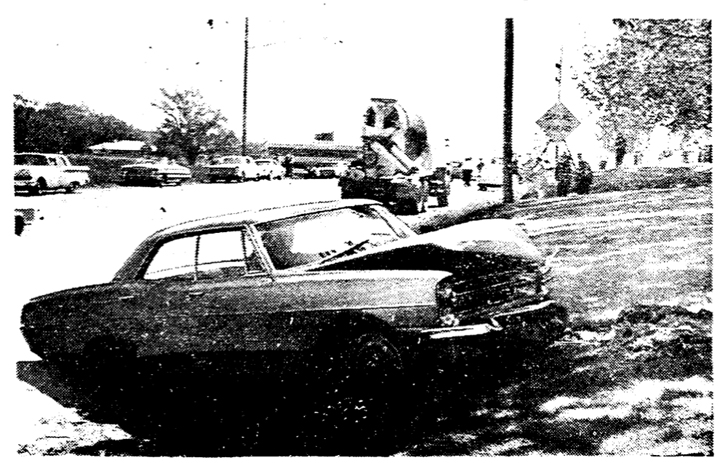
OWH May of 1967—accident in front of 93rd and Dodge show that there was no formal fencing in front of 9301 West Dodge Road, unless it was set back from the property’s edge. The car apparently went careening into the lawn. Across the street one can see there was still a family home further east on Dodge.
The Peculiar Pointer
Evidence would show that Walsh and neighbors would continue to fight off the rebrand of their beloved country estates by way of West Dodge Road. But then, all at once a strange signal that the Walshes wanted to vacate. In October of 1970, I found an advertisement for our 9301 West Dodge Road property. After all the decades, was the uphill battle too much to fight off? Did the Walshes read the writing on the wall for West Dodge?
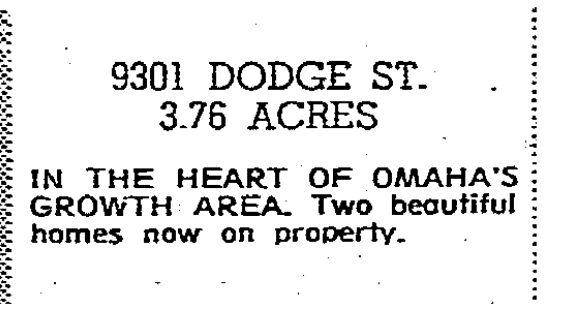
Advertisement from Oct 25 of 1970. 3.76 acres and two homes on property. What was this business of two homes on the property? I surveyed the historical aerial photographs and could not find a clear image of a second home. I wondered if the west wing, originally servants’ quarters had been made into a mother in law’s home? I was so surprised with this announcement after Tom Walsh’s protestation. In the words of Mr. Cassette, “Well, you can’t take a left on Dodge. You’re kind of trapped in there.” Hmmmp. Wrong answer, Mr. Cassette. These Plain Jane ads would run until July of 1971 and were marketed under the business sites/investments real estate section, which bothered me all the more. If you can’t beat ‘em, join ‘em? That definitely signified to me that the Walshes were throwing in the towel. But all the more curious, why did the real estate ads end in July of that year? Oh Sherlock!
Sad Indication
The saddest news of all came when I found a surprising obituary for Tom Walsh. Like his father before him, Thomas Arthur Walsh, Jr. died suddenly in his early 50s of a heart issue.
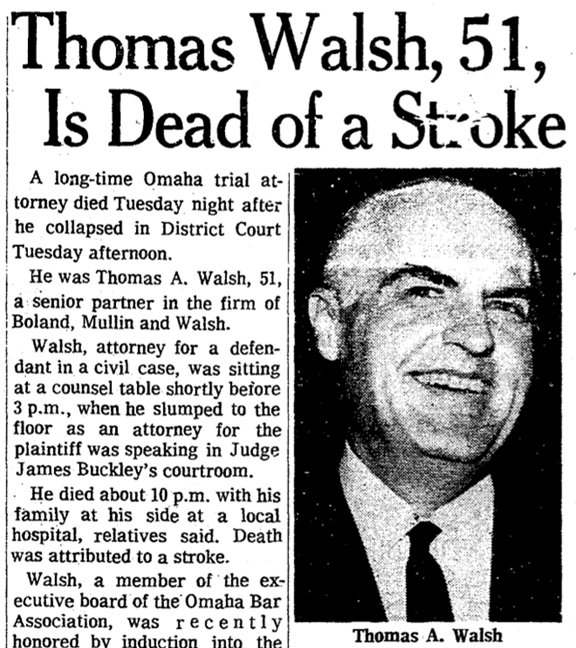
March 29, 1972 Thomas Walsh, 51, Is Dead. I was stunned. Selfishly, I knew that was probably it for the mansion. I had a tiny glimpse of hope when I found “Mrs. Marjorie C. Walsh” listed as owner in the 1973 City Directory.
“D. J. Witherspoon” abruptly would appear within some clues for 9301 West Dodge Road. The Witherspoons as in Witherspoon Mansion in Regency fame? This was another childhood obsession of mine ever since my grandmother had tipped me off to a dreamy-worthy, pink heart-shaped bathtub found in the Witherspoon Princess Wing at a party she had attended. And there was more—she had elaborated on the underground bowling alley and a swimming pool complete with private bathhouses. Panting aside, I couldn’t understand the connection to the 93rd and Dodge home. After tracking down the actual Warranty Deed paperwork from the Douglas County Deeds office, I found the verification I was needing. “D. J. Witherspoon and Marjorie C. Witherspoon (formerly known as Marjorie C. Walsh), husband and wife, herein grant…” I do wish I could consult with my favorite grandmother on these pressing matters of importance! Our Marge had evidently remarried Mr. Witherspoon. I knew the investigative trail was branching off to a new footpath in the snow. Did you bring your snowshoes, perchance?
Part Two
The Witherspoon Connection
The story goes that after Tom Walsh’s death, Marge was busy volunteering on the Ak-Sar-Ben Women’s Ball Committee and met D.J. Witherspoon, who had recently lost his wife to cancer. Dyrus, “D. J.,” “Jim,” or “Tex” Witherspoon, as he was called, was the founder, chairman and controlling stockholder of the Omaha-based Pamida, Inc. Despite his pleasant to the ears Blue Blood surname, Witherspoon was actually a farm-reared Midwesterner. Fortune Magazine would give its 1972 readers much to scratch their heads about when they offered an account of this Midwestern Millionaire in their article entitled, “Pamida Doesn’t Know What It’s Doing but It Sure Make a Lot of Money.” They called Pamida the “most successful of a number of regional discount-store chains.” Witherspoon’s holdings in Pamida and his various trusts he had set up for his four children were worth about $95 million. “Sales of Pamida stock since the first public offering in 1969 have brought in another $22 million,” the magazine said. Many in Omaha, perhaps, had never heard of Pamida, the discount store chain or his Gibson Discount Centers, but everyone, including a young Miss Cassette, seemed to be up to speed on the Witherspoon Mansion, at 9909 Fieldcrest Drive, a $3 million, 18,450-square-foot, 52-room mansion on the southern most border of the Regency Neighborhood. The home was designed for Jim’s wife, Hillois but had not been completed when she became ill. Mrs. Witherspoon died in May of 1971 of cancer; Jim had hired work crews to complete the mansion round the clock, so that her last Christmas could be in the home of her design. There was also the glorious Witherspoon Concert Hall at Joslyn Art Museum, named for the family after a $1 million gift to the museum in 1970.

Witherspoon Mansion at 9909 Fieldcrest Drive in better times. Send Me!
Thanksgiving Day of 1973 Mrs. Thomas A. Walsh and D. J. Witherspoon were married at Mount Michael Abbey in Elkhorn. The couple would travel to the Greek Island, Portugal and Spain for their honeymoon with plan to return and live in the fabled Witherspoon Mansion. By the by, the Witherspoons lived in the mansion until 1992, enjoying their blended family and many grandchildren. Of interest, the couple donated the Witherspoon Mansion to the University of Nebraska Foundation in 1981 but after they moved out, another couple bought the home. Then there was that mysterious fire and subsequent razing in the early 2000s. It was all so heart wrenching for those of us who grew up loving and dreaming of this stone mansion. For the completists in the bunch, Jim Witherspoon passed away in 2000 and our lovely and stylish Marge Walsh Witherspoon passed away in California in 2006.
A Matter of Complication
But allow me to retrace my steps. I would find the original document from the Estate of Thomas A. Walsh, Jr., Probate of Will. This official paper was signed by a judge in September of 1973 and appeared to forever change the history of 9301 West Dodge Road. It became a little less upsetting, in retrospect, having discovered the Walshes had obviously intended to sell the 93rd and Dodge home some time earlier.
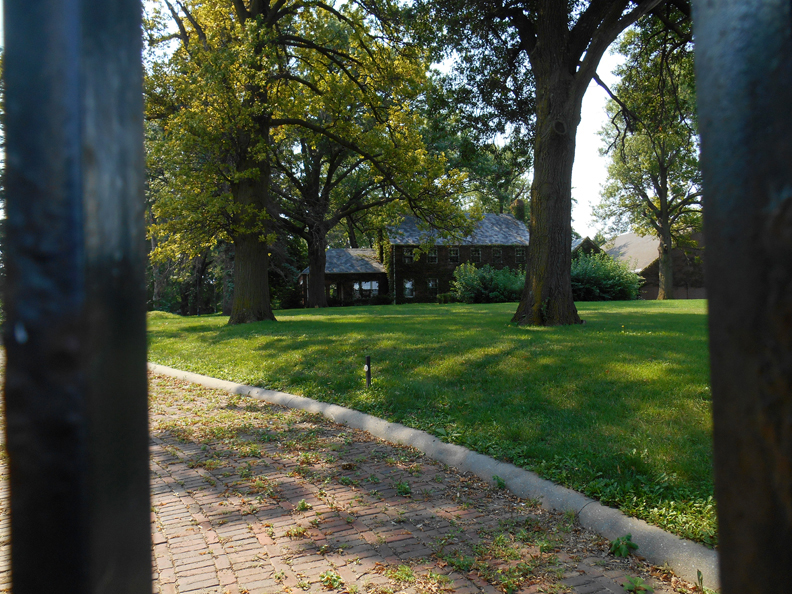
This all consuming tickler!
Enter Duane Dowd
I would light upon Mr. Duane Dowd as I followed the mystery trail. An attorney and as it turned out, big time local landowner, Dowd would play a fundamental role in the future of our 93rd and Dodge mansion. However as I would put together, the idealized strategy between Dowd and his partners never came to pass. I was quite surprised to hear of their end goal for the once regarded Twin Oaks estates but did not understand the relation to Mrs. Walsh Witherspoon. These years were quite a muddle for me initially and for the sake of brevity, I won’t string you along into every darkened corner.
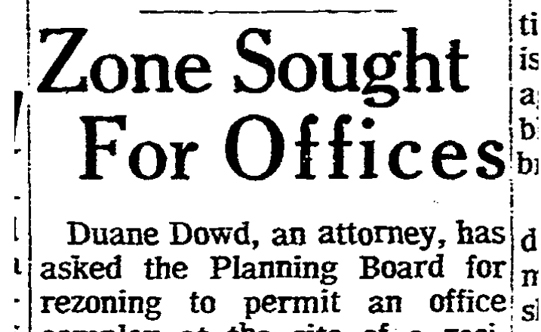
Oct 16 of 1973, OWH. In the fall of 1973 Duane Dowd would ask the Omaha Planning Board for a rezoning to permit an office complex at the site of the McVeigh-Walsh residence at 9301 West Dodge Road. He proclaimed to be the main backer of the project, which intended to refashion the residence for offices and proposed to construct two office buildings, 2 1/2 stories high with parking for 110 vehicles on the large grounds. At that meeting Dowd had no cost estimate or proposed amount of floor space for the buildings. The request was to rezone from first residential to seventh. The timetable for construction was dependent on whether the board and City Council approved the rezoning.
Westchester Neighbors Unite
The City Planning Board, after hearing neighborhood opposition, voted 3-1 to recommend that the City Council deny a request for rezoning, which would permit the development. “I think the time has come in Omaha when our city officials recognize the wishes of property owners beyond those of persons seeking to make money for themselves,” said attorney Thomas Burke, 331 North 93rd Street. Burke was president of the Westchester Homeowners Association. “I would have no neighbors but automobiles and parking spaces,” said Louis T. Carnazzo, 331 North 94th Street. “John Delehant, attorney for the developer, said ‘the property is shielded by thick trees and shrubbery’ and said ‘the development wouldn’t greatly affect neighbors.’” Mrs. Marjorie Walsh apparently still owned the home. City Planning Board member A. B. Pittman favored the rezoning, saying “Dodge is being widened and is expected to carry 125,000 vehicles a day. The area of the Walsh home isn’t residential.” It is interesting to note, for our timeline, that this was the official or soon to be, perception of West Dodge Road in the early 1970s.
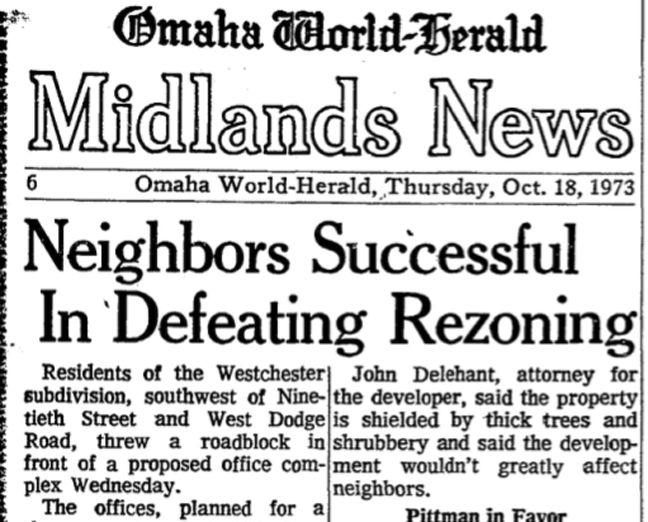
Oct 18, 1973, OWH.
The Attorneys’ Plan
The 1974 City Directory showed 9301 West Dodge Road was officially vacant; meanwhile there were other hearings for the rezone of the estate from residential 1 to R9 and P1 (ninth residential and first parking). Fact finding mission affirmed first residential is the most restrictive residential category and ninth residential permits office buildings. Marjorie C. Witherspoon also went on record asking for the change so the home can be converted to office use. It was with this fourth article that I came to understand the plotline between The Former Lady of the House and Attorney Dowd. Dowd purportedly had a contract to buy the property subject to rezoning, stating that he and “three or four other” lawyers would have offices in the house. Parking would be provided for about ten cars, he said. I wondered what became of the 110 spaces? A small sign identifying the offices would be placed on the property, but the exterior of the home would not be remodeled, he confirmed. Planning Board member, Dr. A. B. Pittman, again tangled with the Westchester subdivision residents when he requested an opening of south 96th Street off West Dodge Road near a property he owned. The Westchester residents feared this opening would damage the subdivision’s residential character. Pittman complained the people of Westchester were “Anti-everything.” (Currently south 96th Street is open and is a thoroughfare to Regency but can only be accessed if one is traveling east on West Dodge Road. Curiously a West Dodge Frontage Road extends just short of 94th Street.) For their part the Westchester neighbors and their attorney, Robert Skochdopole wanted the once grand 9301 property to be sold for residential use “if the owner makes a sincere effort.” Skochdopole stated Westchester remained “one of the most sought after” residential areas.
Ongoing
John E. North, representing Witherspoon, said the proximity of busy West Dodge Road precluded continued residential use of the home. Dowd would offer to sign an agreement with neighbors stating there would be no attempts at further commercial development for at least five years but no one seemed happy with that. 60 opponents attended the hearing in 1974; 221 opponents signed a petition. The plan was again shot down in a Planning Board vote 4-0 to recommend against commercial rezoning. Board member Paula Wells, noting that the 9301 home had been up for sale previously as “commercial” property said “the owner should make more serious attempts to sell it as a home.” This brought me back to the mysterious Tom Walsh ads from years earlier and how I had wondered why they ran as commercial opportunities rather than as a home.
Neighborly Nail in the Coffin
9290 West Dodge Road, now the Great Western Bank corporate offices, was originally another large country estate featuring a stone home. I believe that of the Lippolds. In the winter of 1974, this land offered as “Ideal future rezoning potential.” A building permit was filed in the fall of 1985 for the foundation and footing of the unremarkable four-story structure, later named The Mark Building.
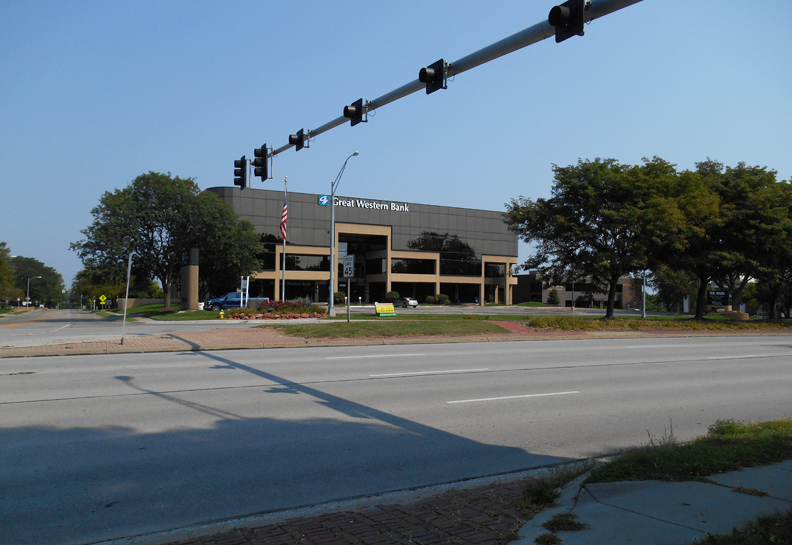
2018. How the Mark at 9290 West Dodge Road presents today.
Stranger News and a Potential Connection
In 1975, Jim and Marge Witherspoon would sign Lots Two and Three of the 93rd and Dodge home over to
Duane J. Dowd
Frances Dee Dowd
Sally L. Farnham
Charles H. Truelsen
Janet Truelsen
Patrick F. Moylan
Georgia C. Moylan
as “tenants in common.” All held an undivided 1/8 interest except for Sally L. Farnham, denoted at 1/4 interest. The curious instrument was signed in January of 1975. I couldn’t understand why the party of seven had bought the large parcel, knowing what they were up against with the neighbors.
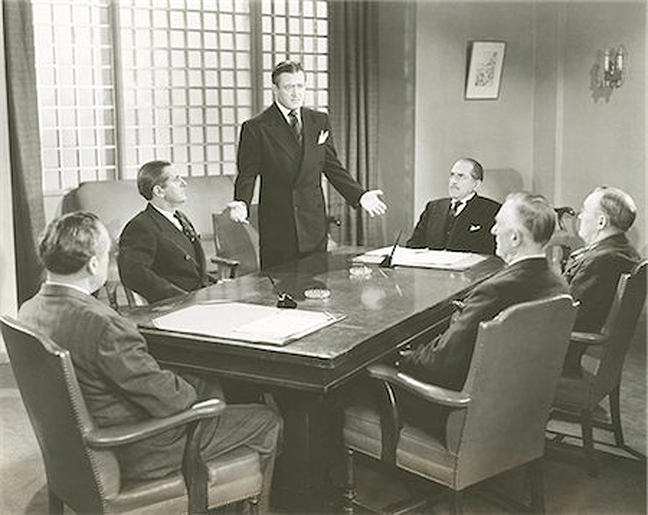
I would review the 1975 City Directory. Duane J. Dowd and his wife, Frances D., resided at 8109 Hickory Street, possibly my biggest crush house in recent times.(Do a drive by, as soon as humanly possible if you want to see a view of perfection.) The directory also logged Mr. Dowd as an attorney at 9700 West Dodge Road. I involved myself in a surface-y dig into the other names on the deed, discovering they were also attorneys. Charles Truelsen had his practice at 9700 West Dodge Road, same as the Dowds; Patrick Moylan was a partner in Farnham & Moylan according to the 1978 directory. The 1979 directory exposed Harry Farnham, Sally’s husband, was a lawyer at Farnham & Farnham also at 9700 West Dodge Road. Perhaps another connection between these new owners and the Walshes was that of the elite class horse-breeding world. As it turned out, Dowd was a champion Nebraska-bred horse owner. “Four Way Split” was a big Michigan Derby and Ak-Sar-Ben purse money hero in the early 1970s, having been bred on the breeding farm of none other than Harry J. Farnham of Elkhorn. Mr. Farnham was also Nebraska’s Racing Commissioner. Dowd and Farnham followed a similar path with the success of racetrack favorite, filly “Tudor Trio.” Dowd and Farnham were also former law partners.
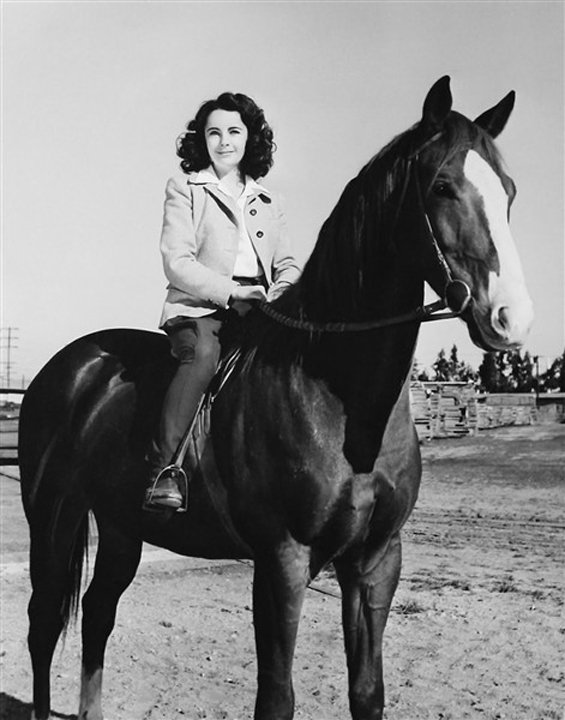
Yes. It’s true. I had to. It’s my galpal, Miss E. Taylor.
Tentative Tenants
In June of 1975 I found a small ad that simply read: “Large five bedroom brick home on lovely 3-acre estate. 9301 West Dodge Road.” Was that evidence of an attempt on the part of the owners to sell the property as a residence and if so, why did the ad come after all of the attorneys bought in?
In the same year the Omaha City Directory listed the name William C. Hawkins at the 9301 address. Hawkins had a star next to his name, connoting “new owner” or “new householder” according to the directory legend. William C. Hawkins…hmmm? Seemed familiar. In a cross reference of surnames in the directory, I would find William Hawkins was president of the Parsons Corporation and also the name of his wife, Patricia M. Hawkins. Further excavating would upturn Mr. Hawkins was a Marine Lieutenant in the 1940s later a well-known Omaha contractor under the company name Parsons. He and wife, Patricia Miller Hawkins, along with their children, lived in a series of incredible Omaha homes. Oh that Hawkins’ trail carted me to many fine places one night!
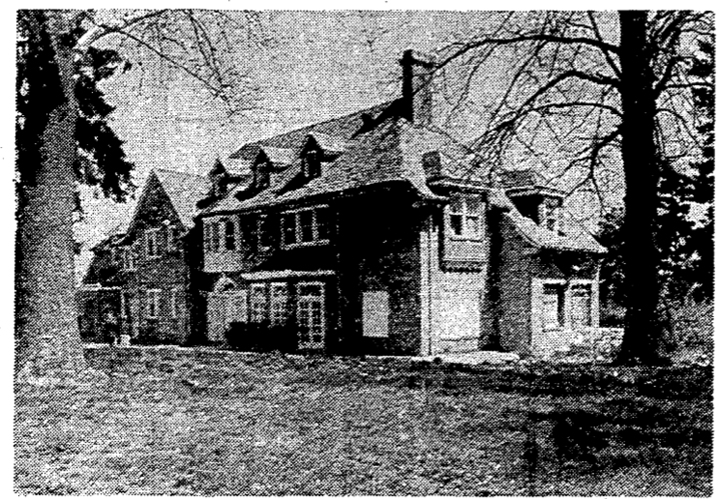
You know the one! Yes, we love this house. 617 North 90th in 1972. Of note, another gracious Omaha mansion held the Hawkins’ interest: 617 North 90th Street. The Hawkins garden was once home to society parties, in the 800 guests range with supper served under the striped canopy on the terrace, complete with torchlight background music. The Hawkins family had lived in the old Judge Donohoe mansion throughout the 1960s into the early 1970s. Perhaps a clue to our story was that Contractor Hawkins was able to successfully rezone the palatial home at 617 into offices, as it remains to this day. I did not find that Hawkins actually ever owned the 9301 West Dodge Road property. The 1976 City Directory confirmed the family enigmatically maintained the home for another year.
Was William Hawkins renting 9301 West Dodge from the attorneys? Was he bartering construction work in trade for the nice living quarters as his family looked for their next home? Had Hawkins been brought on in hopes of finding a way to get 9301 rezoned for business use? It all seemed plausible considering his success with the 617 North 90th rezoning. Another striking connection, although somewhat revealing of my fervent late night digging, is that Mrs. William Hawkins and her daughter hosted a bridal luncheon shower for Miss Colleen Walsh at the Omaha Country Club back in 1971. That’s right folks, Mr. and Mrs. Thomas A. Walsh and Mr. and Mrs. William C. Hawkins families were friends and also fellow OCC members.
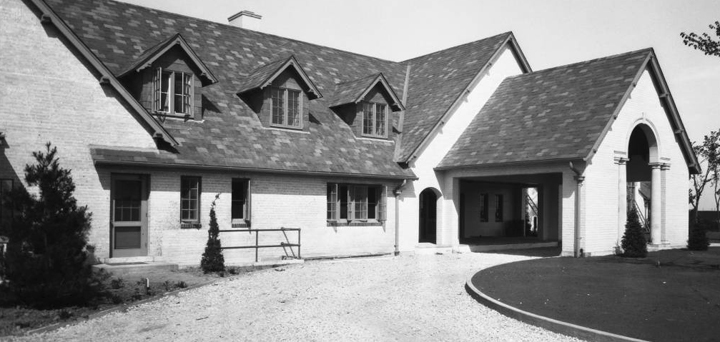
Decades earlier, the “new” European-styled Omaha Country Club at 6900 Country Club Road, in its infancy back in 1927. This is the south driveway and entrance. Creator: Bostwick, Louis (1868-1943) and Frohardt, Homer (1885-1972). Publisher: The Durham Museum.
By 1977 the City Directory sadly listed 9301 Dodge as “vacant” once more…and she would remain that way until 1982.
Side note of some interest: I have an acquaintance with a long memory and although a colorful past weighs on his shoulders, I have found his historic accounts to be error-free. We shall call him Mr. Ex. At some point in this early 1970s timeframe, Mr. Ex was released from a Stint in the Big House. When he returned from prison, he began working for a very brief time with a construction crew on the other Big House of our concern, the 9301 West Dodge Road house. To his memory the company who employed him were beginning to renovate a portion of the Georgian home into offices. The contractor ultimately put a lien on the house when the owners could not pay for the services rendered. Mr. Ex remembered the job ended quickly.
Changing of Hands
A Warranty Deed from April of 1978 revealed the Moylans wanted out; Patrick and Georgia Moylan would sell their portion of the two lots to Duane J. Dowd. The Truelsens bowed out in May of 1978, selling their interests to Sally L. Farnham. By October of 1979 Harry and Sally Farnham also sold their then 50% interest to Frances and Duane Dowd. The Dowds paid the Farnhams $86,500 and had total ownership. This transaction did not enter the World Herald transfer records until January of 1984. It was all so fascinating…. at least to me. Did the Dowds live and work in the home in those years? No, I did not find evidence of that.
Dowd would go on record in 1983 stating he had “wanted to turn the mansion into law offices but has been thwarted by neighbors who have fought a zoning change.” He also gave indication that another family had been living in the home for years. So although the City Directory listed 9301 as vacant, I wouldn’t put two and two together for a while.
The Willis Mouttet Dossier
I would find a fascinating connection between the Dodge Street mansion and one Mr. Mouttet. I knew that the Mouttet family couldn’t be owners, as the deed made no mention of the name. I assumed they must have been renting or leasing from the Dowds, which was the exact scenario, however a much more complicated agreement. Willis Mouttet turned out to be one of the most interesting characters I have ever come across. Born in 1934 in Oklahoma, Willis Gene Mouttet would come in Omaha in 1964. Mouttet would marry Carolyn Sue DePriest Kripps, nine years his junior in 1973. The couple had a blended family of seven children.
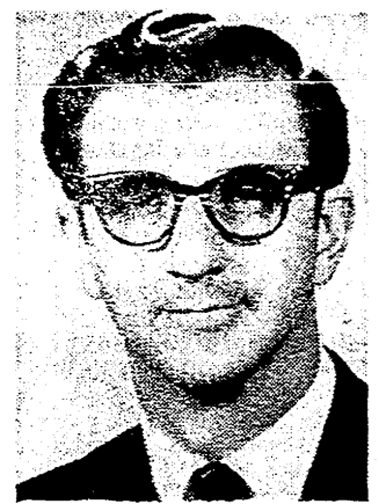
1968 Reverend Mouttet photo when featured in a flowering story about his ministry at the Omaha Church Center at 124 South 24th Street. This address is now home to the Lutheran Family Services corporate office.
The 1983 City Directory was my second clue into Mouttet, divulging he was “President of Willis G. Mouttet Inc., financial consultant.” I assumed he operated his business out of the large Georgian home. The slippery slope enticed me further when I discovered Willis G. Mouttet gained notoriety back in Gordon, Nebraska in 1958 for his work as an unordained, alleged by the OWH, interdenominational minister at Pleasant Point Community Church. In the 1960s, the imposing 6 foot 6 Minister Mouttet was featured in a religious television program on KDUH in Hay Springs, Nebraska.

All this before moving to Omaha in 1964, where he started raising money for his own series to be christened “Television for God.” Mouttet got into a bit of trouble in the early 70s with the alleged unlawful sale of bonds for the “Television for God Inc.” As the executive director, Mouttet was apparently not registered as an agent or broker-dealer with the securities commission, nor were the bonds issued by the Television for God registered for sale in Nebraska, Kansas and Oklahoma. $60,00 worth of bonds were later said to have been sold in Kansas alone. Days later a mysterious Margaret Ruth Mouttet divorced from Willis Mouttet. Mouttet was brought up on 111 counts initially; I believe 108 of these counts were ultimately dismissed with the judge proclaiming Mouttet gained little to no financial reward from the bond sales. The judge conceded to Mouttet’s high living. “He was going high, wide and handsome on hotel bills, airlines and that kind of stuff.” Of the $33,000 he was ordered to repay to 37 Reno County, Kansas residents, the judge eventually negotiated a lower $10,000 payment, due to Mouttet’s professed lack of funds.
When four years later, Mr. Mouttet made the papers for making a $50,000 down payment on the Skyline Golf Course at 220th Street and West Center Road, the authorities’ curiosity was piqued. The Skyline had opened in May 1962 as a public layout known as Chapel Hill Country Club; it was sold in 1968 for $500,000 and renamed Skyline Golf Club. The once minister-turned-developer, Willis Mouttet’s 1974 plan was to raise the rest of the golf course sale price ($600,000 total) by offering bonds to the public “through some firm which handles such sales.” He had learned his lesson but hadn’t worked out the fine details. Willis Mouttet maintained he owned 500 some acres adjacent the course with which to further develop the big picture of the redesign. Mr. Mouttet asserted to have land developments “near Tulsa, Oklahoma and Springfield, Colorado as well as controlling interest in two Hickman, Nebraska businesses.” As the weeks went by, Mouttet’s proposal for arranging the public course into a private course with condominiums and upscale housing on the outer edges came into view. He promised a clubhouse with 64 lots additional residential lots for sale, all parcels offering an impressive one-acre. With high hopes, Mouttet would buy the golf course twice over and twice default. This entanglement caught him in his biggest lawsuit. Sebastian Circo and his son, Dennis, would ultimately acquire full ownership of their coined Skyline Woods Country Club and began building homes and condominiums. Let it be known, Willis Gene Mouttet was a great Ideas Man.
By the time the Mouttets had moved to the 93rd and Dodge mansion in August of 1982, there were other rumors of his involvement in a livestock embezzlement case out of Pierre, South Dakota and tell of a slew of shoddy checks. Another lawsuit involving Mouttet disclosed he and a business partner owned nine helicopters in an agricultural venture. Interestingly there was also a canoe company, a lumberyard and hardware stores. There were also some negligent claims regarding installment money for many investors for real estate development for over ten years; I believe this was the Willis G. Mouttet Inc. he was handling out of the West Dodge mansion.
They say Mr. Mouttet was sitting in a Sidney, Iowa jail cell in April of 1983, charged with a felony offense of allegedly using a “false financial instrument.” Unfortunately South Dakota was seeking extradition in addition to 23 civil suits awaiting him in Douglas County. Perhaps for that reason, attorney Duane Dowd (not Mouttet’s lawyer) went on the record, stating that yes, Willis Mouttet lived in the 9301 West Dodge Road home but that he had “lived there practically rent-free…over the years but has kept the house up well.” I believe Mouttet’s big dreams had sadly gotten away from him.
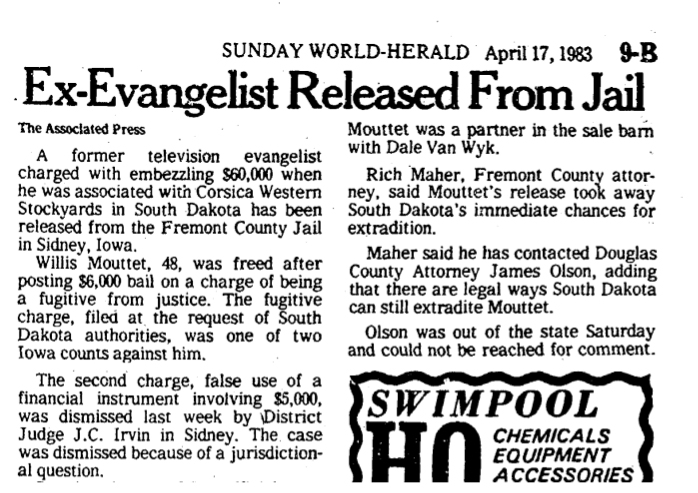
April 17, 1983, OWH article. Willis Mouttet was released from the Iowa jail days later. My head was spinning. What was the truth in all of this? The Mouttets would continue to reside at 9301 West Dodge Road through 1984 but by 1985 the directory logged a “No Return” under the address. From what I could uncover the Mouttets had vacated for 9516 Walnut Street. The directory listed Willis’s profession that of “handyman.” In August of 1984, Duane and Frances Dowd would find their ideal buyer, however I would not soon forget the stories I read of the High, Wide and Handsome Mouttet fellow.
Unity Church
The official warranty deed, cross-referenced with the World Herald Real Estate Transfer list, made plain, the Dowd couple sold the once Twin Oaks mansion to the Unity Church for $435,000 in the summer of 1984. 9301 West Dodge Road was soon to take on a whole new look.
I dreamed about the large home. How was a church allowed to move into the residential Westchester Addition? Did the church buy the property to construct a new church or did the congregation meet within her proud mansion walls? Was the home a rectory of sorts for the church leaders or did they maintain their own personal homes? What did the neighbors think? I couldn’t find a peep. Perhaps 9301 became an administrative building or a retreat center. Evidence did not point in any one direction. In fact there was barely a hint at all.
I would chance on a number of legal documents over the years listing Dorothy K. Lang, as president of the Unity Church and Billy Batson as treasurer. Father of Miss Cassette is a long time comic book collector, so this Billy Batson reference certainly caught my eye. Different alter ego, altogether. There were tedious easement adjustments and the such, which I assumed were due to the widening of West Dodge Road. There also appeared to be financial documents between the church and their lenders. I can find these official papers and contracts a bit tiresome but I printed off the long scrolls all the same, I suppose, anticipating they might offer something to the investigation at a later date. One never knows when one is finding the clue that breaks the case.
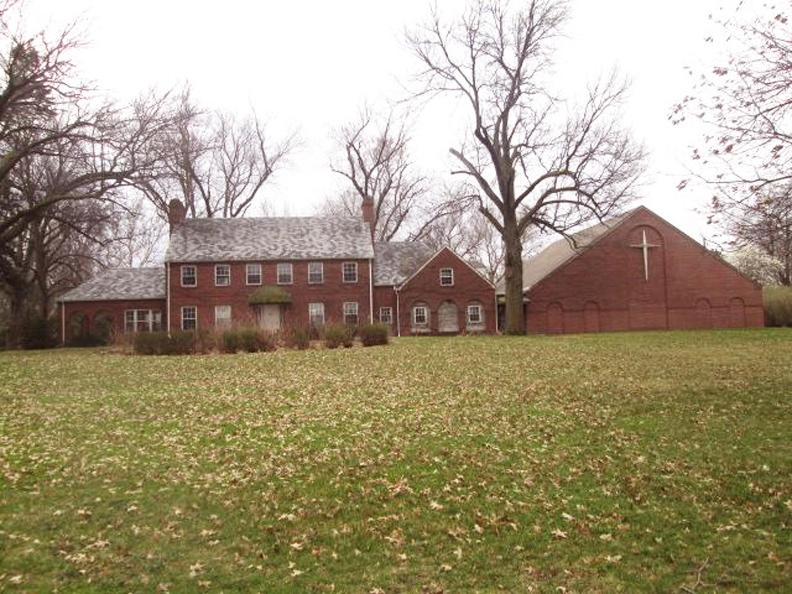
Photo of 9301 West Dodge Road borrowed from the Douglas County Assessor site.
As it turns out, a church is allowed in an area zoned for residential use. The mansion and subsequent building was used for offices and church services. The Unity Church of Omaha, evidently started in 1930, had been meeting in the former Cathedral Catholic Church building at 42nd and Hamilton Streets since 1951. This tip had me considering burrowing into the rabbit hole of what former Cathedral this was, considering Saint Cecilia Cathedral is at 701 North 40th but I decided against it. (Hopefully another detective will shed light!)
**Addendum of February 5, 2023. Ask and you shall receive! My Omaha Obsession friend, Rob Butler wrote in explaining that this 42nd and Hamilton could not possibly have been the previous Cathedral location. From his history of the Cathedral, I went back and found the OWH article from Sept 1 of 1984, where I gathered my incorrect clues. The article explained that the Unity Church’s former building at 42nd and Hamilton had been the once Catholic Cathedral. I went back further to when the Unity Church actually moved into the 1317 North 42nd Street building in September of 1951 and voila—it had been St. Andrews Episcopal Church. The more curious I got, the further into the rabbit hole I fell. The Unity Church of Omaha was operating in the 1880s if not before. In August of 1889 Rev. M. M. Mann, who for thirteen years was pastor of the First Unitarian church of Rochester, N. Y. accepted a position as pastor with Unity Church of Omaha. Somehow the church’s own advertising and history changed to say they were founded in 1930. Maybe it was an off-shoot faction?**
Soon after acquisition, Unity Church announced their groundbreaking ceremonies for construction of a “new building” at the 9301 West Dodge Road property. The new one-story, brick structure was proposed to hold a 500-seat sanctuary on the main floor and a full basement with room for Sunday school classrooms, a kitchen and dining area and a meeting room. This was the church so many of us had observed throughout the 1980s-90s. I next located a December of 1985 building permit in the Unity Church’s name for two additions to church at $150,000.
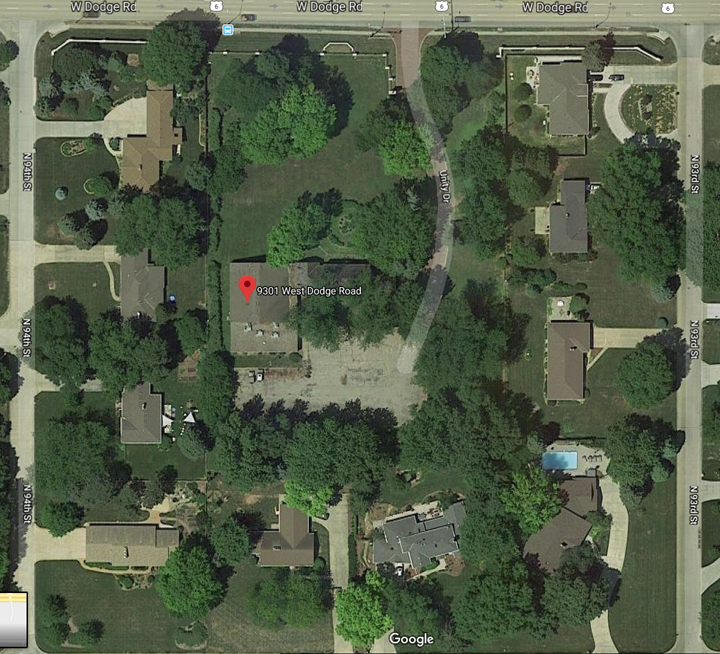
Photo borrowed from 2018 Google Map. Red marker shows the church building attached to the west wing of the home at 9301 West Dodge Road.
A Brief Unity History
According to numerous websites, the Unity Church was founded in Kansas City, Missouri, in 1889 by Charles and Myrtle Fillmore, after Mrs. Fillmore had been cured of tuberculosis. The couple would make an active study of spiritual healing subsequent to this cure. Interestingly Charles and Myrtle Fillmore opened Kansas City’s first all-vegetarian restaurant, the Unity Inn in 1906. “During the opening weeks of the original Unity Inn, patrons could pay as little or as much for their meals as they wished.” The Christian organization spread worldwide and has continued to draw in members due to their “positive approach to life” and their emphasis “to accept the good in all people and events.” Unity teaches that all people can improve the quality of their lives through thought, with “no particular creed, no set dogma, and no required ritual.” I found it interesting that each Unity Church is autonomous in its practices, clearly aligned to their no set dogma idea. It was then that I was reminded that my dear grandmother’s mother had been a latent Unity follower. My great grandmother, whom I never had the good fortune of knowing, had apparently gravitated to Unity through another of their tendrils—the Unity radio shows, which started broadcasting in the 1920s. She also subscribed to the Unity pamphlets, as well, apparently having found great comfort in the philosophies of the Fillmores. A deeply private woman, as was my grandmother, she never spoke of her beliefs.
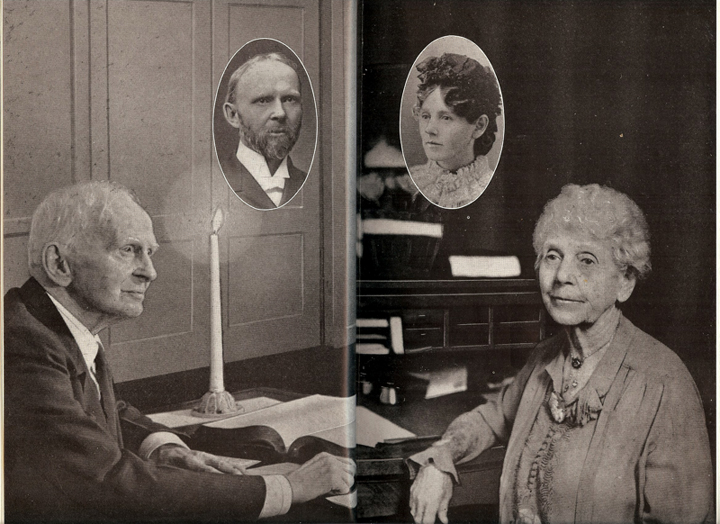
Charles and Myrtle Fillmore, featuring insets of their younger selves.
Unity Union
Other than the 1990 City Directory listing Reverend Donald Jennings as pastor and a “Dial-A-Prayer” listing under the 9301 Dodge address, I was coming up empty handed in the Unity years. That is probably a good sign. In July of 2000 the Unity Church of Omaha voted to merge with its sister church, the Unity Church of Today. Twenty years previous, a sect of Unity Church of Omaha members had branched off to create the new organization. Apparently after Sky St. John took to the pulpit at the 9301 West Dodge location, the church attendance increased dramatically, pushing them to expand. This growth forced the congregation to sell its property at 9301 West Dodge Road and move into temporary quarters at 3424 North 90th St. Plans to expand even further to include a complex at its newly acquired property at 72nd Street and Crown Point Avenue were being developed although no money had been raised yet, reported Principal St. John. Later I would find indication that Trinity Church Interdenominational had convened briefly in 1999 at the 9301 Unity location. A Real Estate Transfer in the papers from June 2000 signified the Unity Church had sold 9301 West Dodge Road to Mary F. Cullan for $1,200,000. Finally! I had a rush of hope that someone would return to live in the grand home.
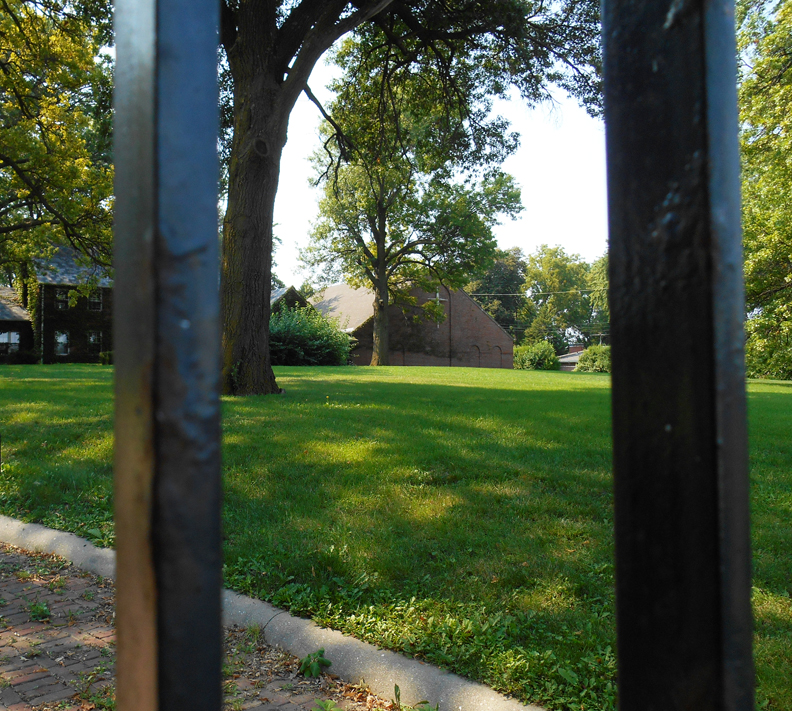
The Cullan Purchase
The missing clue put together much too late: the Deeds office held what was a Corporation Warranty Deed for 9301 West Dodge Road, dashing my hopes for a forever family home. Mary Cullan, as it turned out, did not buy the home to create a dream residence. The contract was signed on March 24, 2000. In the following years there would be more easement adjustments to the West Dodge Road perimeter as well as a “Deed of Reconveyance”–a document that transfers the property title to the borrower from the Trustee once the borrower has fully paid the debt secured by a “Deed of Trust.” These papers can also be numbing but I only seem to find them when a business owns a property. All the more proof that 9301 West Dodge Road was not a family home. 2000 City Directory showed the Cullan and Cullan Medical Clinic at 7602 Pacific Street, Suite 300. Daniel Cullan was listed as a partner.

7602 Pacific Street offers offices for lease.
Daniel “Dan” Cullan was known as a doctor of medicine and trial lawyer, specializing in major injury cases. In 1976 Dan and his brother, David, founded the law firm of Cullan and Cullan. The primary focus of the firm was to help families rebuild their lives following catastrophic injury. The two would make quite a name for themselves nationally. Daniel and wife Mary Frances Trotter Cullan would have children Daniel II, Patrick, Joseph, Mathew and Anna. I mention their names because brothers Patrick and Joseph Cullan would remarkably follow in their father’s footsteps to both obtain degrees in medicine and law, and specialize in catastrophic injury cases throughout the country. The law firm of Cullan & Cullan LLC, Physicians and Trial Lawyers, is a nationally recognized law firm concentrating in personal injury and class action litigation. http://www.cullanlaw.com/
Daniel and Mary Cullan
Whatever the plan to be hatched, things were looking up for our Georgian Mansion. In October of 2000, I found that Mary Cullan had put $40,000 into the home by way of a new porch and window replacements, the loving attention I was sure she had needed by then. Tiptoeing back to a Real Estate Transfer of 1985, I discovered Daniel B. and Mary F. Cullan bought XXXX B***** D***just north of Westroads. Myron Hesse, founder of Automatic Equipment Manufacturing Co. of Pender, Nebraska had lived in the home. Hesse was credited with pioneering the development of roller mills, cattle oilers, mist sprayers and livestock equipment. I was not sure if the family actually lived at XXXX B***** D*** address, but indicators definitely pointed away from anyone living at 9301 West Dodge Road. I also found it peculiar that the Cullan Kids Foundation headquarters were listed as XXXX Bl***** D***. Currently 9301 West Dodge Road is also held under the Cullan Kids Foundation. File this away.
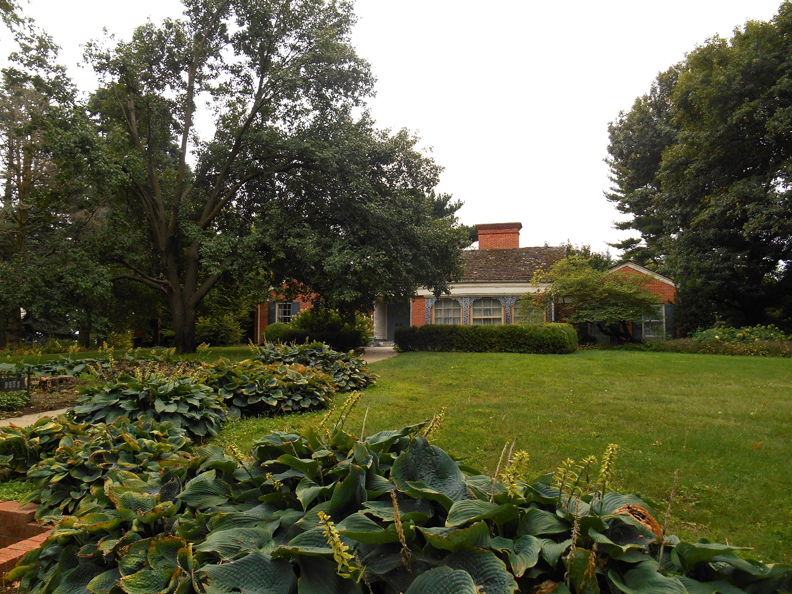
XXXX Bl***** D***. Great location, incredible bones and some fabulous MCM ironwork. Built in 1955, this home is situated on a 1.35 acre corner lot.
Westchester Dust-up
In the spring of 2003, there was once again a neighborhood clash, alerting me to the Cullan’s proposition. “Attorney Daniel Cullan hopes to convert the red-brick compound at 9301 West Dodge Road into law offices, but a group of neighbors has promised to battle him,” read the article. The Westchester neighbors would once again align for a petition drive when they caught wind of Cullan’s plan to rezone from residential to general office to allow for his future law offices. Like neighbors previous, some perhaps the same, the group motion contended their Westchester neighborhood south of West Dodge Road would become tainted by other office and commercial properties if the Cullans pushed through their scheme. Lillian Feldman stepped forward to say, after 45 years in Westchester, the fear among neighbors was that the homes along West Dodge Road would be bought and turned into businesses. Once the integrity of the district was adversely affected, the area would become vulnerable to other commercial and office developments. Also due to the restrictions of a left handed turn on Dodge, neighbors were rightly concerned that Cullan clients would begin taking 90th Street, weave through Westchester to Dodge west of the property, to get to Cullan’s offices. Cullan’s proposal was expected to go to the Omaha Planning Board June 4, 2003.

The snowy drive of gorgeous 9301.
The Fence Clues
At that time Daniel Cullan made clear he did not want a fight with the neighbors and only said he planned to “build a two or three car garage.” He also hoped to refashion the former church and mansion to accommodate his law firm and his Cullan Kids Foundation, which he said, “espouses safety and preventive medicine for children.” He expected to spend about $2 million on renovation and improvements. Unfortunately Cullan released the structure had extensive termite damage, with hopes to repair and refurbish it. That was also when I learned of the construction of the brick wall and elegant gate on the property along West Dodge Road. Documentation in the form of a building permit from June 2003, corroborated that Mary F. Cullan filed for a “retaining wall, $150,000; fence, $235,000” at the 9301 West Dodge Road property.
And that’s not hay. I was amazed.

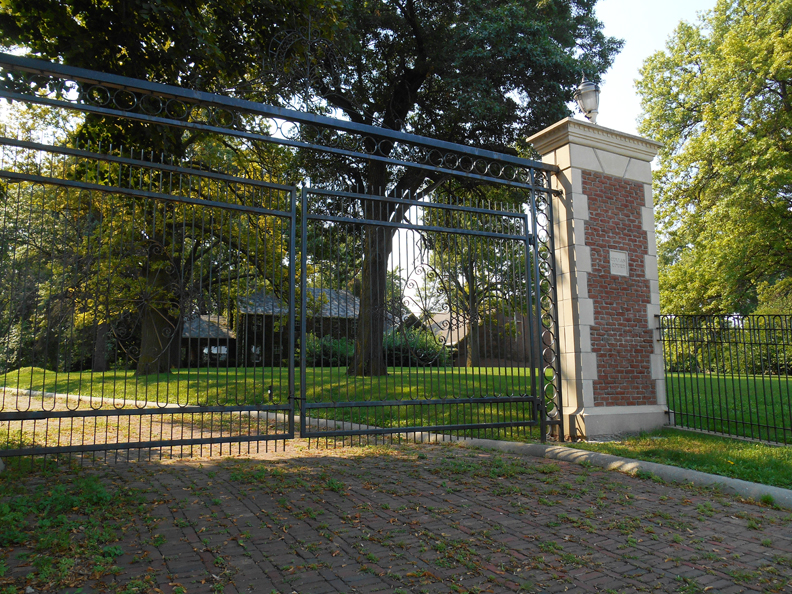



It all came together. The small tile symbols I had observed on the brickwork featured the Rod of Asclepius medical symbol fused with the scales of justice–the Cullan & Cullan logo signifying their merger specialty of Trial Lawyers-Physicians. I would later find this same insignia on their website.
Unanimous Defeat
The attorney’s proposed office building was unanimously defeated by the Omaha Planning Board days later. One of the neighborhood’s leading opponents of the plan, physician Shirley Huerter, thought Cullan’s plan would not just go away easily. “I don’t think it’s going to end here…” Huerter said after the meeting. “I’d be surprised if he’s done.” About 30 neighbors turned out at the Planning Board meeting, and about 190 signed a petition in opposition. Interestingly Planning Board member Thomas Skutt Jr. and others suggested Cullan consider “coming back with a more restrictive plan, laying out in detail his concept, thereby allaying neighbors’ concerns.”
Further hints to what Daniel Cullan had in mind for the law office compound can, perhaps, be derived from what he referred to as, a “planned-unit development.” I cannot be sure of what that meant. Daniel Cullan hoped, after the Planning Board rejection that he could, in time, help the Westchester neighbors understand and accept his plan. City Planning Director Bob Peters was quoted as saying that regardless of how specific Cullan’s explanation became, “the Planning Department will recommend against an office building because it doesn’t conform to the neighborhood. The department won’t support it.”
This 2003 story was the last article, the last mention of Cullan’s development and the last formal word on 9301 West Dodge Road. I’ve got a sneaking suspicion that the home has sat empty this whole time. There is a car, which can be observed from aerials, that has been parked in the old church lot, just south of the house, over the years. Was that or is that a caretaker? The home has taken on a greenish hue and looks as though it might return to nature any year now. I was not able to find evidence of our Georgian Mansion receiving the royal renovation and improvements she needed for the purported extensive termite damage mentioned by Dan Cullan. With the neighbors fighting Cullan’s strategy, did the repair and refurbish design get left in the lurch because of a stalemate? Possibly. Are we to assume the home is now in a troubled state? For Pete’s sake, what is going on? I shant rest until I know.

Sadly in May of 2007 Daniel Cullan died at age 61, his plan never actualized. His brother and law partner, David Cullan died at age 72 in June of 2012. Cullan & Cullan law offices now continue on with brothers Patrick and Joseph Cullan, following their father’s legacy. The firm is now located at 1113 Harney Street.
Cullan Kids Foundation
According to a brief review online in the business directory, Cullan Kids Foundation, Inc. was founded in 2010. This date was incongruent but maybe it was only incorporated in that year. The group was summarized inadequately as a “Civic And Social Association.” Cullan Kids Foundation, Inc. evidently had three employees and offered an estimated revenue. I was able to find tax information, showing that Cullan Kids Foundation was still operational, however they do not appear to be active in a public sense. I might be an amateur detective, but it would appear that this foundation, like the proposed offices at 9301 never really took flight—at least not in the way its developers had hoped for. The Foundation Directors allegedly are the Personal Injury Lawyers of Cullan & Cullan, according to online registry. I only drop these breadcrumbs here because Omaha’s Manderlay at 9301 West Dodge Road is registered under Cullan Kids Foundation.
The Dapajomana Lead
There were other mysteries to be found piled up around our 9301West Dodge Road property–eccentric riddles I found just as compelling as anything else in this mystery. In September of 2002 or May of 2003, (conflicting evidence) Daniel Cullan purchased 330 North 93rd Street, one of the Westchester homes that abut the large McVeigh-Walsh property.
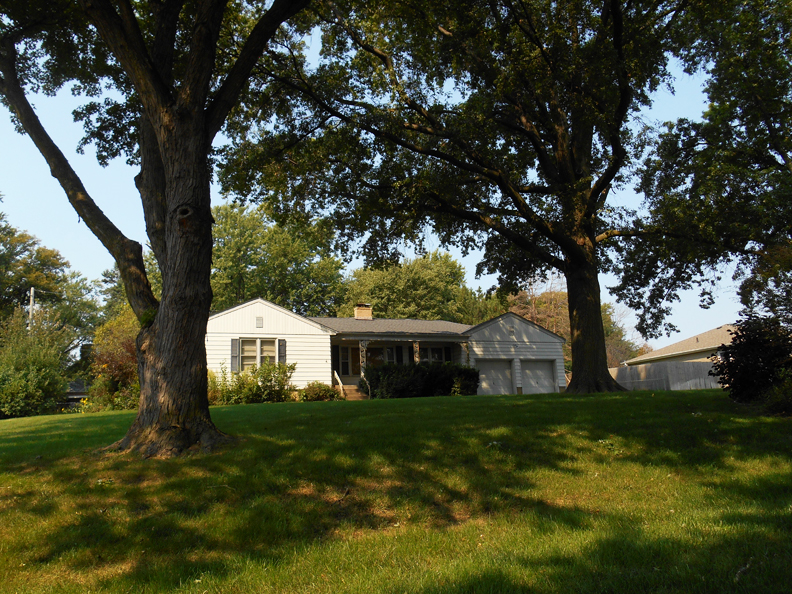
330 North 93rd Street. Built in 1952. One can catch a peek at 9301 West Dodge Road through the trees of this cute property.
In September 2003 or February of 2004 (conflicting evidence) Daniel Cullan also bought 331 North 94th Street, to the west of the property.
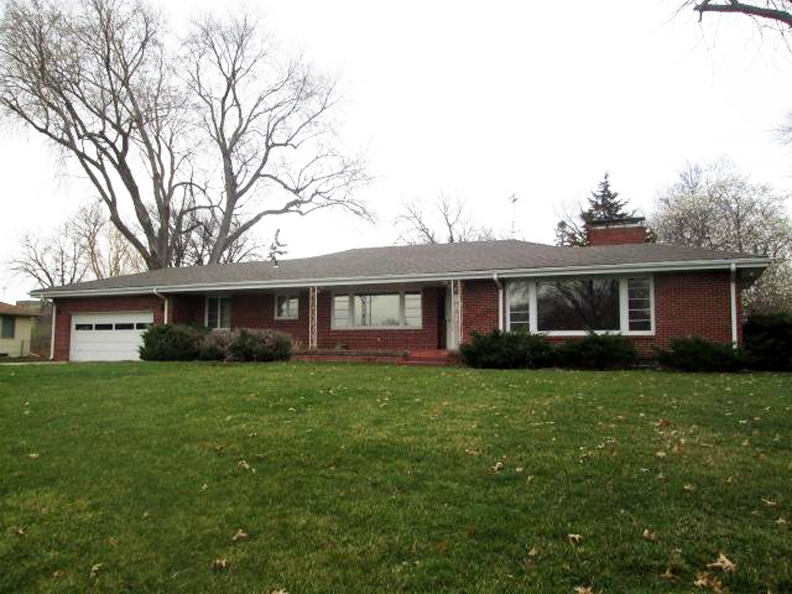
331 North 94th. Both of these homes (330 and 331) are parallel to one another, on the perimeter of 9301 West Dodge Road and held under the elusive Dapajomana LLC, leading one to question—just what was the overall scheme?
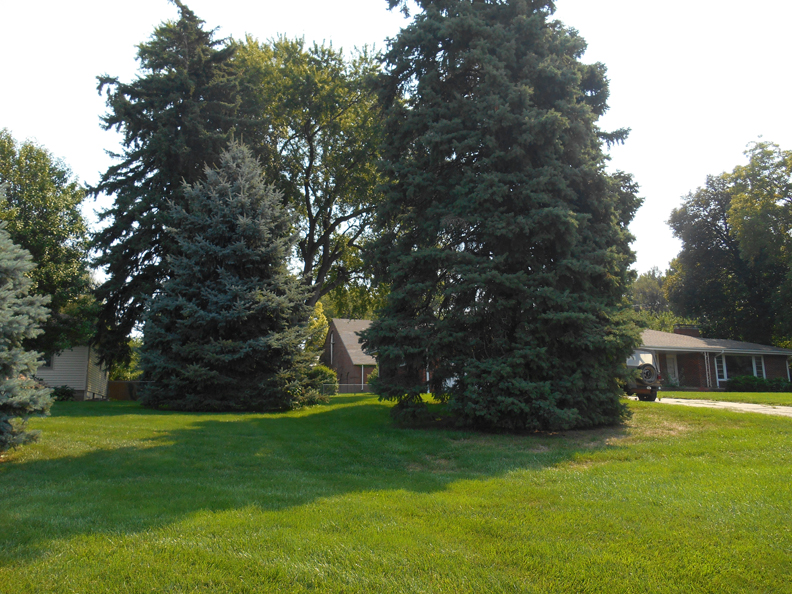
Built in 1953, one can spy the Unity Church structure through the foliage of 331 North 94th.
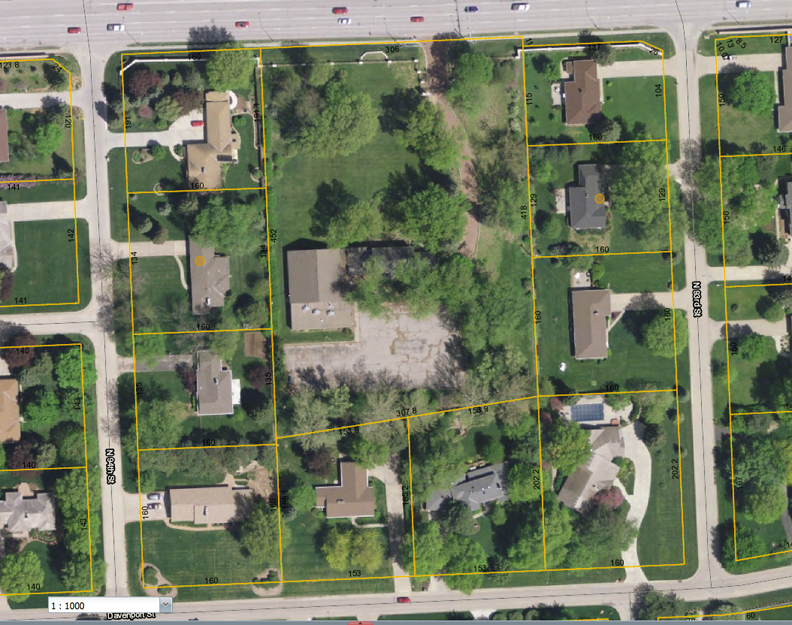
2010 Westchester aerial with yellow dots showing the Dapajomana LLC owned homes. Photo borrowed from the Douglas County Omaha GIS site.
Questionable Sixth Sense
One could surmise that the Cullans planned to buy out the houses around 9301 West Dodge Road as they came up for sale, thus eliminating the disapproval of their law office development. I had conjectured perhaps the idea was to tear these two homes down and create an east and west route onto the grounds. Did this have something to do with the “planned unit development”? Was there a proposal to use the houses in their Cullan Kids project—like a smaller Boystown? Perhaps these two purchases were not part of larger proposition and I was slowly becoming a conspiracy theorist. No need to answer that. Judging from the long brick entrance walls flanking the gates to 9301 West Dodge Road, the Cullan clan might have proposed to acquire all of the homes on the border of 9301. One could speculate that there are potentially Cullan & Cullan signs under the makeshift lumber veils. Or do they read Cullan Kids Foundation? Or both? The brick wall signs have been strangely boarded up since as long as I can remember. Or maybe it was just yesterday. At this hour of the night, by candlelight, anything had become possible.
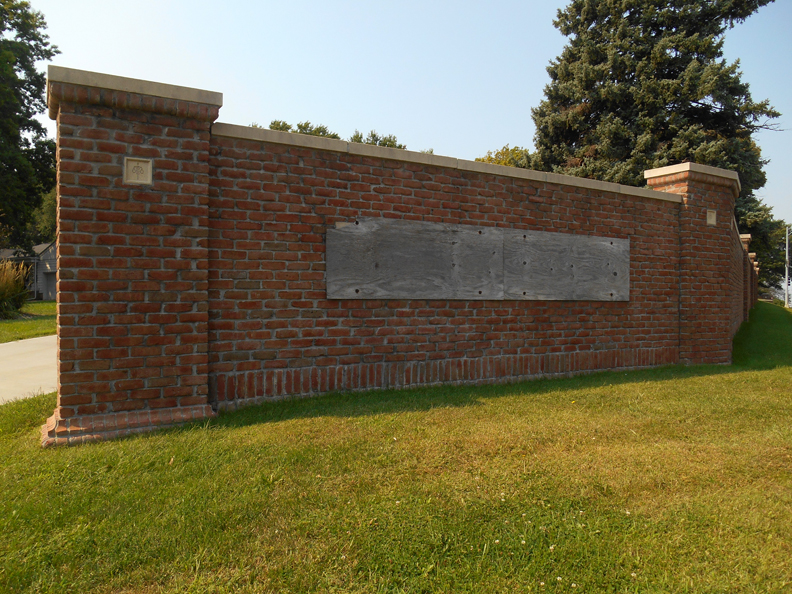
** Addendum. New evidence as of November 13, 2021. Either someone could not stand the suspense or the wind blew it down. So glad to see the sign!
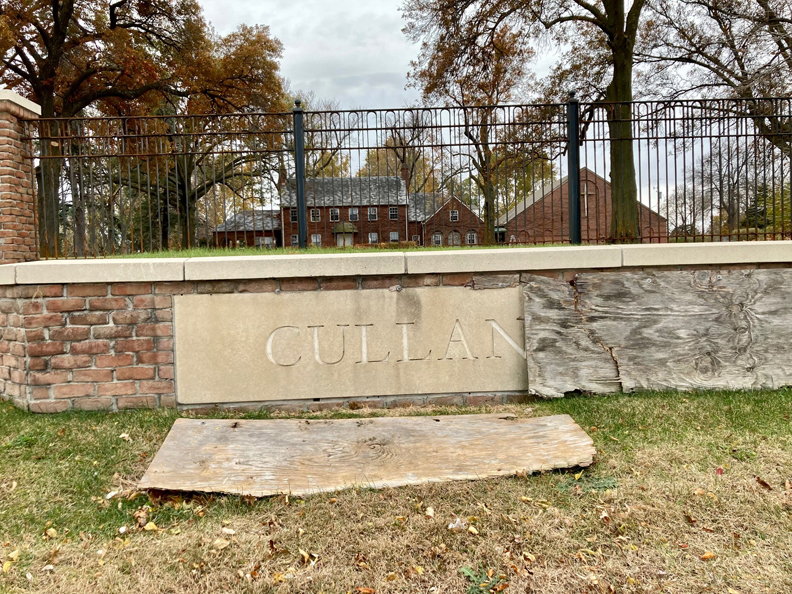
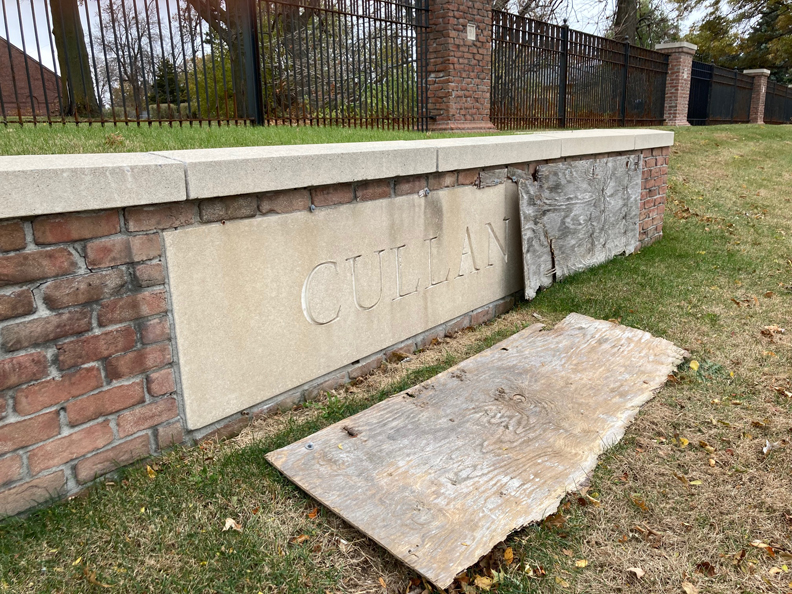
**Addendum of August 5, 2024. New clues. After the series of terrible storms in Omaha, our 9301 West Dodge has gone through some damage. Many trees down and or broken branches.
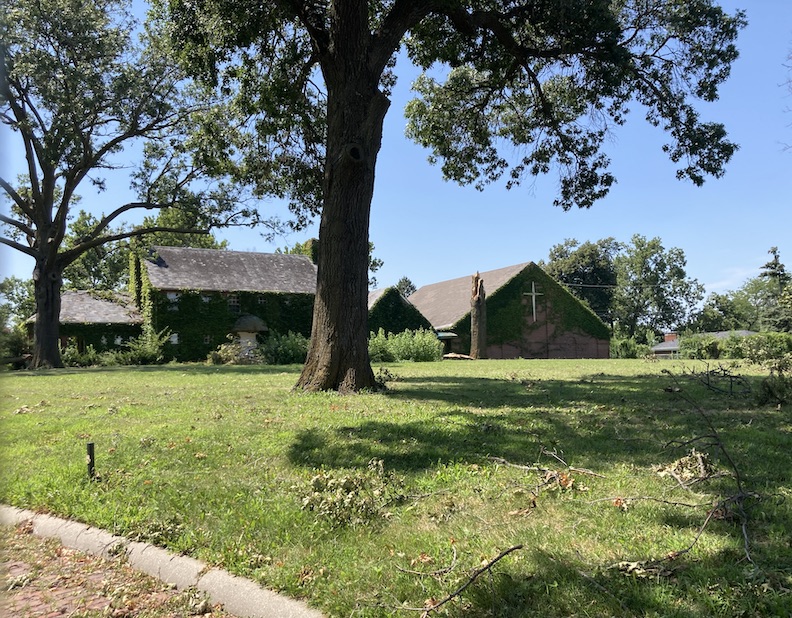
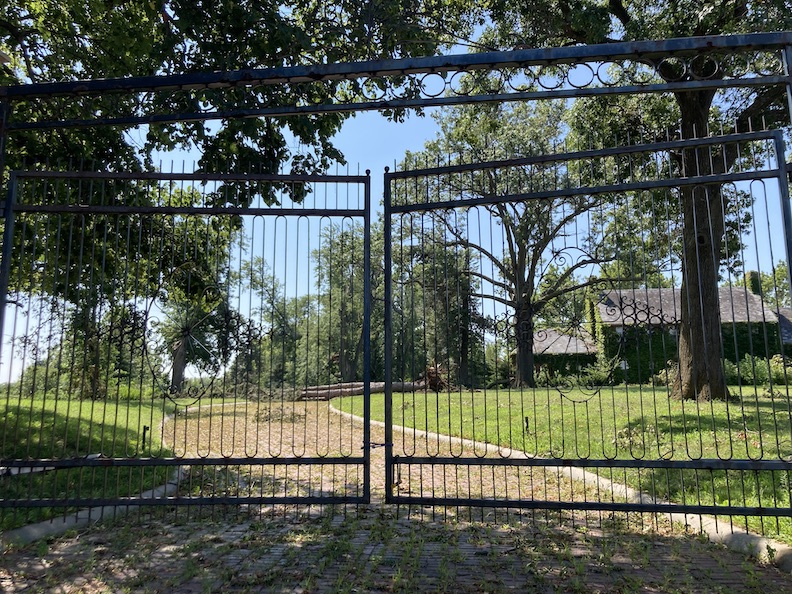
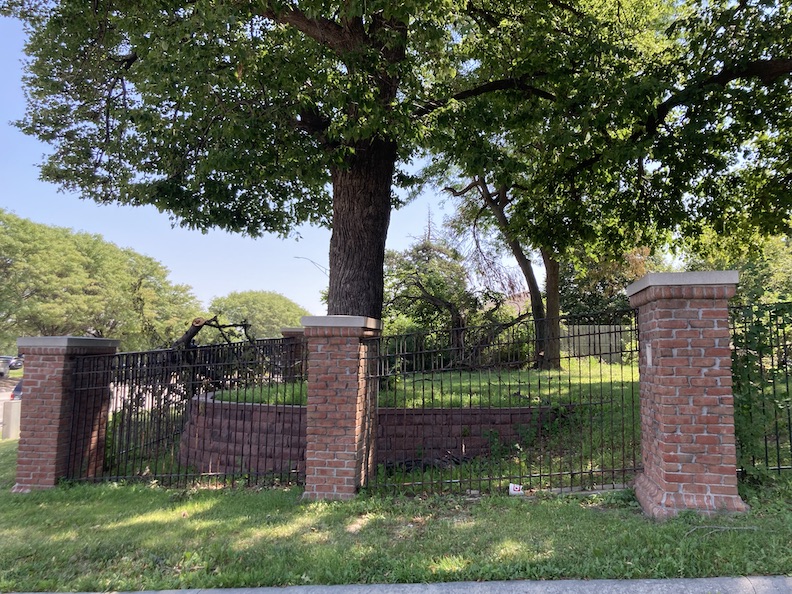
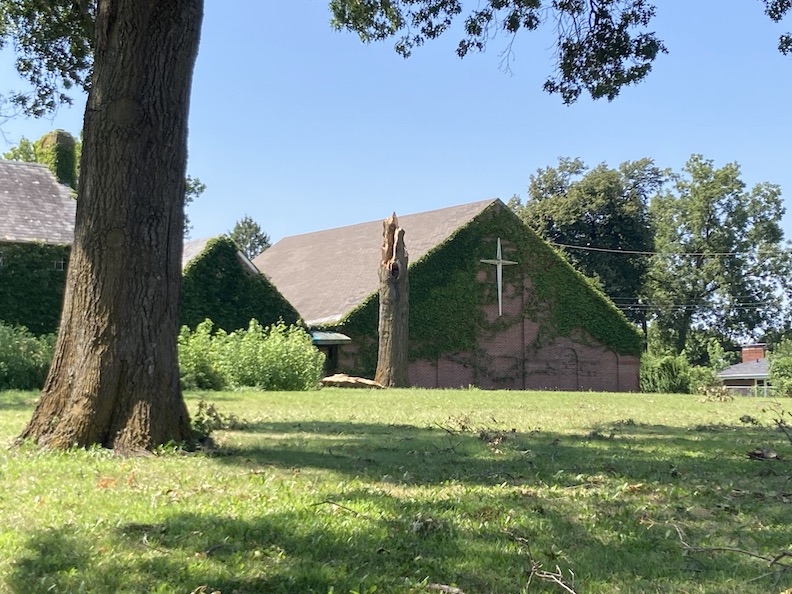
**Addendum of October 31, 2024. The beautiful gates are left open today as Pena’s Tree Service works on the downed property trees.
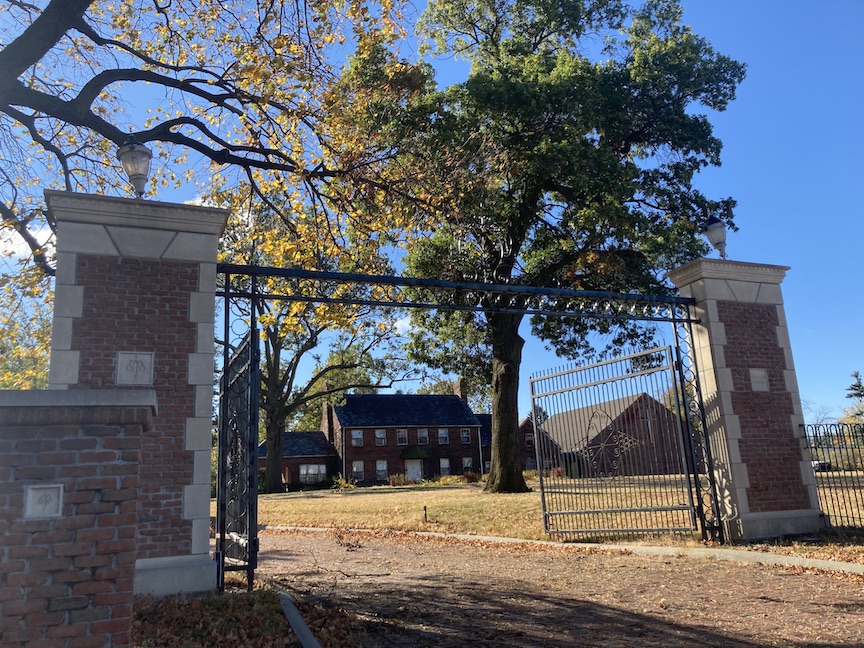
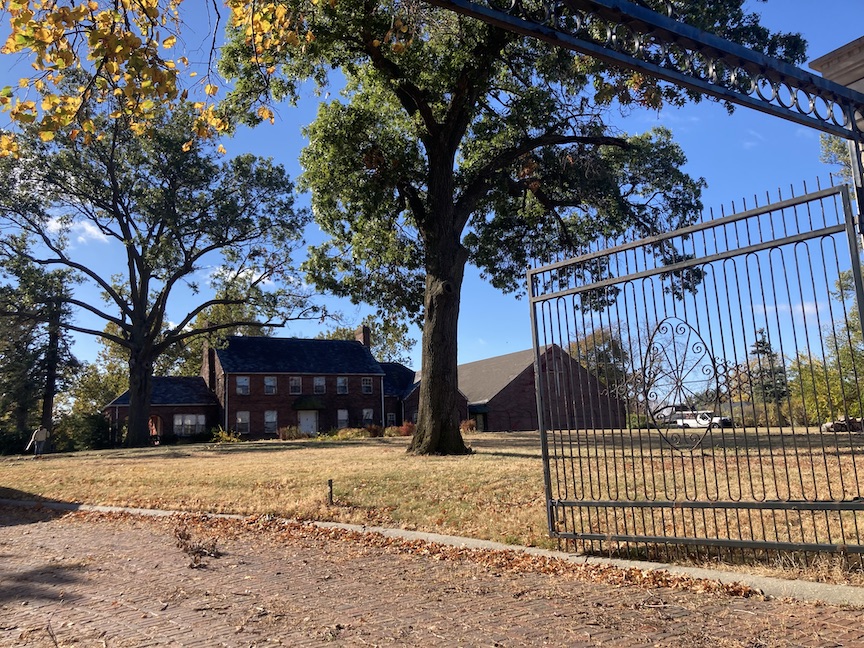
At the end of the mystery, I felt the heaviness of an old, black, wool cloak. I was puzzled then and I continue to be even now. It was as if I had never left my office and only imagined a huge Georgian Mansion behind the wrought iron gate. If I rushed over to 9301 West Dodge Road, would I still find her there dusted with snow? The words of Daphne Du Maurier would return. “Time could not wreck the perfect symmetry of those walls, not the site itself, a jewel in the hollow of a hand.” I would come to realize that Madame 9301 West Dodge Road had always been set apart, her own sense of solemnity, perhaps her birthright, perfectly composed. She could not be entirely blind to the flourishing conditions around her, nevertheless she remained unmoved. It would seem she had a whole neighborhood guarding her.
I have been absent a while and I do apologize. Unfortunately my beloved cat and the best writing partner I have ever known, Four, passed away during the writing of this story. Even now reentering our shared space at the desk pains me greatly. Where is he, who thought the lumpy keyboard was a fine place to rest his head, often causing a series of qqqqqqqqqqqqqqqqqqqqqqqs or 1111111111111s? I tell myself he is very near, just in the other room getting a drink. This one is dedicated to him.
For my writing partner, Four. R.I.P.
This investigation now has additional clues by way of a Part Two. Please follow to: Not Long for this World: 9955 Bloomfield Drive.

I welcome your feedback and comments on this treasured Omaha home, the Westchester neighborhood and the whole West Dodge Road area. Do you have a Sneaking Suspicion, a Snoopy Sense, or a Hunch we need to know about? Or are you Just-Plain-In-the-Know? Let us hear from you. Please share your additional clues to the story in the “Comments,” as we know more together. And honestly, I can no longer answer all of these emails. Everyone would love to read what you have to say and it makes the sharing of Omaha history more fun. You can use an anonymous smokescreen name if need be. We want to hear from you.
You can keep up with my latest investigations by joining my email group. Click on “Contact” then look for “Sign me up for the Newsletter!” Enter your email address. You will get sent email updates every time I have written a new article. Also feel free to join My Omaha Obsession on Facebook. Thank you, Omaha friends. Miss Cassette
© Miss Cassette and myomahaobsession, 2018. Unauthorized use and/or duplication of this material without express and written permission from this site’s author and/or owner is strictly prohibited. Excerpts and links may be used, provided that full and clear credit is given to Miss Cassette and myomahaobsession with appropriate and specific direction to the original content.
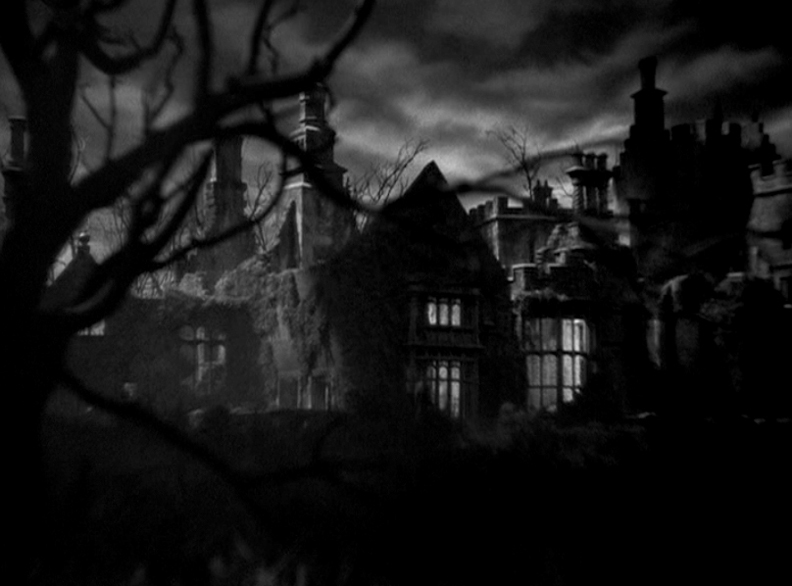
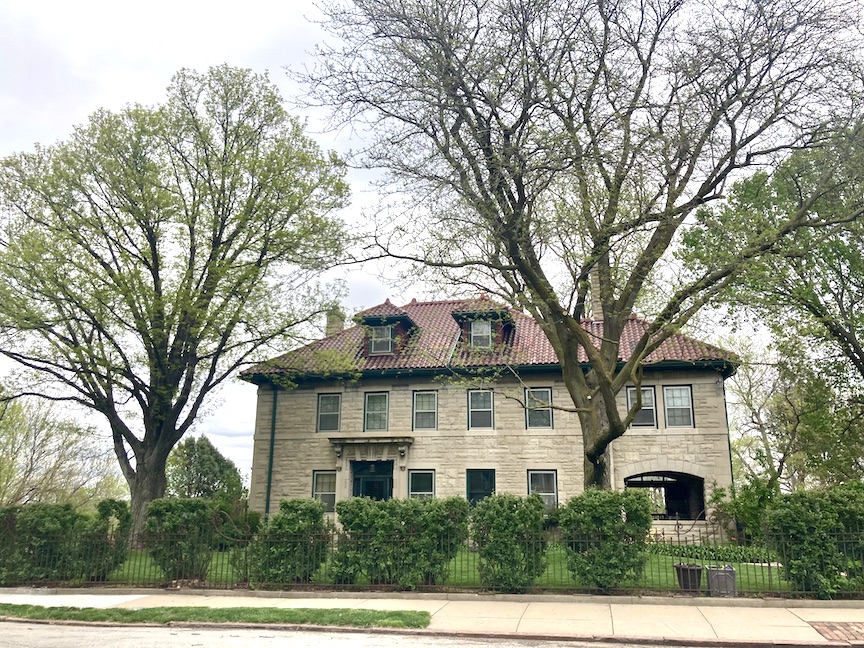
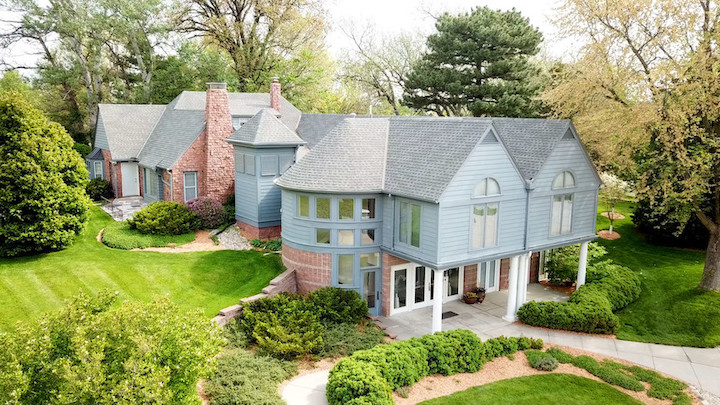
My Aunt lives in one of the border houses on 93rd Street. Next door to the south of the one bought by the Cullen’s. My Aunt and Uncle have lived there since the 1970’s, raising their family there. She is interested in selling I think, but hasn’t seriously put it on the market. She says that most of the homes sold in that neighborhood are being torn down and something other than a ranch style home gets built. The lots are pretty big.
The lots are big and gorgeous. And this is the perfect center of town. I think she could get a pretty penny when she’s ready but what a treasure to have a neighbor from the 1970s. I’m sure she could tell us so much! Please share if you ever hear more. Thanks for writing in!
Current tax records show that the land is still being taxed, but the “Improvement” (home) hasn’t been taxed (reasonably) since 2018. My guess is the home is a complete loss.
The old tudor house built by Clarence Landen was located at 110 N 92nd St. It was listed for sale in the early 2000 and torn down in 2005 to build a large home for the Weitz family.
Oooh…you are good, detective! It was a scraper. I wondered why I couldn’t find it! Thanks for the info.
Correct John. The Landen home sat on the corner of 92nd and Capitol Ave. Torn down in 2005, and Mr. Wietz built an enormous grey granite monstrosity of a house that outsizes everything on 92nd St.! The front door area looks like a Neiman-Marcus dept. store entrance! Mr. Wietz then proceeded to buy the lot west of that on the corner of 93rd & Capitol Ave. at 115 S. 93rd St. and built a pool/cabana area.
Miss Cassette, this is another extremely fascinating story — you have done an amazing job investigating the facts, and it’s certainly one that has all sorts of intrigue to it. Excellent!!
Thank you so much, David. This means a lot, coming from you. I hope you are well! Merry Christmas and Happy Holidays to your family.
I continue to be mightily impressed by your dedication to detail and your submission to the almost crippling OCD required of a skilled investigative journalist! 😉
Excellent job and so enlightening to read about the things you discover and share. Thank you!
We call my articles and the files alone, Computer Crashers! Thanks for recognizing the fun insanity of it all.
I have some clues on your photo of a “trailer park somewhere on West Dodge Road.” In 1949 there were two trailer parks in the vicinity: (1) Indian Hills Trailer Park at 87th and Dodge (mentioned in the World-Herald from 1948 through 1950); and (2) Tower Motor Court at 78th and Dodge. I am guessing that the hills in the background would be sloping up to the Indian Hills Golf Course. When we moved to Omaha in 1961 my family lived in a small house on the southwest corner of 90th and West Dodge Road. The house was owned by my father’s employer, the Swanson family. The fenced backyard backed up to Wrest Dodge Road which was just a 2 lane road. I remember being 4 years old playing in the backyard and barely noticing any traffic. There were some residual old grapevines in the backyard. The house was later moved to make way for the W. Clarke Swanson Library and is now near 90th and Blondo streets.
With respect to the faded boards covering the brick fence pillars, I recall that behind the wood is written in stone something like “CULLEN COURT.”
The Durham photo archive has some great aerial photos of the late-1950s creation of the Indian Hills subdivision from the old golf course. There is also a late-1950s masters thesis out there on the development of the Indian Hills Golf Course into the subdivision which include aerial photos.
Great job!
Ron Hunter! This is so great. Thank you so much for these savory details and clues. Glissman must have successfully pushed through his trailer park. Amazing. Why this was your old stomping ground. I also love to think of you playing in the back yard and not hearing traffic on West Dodge Road. As always, you’ve got the ticket!
Mrs cassette, I have been investigating a mystery of my own that may have been tied into all of this somehow. I love reading your articles and my personal experience it is definitely a fun Insanity to it all. I would love to speak with you and maybe our love for the insanity can help us both discover some new and interesting historical rabbit holes so to speak…. Also, you may already know this is it is new to me I discovered it recently, but they’re still exists a small trailer park just off of West Dodge road underneath the bridge on 168. It is on the other side of Dodge from where the current DMV sits.
And the same to you and your family! having grown up in the Dundee/Underwood area in the 50’s, I really find your articles amazing! My family later moved to 90th and Hickory, so fairly close to the area you’ve just written about. Our youngest son, John Offutt, is in grad school at UNO and will finish this summer. It’ll be sad for us because my trips to Omaha will certainly decrease when he is no longer there. But…..it’s nice to think your articles will continue to come out, as they not only bring back many, many memories, but also clue me in to so many things I never knew about! You’ll need to publish a book that contain all of your writings as I’m sure it would be a hit!
I have written before. I love your posts, and receive your newsletter. I grew up in the Prairie Lane district off west center in the 60s.
My father was Co partner with Arthur Davidson at the Davidson’s Furniture store at 8001 west Dodge road. My mother worked at Magee’s clothing in the Westroads Shopping center. I went To Prairie Lane Elem., Valley View Jr. and then Westside high. I was always immersed in the Rockbrook shopping area and Countryside village and my parents were good friends with their developers. In recent years I have been trying to find old pictures of the furniture store that is now some huge ugly thing that i believe is part of the Methodist hospital. That area where Indian Hills theatre, Arthur’s cocktails, the Dixie Kitchen restaurant, The Personal Touch Gallery, Rose’s Diner, the Golden Spike Drive in, are all obliterated now. Not to mention Peony Park. I walked everywhere in those days and lived at Capitol Court in my early post high school years. The one across from the then Cheetah Lounge and the Hinky Dinky and a bowling ally behind. That would have been next to the trailer park you mention a lot. I would love it if you could track down any pics form that era especially of Davidson’s as I have none. I know you like full stories so if there is an interest, I can fill in huge gaps about that area. Thank you for your great work and I will keep posted. Cheers!
Excellent article. So thorough.
The picture you show of 617 North 90th is of the old Catholic “Nunnery” at 619 North 90th. They prefer you call it “The Old Provincial”. The home of William Hawkins was on the next lot south. His home was torn down years ago and did sit at 617 North 90th south of the Provincial. The building that sits there now (at 617) was built in the mid-1990’s. When the Catholics out grew the Old Provincial, they built a new one northwest across the street, which is now called New Cassel Retirement Center. I remember when the IHOP was built in about 1973 – 74 at the southeast corner of 85rth & Dodge. There previously was a gas station, a Kentucky Fried Chicken and a Red Barn Restaurant. Whether the gas station relocated or just quit all together, I don’t know. The Red Barn relocated north across the street to the northeast corner of 84th & Dodge (it’s 84th on the North side but then they call it 85th when you cross Dodge to the south side.), changed hands several times and then was torn down. The KFC went east down the street just behind the existing gas station at the triangle, where Dodge and West Dodge come together when heading east. There was a street west behind the gas station and the KFC sat on the west side of the street.
Very interesting. The photo I posted was in the OWH as W. Hawkins’ home. I’ll be digging into it for a future story. Thanks for your comment.
I knew 2 people that were custodians there in the 1980’s – 1990’s.
So sorry, I should clarify. I knew two people that were custodians at 9301 Dodge when it was The Unity Church. I did not make that clear in my last comment. Sorry about that. In the mid 1980’s there was a financial consultant in there.
Now, about 617 North 90th. My 80 year old father just corrected me. The picture you found in the OWH and posted for us here, is indeed the William Hawkins residence. So sorry for my bad memory. What confused me, is that I did an address search using Google Earth Pro during my first post and it shows the Hawkins home as 619 and the building just next to it on the south, as 617 North 90th. They have the William Hawkins home listed as 619 North 90th instead of 617. Why, I don’t know. Going by that, I confused Our Lady of Angels Convent/Provincial for the Hawkins home. Good thing dad is still alive. The Convent or Provincial was just north of the Hawkins home on the other side of Underwood Ave that splits the two properties. The convent would have been 625 North 90th, which is now the Charter Oaks Apartments. The convent then built a new structure west across the street where they are now (New Cassel). My father new William’s son Fred Hawkins Sr. of Hawkins Construction and said that Fred and his father William both had wives named Patricia. Both Fred Sr. and Fred Jr. would come out to duck hunt in the winter months when we had a cabin out by Leshara on the Platte river.
The Lippold family is well represented in this part of town. The next building to the south of Hawkins, was the former WOW Radio Ranch which was originally built as the home of Dennis Lippold. The next building going south is the Lakin Building, that originally was built by the Lippold family and carried that name until sold to Lakin. Harold Lippold lived in the house just east and to the south of William Hawkins on 89th which is now the Cosmetic Surgery Center. 89th doubled as a driveway for yet another home. It was a very stylish art deco home owned by a man named McGrath at one time and was last used as a sorority house I believe, then torn down. It was southeast of William Hawkins and north of Harold Lippold. The excavation company I worked for, was awarded the contract to tear down the home of Fred Lippold. It sat I think about where St. Timothy’s Church is now, at about 93rd on the north side. That was 1987 or so. The Lippolds owned Kitty Clover Farms where Costco is now, north of Burke High School and west of Menards on West Dodge.
Thank you for establishing this web page. A person never knows when they may “expire” and you don’t want to take all your memories of old Omaha with you. They need to be “aired and shared”. Get it out there and get it said. How truly fortunate we are to live in an age where we can group together so easily, pool our recollections and share our unique individual memories of good old Omaha. I very much enjoy the work ethic of our host and the intense research offered for us to savor. It really sparks the memory and gets the fingers dancing on the keyboard. I equally enjoy the comments of the rest of the group. There is so much to learn and mysteries that can be laid to rest. Really looking forward to helping whenever and wherever I can.
Hello again! You are wonderful and I thank you for sharing. I didn’t know about the Lippolds until the story I researched about the ranch house in District 66 (84th?), leading me to what I have named Lippold Corner at 90th and Dodge. I marveled to find another of their homes, as I’ve always LOVED that Cosmetic Surgery house and of course, the Kitty Clover connection sealed it for me! Thanks and feel free to phone in whenever you see fit.
According to Omaha Landmarks Heritage Preservation Commission
Address: 617 North 90th Street
J. E. Megeath Residence (I had incorrectly posted the name as McGrath. Seldom thought of and thus made the mistake).
Year Built: 1924
Style: American Georgian Revival
Designated Omaha Landmark: 11/18/80
The Megeath House exhibits elements of the American Georgian Revival style popular during the Period Revival era of the 1920’s. It was built in 1924 by James E. Megeath, grandson of pioneer Omahan James G. Megeath, who donated a portion of Hanscom Park to the city of Omaha.
The structure I had always understood to be the Megeath home (and previously posted it as such in error) was actually the carriage house/garage for the main house at 617. It was very large.
Another wonderful story of a Beautiful House, that has seen better times. One is to wonder if it was allowed to be a law office. That it would be in better shape. Always wondered why there was a church built right next to the Mansion. thanks again for sharing.
I love this Old House and have been intrigued for quiet some time about the property on 9301 West Dodge. It makes me really sad that it has been sitting empty and decaying over all this time! What a waste!
Thank you for your research. I knew very little of my stepmother Marge Walsh. David Witherspoon
Miss Cassette, your in-depth history on the 9301 W. Dodge Rd. Property of the Walsh’s is nothing short of absolutely fantastic! I myself have some of my own history regarding this property and the surrounding area, as I was raised on 94th & Davenport St. (you ALMOST show my lot in some of the old aerial images and plat maps.) The Lippold home at 8900 W. Dodge was no doubt by the same builder as the one that was on the NE corner of 93rd & W. Dodge Rd. across from the Walsh residence, along with one on 312 N. 96th St. which Nelson & Grace Updike built in 1951. All told, I believe a total of 5 homes of the same arch. style/builder were constructed. They would all have been built in the 1949-52 timeframe. Of the 5, 4 remain.
On the trailer park issue, I would like to clarify if I may. Yes, the trailer “park” on 87th & W. Dodge was contested but was allowed to stay. It was built in 1947, and disappeared approx. 1956 when Indian Hills Golf course was sold and the housing development S. of Dodge was started. Where the Tower Motor Court was on 78th & W. Dodge, there WAS a true trailer park on its N. side facing Peony Park, filled with old trailers in a court setting. Back then, it would’ve been west of the city limits which was 72nd St. then. It was rather shabby and I can understand neighbors fighting it. Now…as for what was termed a trailer park on the NW corner of 72nd & Dodge, was simply a sales lot for trailers, and not residences, per se. There was also one on the SW corner of 78th & W. Dodge where O’Daniel Oldsmobile was. They simply sold/serviced mobile homes there and it disappeared by approx. 1963. I hope this helps clarify the trailer park issue. You do an amazing job of ‘sleuthing’ and digging up the old records of who-where and when, and we all sincerely appreciate your work!
Thank you sooo much, Will! I will have to contact my publisher and get one of my investigations from the book back in order to edit my 72nd and Dodge trailer camp fallacy. There was press on a “hobo camp” (now offensive) on the SW corner, pre-Kenny’s Steakhouse. So when I saw the trailers in the aerial on the NW side, I figured it was a proper trailer court. But alas–more digging must be done! I really appreciate this. Cheers.
At 8425 Cass there was Kalen Trailer sales (couldn’t remember the name, had to look it up). There was a Malmore Trailer Sales on the south side at 8030 Dodge and later it was Atkins Trailer Sales. East a little farther, was Tower Trailer Sales at 7801 Dodge. It being along Dodge Street on the same side (south). I am so glad you mention O’Daniel’s. By 1969 for sure, O’Daniel Olds Motor Center moved onto the property formerly occupied by Tower Trailer Sales. Sometime in the early 1990s, O’Daniel expanded to the east side of 78th and opened a Honda car dealership in a new building. Shortly after, O’Daniels closed shop on the west side and discontinued selling Oldsmobiles. O’Daniel’s now occupies the property where Rose Lodge used to be. Rose served some of the best fried chicken in town. In September of 1984 we purchased a 1985 Oldsmobile 98 Regency Brougham from O’Daniel Olds Motor Center. I keep it licensed, insured and use it weekly. Next to Rose Lodge was Grabow’s Auto Service and 3 Minute Car Wash at 7761 Dodge. Grabow’s has been gone since the late 1970s – early 1980s I would guess and at some point a Hardee’s restaurant was installed. That building has been modified and is now a formal wear rental/outlet for men. North across the street was the Tower Hotel Courts at 7764 Dodge, later called The New Tower Inn and Bird Cage Lounge. At 7200 Dodge was Midwest Mobile Homes, until the Crossroads Mall began construction in 1958.
Wow, very interesting.
My sister Colleen, 3 years younger than myself and Lisa, were best friends. Before Lisa drove at 14 (that pretty blue mustang) I would give them rides. I was at your house many times. Colleen and I sat for hours in the hospitals waiting room the night of Lisa’s accident. We visited Lisa a few times at the place she lay until neither of us could visit again. Lisa’s accident was a trigger for Colleen’s mental decline. She didn’t make it either. I’m now 60 years old and still cry when I think of their beautiful smiling faces. I visited Lisa’s grave a few years back…I only met one of her brothers, are you the one who dated Beth O who also attended Duschene?
Your work is amazing. I drive by this home frequently and wondered about it. I’m devastated to think it has sat uninhabited for so long. I’m also incredibly curious as to what the inside of the home looks like these days. Now, especially, the home looks very sad and vacant. I am curious as to why the family has chosen to not keep it maintained. Have you ever considered reaching out to owners via mail and inquiring about the home? Considering the husband is deceased and they didn’t raise their family there they probably don’t consider it sentimental. I would think someone who takes pride in their home ownership would love to show off their home but this sadly is probably not the case. I would love to see the land and home itself one day.
The latest that I have heard that recently the family submitted a proposal to tear down the current buildings (House and Church) and put in 4 or 5 expensive homes and the city turned them down again! The house has really deteriorated this last year. It is really looking sad and in
need of a rescue! Before hearing about this last venture, I had stopped at the house when I saw a worker repairing one of the pillars in the drive. He told me that she talks about selling, but has not been willing to take the leap. He gave me her number and I called her and told her I was interested. She asked me, if I was a realtor and I told her no, that I am interested for myself. She said, that they would want to get quite a bit for the property, to which I replied, “Of course!” I had her take my number and asked her to please call me if she did get ready to sell. I have not heard from her and I think that was almost 2 years ago. It was her husbands dream to turn it into law offices, which was turned down by the city and neighborhood also. I think it would be hard to let go of the property!
Oh my goodness! Well if you ever hear back I would absolutely love to see the home and even put some elbow grease into the home. I do realize eventually things become beyond salvageable but there are probably some pretty neat elements inside. I wish someone could come in and save it. Hopefully if they do demolish it they consider allowing some individuals in to try to salvage items from the home. I really appreciate the insight!
As a transplant from the East Coast I have always been fascinated by 9301 West Dodge Road. Thank you for the backstory and history of this property as well as other aspects of Omaha.
The signs say “Cullen Acres” and were put up that way illegally years ago when they widened West Dodge and installed the walls. Cullen Acres as an actual subdivision does not exist and the move angered MANY of the local neighbors who threatened legal action, therefore all the instances of the name were covered up. As you already know the Cullen influence on the neighborhood is no more and the reason the signs were never changed were because of disputes as to who would pay to have them changed. The actual platting of that area is called “Westchester.”
Never too old around here! I so appreciate this clue!! Thank you. Please share more if you think of it.
Anytime you want to discuss the Wspoon regency home, contact me.
Hello I have a question. I own the home on 93rd and Dodge directly to the east of your home. There is a brick wall in front of my home that I would like to advertise my business on which is an assisted living memory care facility. Please let me know if this is possible or if there is a charge to do so. Thanks much and my name is Brian Riddle 682-540-5113
Sign me up please
Hi Terry, Thank you for your interest in My Omaha Obsession. Please check your email inbox to confirm. Hope to see you around here soon.
A couple of things from an outsider about this property. I had some dealings with the builder/developer when the property was turned into a church in the mid 80’s. I do remember doing a walk-thru of the building, but to me, at the time, it was simply another dated home, stripped of much of it’s former charm.
Darland Corporation was the developer. Their in-house architect – at the time – was Randy Meyer, who, as of the late 10’s was still achitecting in Omaha. He may have some insight as to the actual structure and grounds.
The tenant in the late 1990’s was Emmanuel Fellowship – a group of former members of Trinity Denominational. They left 9301 upon purchasing a building (that they still occupy) at 8345 Crown Point Ave.
Pretty interesting stuff on here. I shall have to return and peruse your collection.
What an unanticipated but interesting and nostalgic day I have had going down this rabbit hole with you. I grew up in Omaha and ordered several books on Omaha, one of which was yours. I was reading The Gate City: A History of Omaha and had gotten interested in researching South Omaha where my Czech immigrant grandparents lived. That led me to searching the internet and I decided to explore your blog, after having read your entry on the house across the street from where I grew up on 303 South 56th St. a couple of years ago. I happened upon the picture of your mystery house and immediately recognized it as the home of my parents’ good friends Tom and Marge Walsh, though we always used to say it was out on 92nd and Dodge St. Their daughter Kathleen was one of my twin sister and my classmates at Duchesne. I believe it was Kathleen that organized a 16th birthday surprise party in the basement of 303 for Carol and me. I knew if I read steadily enough I would come to the story of the Walsh’s time at the estate. I was only in the house a handful of times and left Omaha in 1965 after graduating from Creighton, but remember its seeming distance from us, on Omaha’s western outskirts. Remember also the day I came home to hear that their German Shepard had taken a nip at mother’s ankle as she called at the front door! It is both a comfort and a tragedy to know the house is still there but in such a wounded state. Hard too to know so many of the Walsh family are no longer with us, though it seems that Colleen Walsh Warin still abides in Omaha. Thank you so much for all the sleuthing you have done!
Thank you for taking the time to write in, Nancy. I love to hear from people but especially about this house and its people. I wish I could see inside! I do appreciate hearing from those who have been there and will no doubt remember it forever. Please take care, Miss Cassette